 THE GREAT HORSE.
THE GREAT HORSE.From an Allegorical Engraving by Albert Dürer.
Title: Rambles of an archæologist among old books and in old places
Being papers on art, in relation to archæology, painting, art-decoration, and art-manufacture
Author: F. W. Fairholt
Release date: August 28, 2008 [eBook #26449]
Most recently updated: January 4, 2021
Language: English
Credits: Produced by Julia Miller and the Online Distributed
Proofreading Team at https://www.pgdp.net (This file was
produced from images generously made available by The
Internet Archive/American Libraries.)
Transcriber’s Note
Obvious typographical errors have been corrected. A list of corrections is found at the end of the text. Inconsistencies in spelling and hyphenation have been maintained. A list of inconsistently spelled and hyphenated words is found at the end of the text.
Text printed in a black-letter typeface in the original has been rendered in bold in this text.
By FREDERICK WILLIAM FAIRHOLT, F.S.A.,
AUTHOR OF “DICTIONARY OF TERMS IN ART,” ETC.
Illustrated with Two Hundred and Fifty-nine Wood Engravings.
LONDON:
VIRTUE AND CO., 26, IVY LANE,
PATERNOSTER ROW.
1871.
The following Papers originally appeared in the Art-Journal, for which they were specially written. They are from the pen of that painstaking and accurate archæologist, the late F. W. Fairholt, F.S.A. The illustrations also were engraved from original sketches by the Author. It has been suggested that the results of so much labour and research should be still further utilised; and that the merit and value of these Essays entitle them to a more lasting form than is afforded by the pages of a magazine. The Editor confidently believes that the popular style in which these articles are written, and the fund of anecdote and curious information they contain, will render them acceptable to a large number of general readers.
A second series of Art-papers, by the same Author, is in the press, and will shortly be published, under the title of “Homes, Haunts, and Works of Rubens, Vandyke, Rembrandt, and Cuyp; and of the Dutch Genre-Painters.”
January, 1871.
RAMBLES OF AN ARCHÆOLOGIST AMONG OLD BOOKS AND IN OLD PLACES.
Ancient art—Mediæval art—The Renaissance—Heraldry—Enamelling—Mosaic—Glass-painting—Gothic metal work—Raffaelle ware—Wood panelling—Decorative furniture—Book illumination—Engraved book ornaments—Metal-workers—Ancient jewellery—Decorative art in the sixteenth century—The Renaissance style—Italian art—The Gothic 1-44
GROTESQUE DESIGN, AS EXHIBITED IN ORNAMENTAL AND INDUSTRIAL ART.
Origin of the term grotesque—Egyptian boxes and spoons—Roman knives and lamps—Mediæval grotesque—Misereres, bosses, and capitals—Domestic utensils—The Ars Memorandi—Decorative plate—The Italian, German, and French goldsmiths—Book illustrations—Grotesque pottery 45-70
FACTS ABOUT FINGER-RINGS.
Antique rings:—Egyptian rings—Legend concerning the ring of Polycrates—Assyrian, Etruscan, and Greek rings—Roman rings— Inscriptions and devices—Key rings—Gaelic, Celtic, and Saxon rings. Mediæval rings:—Episcopal rings—Thumb rings—Religious rings—Charm rings—The crapaudine, or toad-stone—The “Kings of Cologne”—Mottoes, or “reasons”—“Tower” rings—Martin Luther’s wedding-ring. Modern rings:—Signet rings—Story connected with the ring of the Earl of Essex—Shakespere’s ring—“Gimmal” rings— Wedding-rings and their “poesies”—Poison rings—Modern versions of the Eastern tale of “The Fish and the Ring”—Memorial and relic rings—Death’s-head rings—“Giardinetti” rings—Indian and Moorish rings—“Harlequin-rings”—“Regard-rings”—“Fisherman’s ring” of the Pope 71-157
ANCIENT BROOCHES AND DRESS FASTENINGS.
Greek and Roman fibulæ—Roman enamelled brooches—Bow or harp-shaped fibulæ—Bust of the Emperor Constantine Pogonatus—Early grotesque brooches—Circular fibulæ—Anglo-Saxon pins—Irish and Scotch brooches and pins 159-183
ALBERT DÜRER: HIS WORKS, HIS COMPATRIOTS, AND HIS TIMES.
Nürnberg—Birth of Dürer—His early youth—Michael Wohlgemuth—Dürer’s early works—He settles at Nürnberg—His house—Martin Kötzel—Nürnberg Castle—Dürer’s paintings, woodcuts, and engravings—Melchior Pfintzing—Pirkheimer—Peter Vischer—Shrine of St. Sebald—Adam Krafft—Veit Stoss—Hans Sachs, “the cobbler-bard”—Albert Kügler—Death of Dürer—The Cemetery of St. John, Nürnberg—Grave of Dürer 185-259

Long after the extinction of the practical art-power evolved from the master-minds of Greece and Rome, though rudely shattered by the northern tribes, it failed not to enforce from them an admission of its grandeur. Loving, as all rude nations do, so much of art as goes to the adornment of life, they also felt that there was a still higher aim in the enlarged spirit of classic invention. It is recorded that one of these ancient chieftains gazed thoughtfully in Rome upon the noble statuary of the fallen race, and declared it the work of men superior to any then remaining, and that all the creations of such lost power should be carefully preserved. The quaint imaginings of uncivilised art-workmanship bore the impress of a strong but ruder nature; elaboration took the place of elegance, magnificence that of grandeur. Slowly, as centuries evolved, the art-student came back to the purity of antique taste; but the process was a tardy one, each era preferring the impress of its own ideas: and though the grotesque contortions of mediæval statuary be occasionally modified by the influence of better art on the Gothic[4] mind, it was not till the revival of the study of classic literature, in the fifteenth century, that men began to inquire into the art of the past ages, and endeavoured to obtain somewhat of its sacred fire for the use of their own time. The study was rewarded, and the style popularly known as that of the Renaissance rapidly spread its influence over the world of art, sanctioned by the favour of such master-minds as Raphael, and the great men of his era.
It was not, however, to be expected that any style should be resuscitated in all its purity without the admixture of some peculiarity emanating from the art which adopted it, and which was more completely the mode of the era. The Renaissance is, therefore, a Gothic classicality, engrafting classic form and freedom on the decorative quaintnesses of the middle ages. Fig. 1 is as pertinent a specimen as could be obtained of this characteristic: the Greek volute and the Roman foliage are made to combine with the hideous inventions of monkery, the grotesque heads that[5] are exhibited on the most sacred edifices, and which are simply the stone records of the strife and rivalry that prevailed between monks and friars up to the date of the Reformation, and are therefore of great value to the student of ecclesiology and ecclesiastical history. In this instance they seem to typify death and hell, over whom the Saviour was victorious by his mortal agony: the emblems of which occupy the central shield, and tell with much simple force the story of man’s redemption. Mediæval art has not unfrequently the merit of much condensation of thought, always particularly visible in its choice of types by which to express in a simple form a precise religious idea, at once appealing to the mind of the spectator, and bringing out a train of thought singularly diffuse when its slight origin is considered.
The easy applicability of the revived art to the taste for fanciful display which characterised the fifteenth century, led to its universal adoption in decoration; but the wilder imaginings of the living artist always tampered with the grand features of the design. The panel, Fig. 2, is an instance. The griffins have[6] lost their classic character, and have assumed the Gothic; the foliations are also subjected to the same process. The design is, however, on the whole, an excellent example of the mode in which the style appeared as a decoration in the houses of the nobility, whose love of heraldic display was indulged by the wood carver in panelled rooms rich with similar compartments.
Heraldry, with all its adjuncts, had become so great a passion with the noble, that the invention of the artist and student was taxed for badges and mottoes by noble families. The custom flourished most in Italy, where the impresa of a noble house spoke to the eye at once, whether it was found on a sword-hilt or over a church-door. We give as an instance, in Fig. 3, that adopted by the bold Dukes of Burgundy, sovereigns in their own dominions, and exciting much terror of rivalry in the minds of the kings of France themselves. Their badge, or impresa, was indicative of their rude power; a couple of knotted clubs, saltier-wise, help to support a somewhat conventional figure of the steel used for striking the flint to produce fire; the whole surmounted by the[7] crown, and intended to indicate by analogous reflection the vigour of the ducal house. As a bold defiance, a rival house adopted the rabot, or carpenter’s plane, by which they indicated their determination to smooth by force the formidable knots from the clubs of the proud rulers of Burgundy.
 Fig. 4. |
 Fig. 5. |
The art of enamelling, which had reached a high degree of perfection in the Roman era, was refined upon in the middle ages, and ultimately its character was so much altered thereby that it ended in rivalling painting, rather than retaining its own particular features, as all arts should do. It may be fairly considered that originally it was used simply to enrich, by vitrified colour, articles of use and ornament. Metal was incised, and the ornamental spaces thus obtained filled with one tint of enamel colour, each compartment having its own. By this means very brilliant effects were often produced, all the more striking from the pure strength of their simplicity. It was not till the twelfth century that an attempt at floating colours together was made, and this led ultimately to a pictorial treatment of enamel which destroyed its truest character. The very old form was, however, practised in the latest days of its use; and our engraving of the very beautiful[8] knife-handle designed by Virgil Solis at the end of the sixteenth century (Figs. 4 and 5), was intended to be filled with a dark blue enamel, in the parts here represented in black, while the interstices of the cross-shaped ornaments above would receive some lighter tint of warmer hue. The birds and foliage would be carefully engraved, the lines of shadow filled with a permanent black, thus assuring a general brilliancy of effect. Such knives were by no means an uncommon decoration of the table at the period when this was designed: it is now a branch of art utilised until all trace of design has gone from it; for we cannot accept[9] the slight scroll work and contour of a modern silver knife-handle as a piece of art-workmanship, when we remember the beautiful objects of the kind produced in the sixteenth and seventeenth centuries, gorgeous in design and colour, and occasionally enriched by jewels or amber.
There is one class of ancient manufacturing art which has been revived for the use of the modern world with considerable success. We allude to the Roman works in mosaic, which have furnished designs for our encaustic tile-manufacturers and our floor-cloth painters. Quaint and peculiar in its necessary features, it is singularly well adapted for artisans in both materials. There is also a great variety in the ornamental details of ancient pavements, at home and abroad; the geometric forms being at times very peculiar, as in the specimen we give in the previous page (Fig. 6), which has been selected from one discovered at Aldborough, in Yorkshire (the Isurium Brigantum of the Romans), a lonely spot, containing many traces of its ancient importance, and which has furnished an abundance of relics for the notice of the antiquary from the days of Camden, who describes it with that happy brevity that accompanies full knowledge. The pavement we engrave may be seen in full coloured detail in Mr. Ecroyd Smith’s volume on[10] Isurium; the borders placed on each side are portions of other pavements from the same place, selected as showing the commonest and the most unusual patterns. The variety and beauty of design and colour in encaustic tiles adopted by mediævalists, may be slightly illustrated by the quaint specimen of foliation copied in Fig. 7. The conjunction of four such tiles produces great variety in pattern, and excellent contrasts of colour.
Geometric form, in all its endless variety, was particularly studied in the Middle Ages, and decorative enrichments of all kind subjected to its ruling control. We add two specimens of glass-painting (Figs. 8 and 9), which are in reality the same design slightly varied in the disposition of the tints, and the interlacing[11] of the double or strap-lines of one, while the other has them single only. The striking variety that any given design may elicit, by a mere rearrangement of this interlaced work, or by a different disposition of the coloured compartments, will at once be apparent; it was worked out with singularly good effect by the older artists in decoration of all kinds. The key (Fig. 10) and the latch (Fig. 11) are examples of quaint old Gothic metal works. The latter is copied from the old Hôtel de Ville of Bruges; the dragon is used as a lever to lift the latch, and is one of those grotesque imaginings in which the old art-workmen frequently indulged.
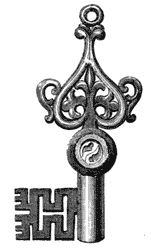 Fig. 10. |
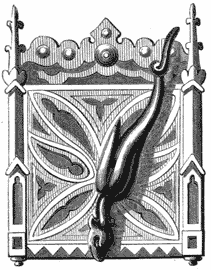 Fig. 11. |
When the Dukes of Urbino, dazzled with the brilliancy of the Moorish potters, had determined to rival their workmanship in[12] manufactories upon their own principality, the so-called Raffaelle-ware soon afterwards fascinated the Italians, by the quaint design and beautiful colour of the dishes and vases there produced. Though popularly named after the great painter, it was unlikely that he had aught to do therewith; but his designs were occasionally adapted to its use by the workmen. The circular plateau (Fig. 12) is a good example of the bold character and vigour of effect occasionally produced in these works.
Wood panelling we have already alluded to, and the large amount of decoration it occasionally displayed. Fig. 13 is a beautiful instance of the grace that characterised the style known as the Flamboyant, from the flowing or flame-like curve adopted for the leading lines. In this instance they are happily blended with[13] the earlier Gothic cusps, and the quaint ivy-leaves that spring easily out of the severer lines. The ease with which heraldry may be introduced in the design, gave it a peculiar charm to our ancestors; in this instance the shields bear the sacred monograms—a purpose to which they were very commonly devoted in the church; sometimes being further enriched with religious emblems, as terse and striking as the heraldic ones we have given in a previous page.
 Fig. 14. |
 Fig. 15. |
We give two small drawings of cabinet-handles in Figs. 14 and 15, part of the elaborate fittings of a piece of furniture which[14] occupied the place of honour in the state-rooms of the wealthy, and upon which the art of the day was generally lavished with a most liberal hand. Ivory, ebony, and the rarest woods were employed in their construction, occasionally plaques of lapis lazuli, or coloured marbles, were used for the panels; ultimately the whole surface became an encrusted mosaic of figures, birds, and flowers, in coloured wood and stone, occasionally framed in the precious metals. The gorgeous taste of Louis Quatorze excited the fancy of the ébenistes of his court to the most costly invention. Furniture inlaid with engraved metal-work, or embossed with coloured stones, oppressed the sense of utility; and when tables, chairs, and picture-frames were made of silver, chased and overloaded with the scroll-work he so abundantly patronised, common sense seems to have yielded its place to mere display. Despite of the costly character of such works, and their destination as the decoration of a palace, they are positive vulgarisms, and we feel little regret when we read in history of the disastrous wars at the close of the king’s career, which obliged him to melt down the silver furniture of Versailles, and convert it into cash for the payment of his soldiers.
There was more honesty of purpose in the old art-workers, who never swerved from a leading principle. Hence the educated eye can at once detect a piece of genuine old decorative furniture from a Wardour Street made-up bit of pseudo-imitation. It must[15] be borne in mind that specimens of genuine old work are by no means common; the abundance which this street and other localities can supply to order by the cart-load, are ingenious adaptations of fragments of old work pieced and placed together for a general effect; but which are sometimes ludicrous, from the mixture of bits of all ages and style in one cabinet or sideboard. Some twenty years ago the city of Rouen was a mine of wealth to furniture makers. The elaborately carved panels and chimney-pieces in the stately houses of the old Norman capital, were converted into all kinds of articles for domestic display. The progress of “improvement,” as well as the slower process of decay, have cleared that place of many of its fine features of domestic architecture; but its beauties have had an enduring memento in the curious volumes by the artist Langlois, of Pont-de-l’Arche, completed after his death by M. Delaquérrière. In this work every ancient building is carefully noted and described, throughout every street of the city; and the finest or most curious examples engraved with a minute truthfulness for which Langlois was justly celebrated; and which drew forth the plaudits of Dr. Dibdin, in the sumptuous work devoted to his foreign tour in search of rarities.15-*
We propose presently to follow the Doctor in his investigation of old books, and exhibit some few of the enrichments that artist and engraver gave to the written or printed volumes which passed[16] from their hands; at the same time we shall endeavour to take a more general survey of the adaptation of art to works of ordinary use.
The quaint manner in which letters were sometimes braced together may be seen in Fig. 16. Occasionally, a name thus formed in monogram would require much ingenuity to unravel, inasmuch as the entire letters made but one interlaced and closely compacted group, each limb or portion of a letter helping also to form part of another. In the hospital founded at Edinburgh by the famous goldsmith, George Heriot,—the favourite goldsmith and jeweller of James I., a monarch who fully appreciated his art,[17]—the name of “Jingling Geordie,” as his majesty playfully called him, is sculptured in such a group, which appears at first sight an enigma few could unravel; indeed, without knowing what letters to look for, and how to arrange them, it is a chance if they would be arranged correctly. Such a mode of marking would, however, have its advantages, for it would enable those who were in the secret to unravel the mystery of the true proprietorship of any valuable article unfairly abstracted. The shields in Fig. 13 are filled with monograms less elaborate, but bearing a sufficient affinity to those alluded to, to aid in understanding the rest.

We owe the term illumination, as applied to the decoration of old manuscripts, to the mediæval Latin name of the artist himself, alluminor, the root of our English word limner, and of the French word enlumineur, one who colours or paints upon paper or parchment, giving light and ornament to letters and figures. The brilliancy and beauty of much of this ancient art are marvellous to look upon, but the names of few of the patient artists, who devoted their lives to book illustration, have descended to us. There are, however, one or two names well-known to us, a Julio Clovio and a Girolamo da Libri (Jerome Veronese), affording a sufficient warrant of the high-class minds who honoured their art by honouring literature. There can be no greater pleasure than in turning over the matchless pages of these old volumes, and seeing them reveal the passages of the poet or romancist, as understood by the men of the Middle Ages, to whom they were addressed, or giving us pictures of life and manners of which we possess no other record. Their value as adjuncts to books, when simply decorative, is now very generally acknowledged; and the ladies of the present day rival the cloistered recluses in labouring, like them, to enrich a cherished volume. It is, however, the art of the fourteenth and fifteenth centuries that is now especially imitated, and the reason is to be found in its[19] showy elaboration of design and colour. There is an earlier style that presents strong claims to attention, that of the two preceding centuries, specimens of which are given in Figs. 17-21. In them will be noticed the Orientalism that occasionally prevails, and shows its Byzantine parentage; a trace of the Greek volute and acanthus leaf is visible in Figs. 20 and 21; in the others we seem to look on Turkish design. The applicability of such fragments of ornament is manifold.
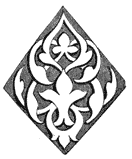 Fig. 17. |
 Fig. 18. |
 Fig. 20. |
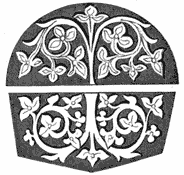 Fig. 19. |
 Fig. 21. |
When the art of engraving aided the press in producing works [20]of a decorative order, we occasionally turn over pages in which the master-minds of the day taxed their powers of invention. The old wood-engravers were supplied by designers with drawings of the best class, and very quaint and original are the ornaments which embellish the books of the sixteenth and seventeenth centuries,—particularly such as were published in Germany, or at Lyons, the latter city being then most eminent for the taste and beauty of its illustrated volumes, the former for a bolder but quainter character of art. There are useful hints to be had in the pages of all, for such as would avail themselves of[21] minor book-ornament. To render our meaning more clear, we select a series of scrolls (Figs. 22-25) for inscriptions from German books, of the early part of the sixteenth century, and which might be readily and usefully adapted to modern exigencies, when dates or mottoes are required either by the painter or sculptor. Ornamental frameworks for inscriptions abound in old books, and are not unfrequently of striking design and peculiar elaboration; we give an example in Fig. 26, from a volume dated 1593, as an excellent specimen of this particular branch of design. Such[22] tablets not unfrequently headed the first page of a volume, and received in the centre the title of the book. The wood-engraver is thus the legitimate successor of the older illuminator.
A large demand was made on the imaginative faculties of the designers of that day by the metal-workers, the gold and silversmiths, the jewellers, and all connected with such decorative manufactures as the luxury of wealth and taste calls into exertion. The name of Cellini stands prominently forth as the inventor and fabricator of much that was remarkable; the pages of his singular autobiography detail the peculiar beauty of many of his designs; the Viennese collection still boasts some of the finest of the works so described, particularly the golden salt-cellar he made for Francis I. of France. The high art which he brought to bear on design applied to jewellery was followed by other artist-workmen, such as Stephanus of Paris, and Jamnitzer of Nuremberg. The metal-workers of the latter city, and of Augsburg, had a universal reputation at the close of the sixteenth century for their jewellery and plate, particularly the latter. They kept in employ the best designers of the day, and such men as Hans Holbein, Albert Aldegræf, Virgilius Solis, and a host known as the “little masters,” supplied the demand with apparent abundance, but it could only be satisfied by the multiplication of these designs by means of the engraver’s art. Hence we have at this period, and the early part of the seventeenth century, an abundance of small engravings, comprising a vast variety of designs for all articles of ornament; and from them we have selected, in Figs. 27 and 28, two specimens of those intended to be used in the manufacture of the[23] pendent jewels, then so commonly worn on the breast of rich ladies. These jewels were sometimes elaborately modelled with scriptural and other scenes in their centre, chased in gold, enriched by enamel colours, and resplendent with jewels. The famed “Grüne Gewölbe” at Dresden have many fine examples, in the Louvre are others, and some few of a good kind are to be seen in the Museum at South Kensington. The portraits of the age of Francis I. and our Queen Elizabeth, frequently represent ladies in a superfluity of jewellery, of a most elaborate character. The portrait of Mary, Queen of Scots, in our National Portrait Gallery, is loaded with chains, brooches, and pendants, enough to stock the show-case of a modern manufacturer. This love of elaborate jewellery was a positive mania with many nobles in the olden[24] time. James I. was childishly fond of such trinkets, and most portraits represent the king with hat-bands of jewels, or sprays of jewellery at their sides. His letters to his favourite, Buckingham, are often full of details of the jewels in which his majesty delighted.
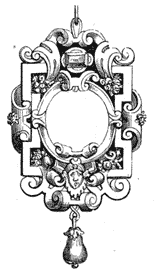 Fig. 27. |
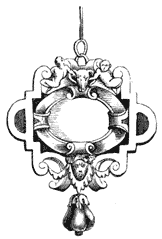 Fig. 28. |
Perhaps no article of personal ornament has exhibited a greater variety of design and decorative enrichment than the cross. It has at once been made an embellishment and a badge of faith. We select in Fig. 29 one of singular elaboration and beauty, now the property of Lady Londesborough. It is a work[25] of the early part of the sixteenth century; the ground is of frosted gold, upon which is a foliated ornament in cloissonné enamel of various colours. It is also enriched with pearl and crystal; the lower part of this cross is furnished with a loop, from which a jewel of value might be suspended.
By way of curious contrast, as well as to show the style of various ages in the article of necklaces, we give, in Figs. 30 and 31, two examples of widely different eras. The upper one is that of a Roman lady, whose entire collection of jewellery was accidentally discovered at Lyons, in 1841, by some workmen who were excavating the southern side of the heights of Fourvières, on[26] the opposite side of the Seine. From an inscribed ring and some coins deposited in the jewel-box, the lady appears to have lived in the time of the Emperor Severus, and to have been the wife of one of the wealthy traders, who then, as now, were enriched by the traffic of the Rhone. The necklace we engrave is of gold, set with pearls and emeralds; the cubical beads are cut in lapis lazuli, as are the pendants which hang from others. This love of pendent ornament was common to all antique necklaces, from the days of ancient Greece to the end of the sixteenth century. Our second specimen is an illustration of this: it is copied from the portrait of a lady (bearing date 1593), and composed of a series of enamelled plaques, with jewels inserted, connected with each other by an ornamental chain.
We have already alluded to the constant demand on the inventive faculty of the art-workman for articles of all kinds in the olden times; nothing was thought unworthy his attention. We give a selection of articles of ordinary use which have received a considerable amount of decorative enrichment. The spur-rowels (Figs. 32 and 33), from the collection of M. Sauvageot, of Paris, are remarkable proofs of the faculty of invention possessed by the ancient armourers. So simple a thing as a spur-rowel, in[27] our days of utilitarianism, would seem to be incapable of variety, or at least unworthy to receive much attention. It was not so in past times, when workmen even delighted to adorn their own tools. We engrave an armourer’s hammer (Figs. 34 and 35), from the collection of Lord Londesborough, which has received an amount of enrichment of a very varied character. The animals on one side, and in foliated scrolls, connect the design across the summit of the implement with a totally new composition on the opposite side. We would not insist on any part of the design as remarkable for[28] high character; it is simply given as an instance of the love of decoration so prevalent in the sixteenth century.
The highly-enriched knocker and door-handle (Fig. 36) were sketched from the original, on one of the ancient houses of the quaint city of Nuremberg. The bell-pull beside it (Fig. 37) is also from the same locality. There is probably no town in Germany where more artistic old iron-work is to be seen than in this place,—once the richest of trading communities, when Albert Durer flourished within its walls, and the Emperor Maximilian held royal state in its old castle. To all who would realise the chivalric days of the old German Empire, we would say, “Go to Nuremberg.”
The bellows of carved chestnut-wood (Fig. 39) is in the possession of the Count de Courval. It is of simpler and “severer” design than common,[29] inasmuch as it was usual to enrich these useful domestic implements with an abundance of elaborate designs, and fill their centres with scenes from sacred and profane history.
When ladies delighted in lace-working, and in starching and preparing their produce most carefully, they showed their good housewifery in washing and ironing it with their own hands. It was gallantry on the part of their spouses to make befitting presents of all things requisite for their labours, and worthy their use. The box-iron we engrave in Fig. 39 is one which has thus been given; it bears the monogram of the fair lady who originally owned it, engraved within a “true lover’s knot.” The cupidons of the handle ending in flowers may be an emblem of Love and Hymen, forming an appropriate embellishment.
Applicability is the most useful characteristic of the style popularly known as the Renaissance; it is confined to no one branch of art, but is capable of extension to all, from the most delicate work of the jeweller to the boldest scroll-ornament adopted by the sculptor in wood or stone. The Loggie of the Vatican is the best original example of the style as perfected by Raffaelle and his scholars, and applied to wall-painting. It was a free rendering of the antique fresco ornament then just discovered in the Baths of Petus, where extensive excavations were undertaken in 1506, under the superintendence of the Papal authorities. The classic forms were “severer” than those in use by the artists who resuscitated the style, and were somewhat overlaid with ornament. The details of Raffaelle’s own work will not always bear adverse criticism, inasmuch as there are heterogeneous features introduced occasionally, which are not visible in the purer style of antiquity. As the fashion for this decoration travelled northward, it increased in freedom from classic rule, and more completely deserved the term “grotesque,” which it occasionally received, a term derived from grotte, an underground room of the ancient baths, and which we now use chiefly in the sense of a ludicrous composition. Such compositions were not unfrequent on the walls of Greek and Roman buildings; and the[31] German and Flemish artists, with a nationally characteristic love of whimsical design, occasionally ran riot in invention, having no rule beyond individual caprice. This unfortunate position offering too great a licence to mere whimsicality, was felt in ancient as well as in modern times. Pliny objected, on the grounds of false or incongruous taste, to the arabesques of Pompeii, though they approached nearer to the Greek model; and Vitruvius, with that purity of taste which was his grand characteristic, endorsed the opinion, and enforced it in his teaching. We are often in error when we blindly admire, or unhesitatingly adopt, the works of the ancients as perfection. In Athens and Rome in past time, as in Paris and London at present, we may meet with instances of bad taste; for vulgarity belongs to no age or station, and may be visible in the costly decoration of a rich mansion, whose owner is uneducated in art, and insists on having only what he comprehends.
The decadence of the better-class Renaissance design was a natural consequence of the licence its features might assume, and in the progress of the sixteenth century it became thoroughly vitiated. The troubles which distracted Europe in the later part of that century, and which led to the devastating wars and revolutions of the earlier part of the following one, completed the debasement of art-workmanship. Louis XIV. had the glory, such as it was, of its resuscitation; but his taste was merely that of an over-wealthy display, which not unfrequently lapses into positive vulgarisms. The style known distinctively by the name of this monarch—with all its heterogeneous elements, its scrolls[32] of the most obtrusive form, fixed to ornament having no proper cohesion, and overlaid with festoons of flowers and fruit—is more remarkable for the oppressive ostentation which was the characteristic of the monarch and his age, than for good taste or real elegance. What a very little exaggeration could make of this style may be seen in the productions of the era of his successor, and which the Italians stigmatised by the term rococo.
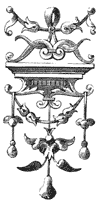 Fig. 40. |
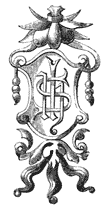 Fig. 41. |
The examples of Renaissance given in our pages exhibit a fair average of its applicability. The pendent ornament (Fig. 40) includes details adopted by jewellers. The shield, with the sacred monogram (Fig. 41), is such as appeared in wood-panelling. The handle (Fig. 42) exhibits as much freedom of design as the style could admit; it is quaint and peculiar, but not without elegance in the mode of bringing the classic dolphin within the scope of the composition.
The distinctive features of the style may be more readily com[33]prehended by contrasting it with a few specimens of the so-called “Gothic style,” a style which possesses the strongest original features, and one which will yield to none in peculiar beauty and applicability. We give two examples—the one German, the other French; they are both wood panel, filled with tracery which bears the distinctive characteristics of the two schools. The German (Fig. 43) is remarkable for the sudden termination of its flowing lines, which occasionally gives to the carving of the epoch an appearance of having been suddenly broken, or chopped off, in parts. At Nuremberg this peculiarity is very observable; our specimen is selected from the church at Rottweil, in the Black Forest, which bears the date of 1340. The French (Fig. 44) is a favourable example of the Flamboyant style, which gave freedom to the mediæval rigidity of the Gothic, and paved the way for the ready adoption of the style of Francis I., which was based on that of the Italians.
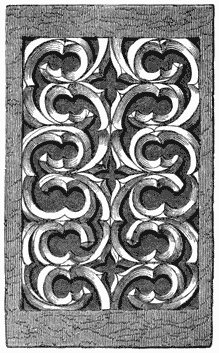 Fig. 43. |
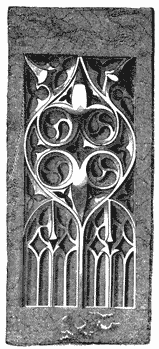 Fig. 44. |
Figs. 45 and 47 display one peculiarity in this northern adaptation—the introduction of busts, in high relief, in central medallions. It is sometimes introduced so unscrupulously in the carved panelling of Elizabethan mansions, that it has almost the effect of a row of wooden dolls peeping through shutters. The latter of the two examples may be received as one of the best of its kind, exhibiting the utmost enrichment of which the style was generally capable, and as few heterogeneous features, though here they are not entirely absent. By way of useful contrast, we give in Fig. 48,[35] a very pure specimen of a panel in Italian workmanship, from a tomb of the sixteenth century, in the church of the Ara Cœli, at Rome. The flow of line here is exceedingly graceful; the whole of the details are characterised by a delicacy unknown to the artists of Germany and Flanders; the torches and volutes point unmistakably to the classic origin of the whole.
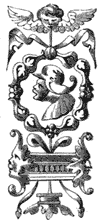 Fig. 45. |
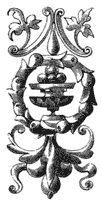 Fig. 46. |
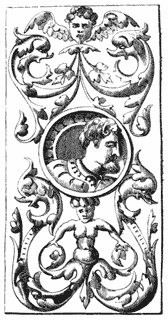 Fig. 47. |
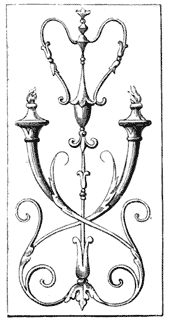 Fig. 48. |
It was not natural to the Roman people ever to forget their great art-works of antiquity; the influence of the “departed spirits” still “ruled them from their urns,” as Byron truthfully expresses it. The artists of Greece and Rome based their compositions on the unvarying truth of nature; and though the barbaric mind might bear sway for awhile, it could not triumph but through ignorance. Rome is now the great art-teacher only because it is the conservator of its ancient relics; and they have had their influence undiminished from the days of Raffaelle and[36] Michael Angelo. There are many pleasing bits of design in the antique city, that show the classic source of inspiration from which their inventors obtained them. The boy and dolphins, forming the pleasing domestic fountain we engrave in Fig. 51, is an evident instance of the influence of antique taste. The abundant supply of water was the grand feature of the Rome of the Cæsars, as it still is of the Rome of the Popes; and the liberality with which every house is served has frequently induced the owners of large mansions to decorate one corner of their external walls with a fountain, at which all wayfarers may be supplied. In a[37] recess of the lowermost story of one of the great palazzi which line the principal street of Rome, “the Corso,” our second specimen (Fig. 52) is placed. It represents a wine-merchant liberally pouring from the bung-hole of his barrel its inexhaustible contents. On great festas in the olden time it was not unusual to make public fountains run with wine for an hour or two, and this may have occurred with the one engraved; it is a work of the latter part of the sixteenth century, when luxury reigned in Rome. As a design it is exceedingly simple and appropriate, reminding, by its quaintness, of German rather than Italian[38] design. The old Teutonic cities present very many striking inventions of the kind: and the promoters and designers of our drinking fountains may obtain good and useful hints from that quarter.
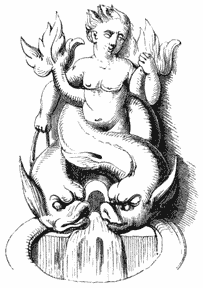 Fig. 51. |
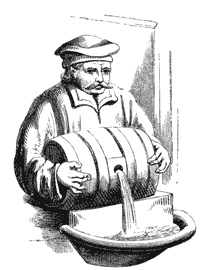 Fig. 52. |
Our street architecture has shown recently a greater freedom of design, and range of study, than was ever exhibited before. We may owe this, in some degree, to the excellent works on the domestic and palatial edifices of the Low Countries, which have issued from the press, and have vindicated the true character of the great mediæval builders. Germany—taking the term for the nation in its widest sense—can show in its antique cities a vast variety of fancy in architecture and its ornamental details. Each[39] city may be made a profitable residence for the study of a young architect; and the superior knowledge of the leading principles of mediæval art, now exhibited in their adaptation of the style to home events, is a clear proof that the fact has been felt and acted on. The “infinite variety” of the old decorator is everywhere apparent, and the play he gave to his invention. We give in Fig. 53, as one instance, the ornamental mouldings of the Chapel of St. Nicholas, in the Cathedral of Aix; in this instance the rigidity of the rule which enforces geometric form to the whole is softened by the introduction of the cable moulding to a portion thereof, with singularly good effect. It is a work executed under the rule of Armand de Hesse, Archbishop of Cologne, and Provost of Aix, probably about 1480.
The Gothic, therefore, of the best era, was by no means the[40] stiff and monotonous style imagined by those who only know its details by the remains of our own ecclesiastical buildings; not that we infer them to be without much freedom and beauty occasionally, as in the Percy shrine at Beverley Minster, or the tomb of Aylmer de Valence, in Westminster Abbey. But we have fewer domestic buildings of a florid Gothic style than are to be found abroad, and the artists who designed for that style delighted in new ideas. It is even visible in the works of their painters and engravers: thus the tracery over the doorway in Durer’s print of[41] “The Crucifixion,” one of his series of the life of the Virgin, while it conforms to the leading principle of architectural design, is composed of branches and leaves which flow with a freedom belonging more to the painter than the architect. Similar instances abound in old pictures.
The foliation of German work was generally crisp and full of convolutions in its minor features, though the leading lines were boldly conceived. We give an example from a panel carved in wood, in the Cathedral of Stuttgard, a work of the middle of the fifteenth century. It is almost a return to the old acanthus leaf, and so completes a cycle of fine art.
Brief as the review has necessarily been of the decorative arts adorning life throughout the centuries which have passed in rapid succession before us, they have taught two great facts—the beauty of art as an adjunct to the most ordinary demands of domesticity, and the value of the study of the varied arts of past ages as an addition to the requirements of our own. “Ever changing, ever new,” may be the lesson derived from the investigation of any epoch. How much then may be obtained from a general review of all! Seroux d’Agincourt deduced a history of art from its monuments;41-* and men of the present day have the advantage of all that the world has produced brought easily, by aid of the burin and the printing-press, to their own firesides. We are evidently less original in idea than our ancestors, from the association of their labours with our thought; but we may yet live in the hope of[42] seeing some new and peculiar feature in the progress of modern decorative art obtained by retrospective glances at the past.
It is to the duty of thus learning from the past, we desire to direct the attention of our readers. Slavishly to copy, or systematically to imitate, are evils scarcely less reprehensible than to neglect them altogether; but frequent study of the great masters in any art is indispensable to those who would excel. It is to the absence of such study that we may trace most of the defects of the British artisan. Unhappily, he seldom either examines, reads, or thinks; generally he is content to work, like a horse in a mill, pursuing the same monotonous round, producing only that which has been produced before, without alteration, and without improvement. Until within the last few years, this defect could hardly have been urged against him as an offence. His employers did not require advancement, seldom encouraged intelligent workmen, and rather preferred the mere machine who was content to do no more than his fathers had done, and who looked upon new inventions as costly whims or expensive absurdities. There were exceptions—glorious exceptions; but the rule was, undoubtedly, as we have stated.
This deplorable disadvantage exists no longer; in nearly every town in the kingdom, of any size, there is some institution where knowledge may be obtained readily and cheaply. The societies in connection with the Department of Science and Art now abound with competent masters and teachers, and all the appliances of instruction.
The South Kensington Museum is alone a mine of wealth.[43] Not only are the artisans enabled to resort to it freely, but every possible inducement is held out to them to do so; the superintendents there almost go into the highways to “compel them to come in.” There is no calling of any sort or kind that may not be educated here; the masters, as well as the workmen, of all trades may here receive the education, “free of charge,” which no sum of money could have procured for them twenty years ago. Ignorance, nowadays, is, therefore, totally without excuse.
No doubt the seed that has been so extensively and abundantly planted is growing rapidly up; in some places it has borne fruit. It is utterly impossible that the existing race of art-workmen, and their successors “rising up,” can be ignorant as were their predecessors. If they use their eyes merely, and permit their minds to remain blanks, they must improve. There is no street in London now that will not teach them something; every shop window contains a lesson; and it requires no very large observation to perceive advancement in every class of British art-manufacture—not, certainly, so marked as to produce content, but exhibiting ample proof that we are progressing in the right direction, and leading to the conclusion that at no very distant period we shall not have to incur the reproach that our artisans are worse educated than those of Germany, Belgium, and France. These remarks result from the brief insight we have given in these pages into the rich volumes which the past has filled for the use of the present. The books to which we have resorted, and the places in which we have sought for rarities, are open to most of those who desire to examine them, and who will find an expendi[44]ture of time and labour to any amount, be it large or small, produce an extent of remuneration of which the searcher will have no idea until he begins to gather in the profit he has made.
We had intended to supply a list of books, to be obtained either at the British Museum or the Museum at South Kensington, to which we desire to direct the attention of our art-producers and art-workmen; but thus to occupy space is needless. The requisite information can be easily procured: any of the superintendents, at either place, will gladly direct the searcher, on receiving information as to his wants. Moreover, it is permitted, under certain restrictions, to take sketches of engravings or drawings, and from objects exhibited; aids to do this readily present themselves.
Books, however, should be regarded only as auxiliaries; they will supply in abundance material for suggestion or adaptation; although, as we have already observed, “slavishly to copy, or systematically to imitate,” are evils to be avoided.

15-* “Biographical, Antiquarian, and Picturesque Tour in France and Germany.” London, 1821. 3 vols.
41-* “Histoire de l’Art par les Monumens, depuis sa Décadence au IVe. Siècle jusqu’à son Renouvellement au XVIe.”
Among the quaint terms in art to which definite meanings are attached, but which do not in themselves convey any such definite construction, we may class the term grotesque. The term grotesque was first applied as a generic appellation in the latter part of the fifteenth century, when the “grottoes,” or baths of ancient Rome, and the lowermost apartments of houses then exhumed, exhibited whimsically designed wall-decorations, which attracted the attention of Raffaelle and other artists, who resuscitated and modified the style; adopting it for the famous Loggie of the Vatican and for garden pavilions or grottoes.
We may safely go back to the earliest era in art for the origin of the style, if, indeed, the grotesque does not so intimately connect itself with the primeval art of all countries as to be almost inseparable. Indeed, it requires a considerable amount of classical education to see seriously the meaning, that ancient artists desired in all gravity to express, in works which now excite a smile by their inherent comicality. Hence the antiquary[48] may be occasionally ruffled by the remarks of some irreverent spectator, on a work which the former gravely contemplates, because he feels the design of its maker, and is familiar with the antique mode of expression. Thus the early Greek figures of Minerva, whether statues or upon coins, have occasionally an irresistibly ludicrous expression: but, as art improved, this expression softened, and ultimately disappeared, the grotesque element taking a more positive form and walk of its own.
In that cradle of art and science, the ancient land of Egypt, we shall find grotesque art flourishing in various forms. Their artists did not scruple to decorate the walls of tombs with pictures of real life, in which comic satire often peeps forth amid the gravest surroundings. Thus we find representations of persons at a social gathering evidently the worse for wine-drinking; or the solemn procession of the funeral boats interrupted by a ludicrous delineation of the “fouling” or upsetting one unlucky boat and its crew, which had drifted in the way; while the most impressive of all scenes, the final judgment of the soul before Osiris, is depicted at Thebes with the grotesque termination of the forced return of a wicked soul to earth, under the form of a pig, in a boat rowed by a couple of monkeys. In the British Museum is a singular papyrus, upon which are drawn figures of animals performing the actions of mankind; and among the large number of antiquities which swell the Egyptian galleries, there are many that exhibit the partiality of this ancient people for the grotesque.
Our first examples consist of a group of wooden boxes and spoons, all of whimsical form, and selected from the[49] great work by Sir John Gardner Wilkinson on the manners and customs of the ancient Egyptians.49-* They were formed to contain cosmetics of divers kinds, and served to deck the dressing-table, or a lady’s boudoir. They are carved in various ways, and loaded with ornamental devices in relief, sometimes representing the favourite lotus-flower, with its buds and stalks, or a goose, gazelle, fox, or other animal. Fig. 55 is a small box, made in the form of a goose; and Fig. 56, also in the shape of the same bird, dressed for the cook. The spoon which[50] succeeds this, Fig. 57, takes the form of the cartouche, or oval, in which royal names were inscribed, and is held forth by a female figure of graceful proportions. Fig. 58 is a still more grotesque combination; a hand holds forth a shell, the arm being elongated and attenuated according to the exigencies of the design, and terminating in the head of a goose. The abundance of quaint fancy that may be lavished on so simple a thing as a spoon cannot be better illustrated than it has been by an American author, who published, in New York, in 1845, an illustrated octavo volume on the history of “The Spoon: Primitive, Egyptian, Roman, Mediæval, and Modern.” Speaking of these antique Egyptian specimens, he says,—“In these forms we have the turns of thought of old artists; nay, casts of the very thoughts themselves. We fancy we can almost see a Theban spoonmaker’s face brighten up as the image of a new pattern crossed his mind; behold him sketch it on papyrus, and watch every movement of his chisel or graver as he gradually embodied the thought, and published it in one of the forms portrayed on these pages—securing an accession of customers and a corresponding reward in an increase of profit. We take it for granted that piratical artisans were not permitted to pounce on every popular invention which the wit of another brought forth. Had there been no checks to unprincipled usurpers of other men’s productions, the energies of inventors would have been paralysed, and the arts could hardly have attained the perfection they did among some of that famous people of old.”
The graceful head and neck of the swan formed for many[51] centuries the favourite termination for the handles of simpula, or ladles. The Greeks and Romans adopted it, as they freely did grotesque art in general; and the walls of Pompeii and Herculaneum exhibit it in untrammelled style; while many articles of ornament and use were constructed in the most whimsical taste. We must restrict ourselves to three specimens of Roman works, as many hundreds might be readily brought together from public museums. Our group consists of two clasp-knives and a lamp. The knife, Fig. 59, was found at Arles, in the south of France; the handle is of bone, and has been rudely fashioned into the human form: the second example, Fig. 60, is of bronze, and represents a[52] canis venati, of the greyhound species, catching a hare; the design is perforated, so that the steel blade shows through it. It was found within the bounds of the Roman station of Reculver, in Kent; another of similar design was found at Hadstock, in Essex: nor are these solitary examples of what appears to have been a popular design in Britain. The superiority of the British hunting dogs has been celebrated by Roman writers, and induced their frequent exportation to the capital of the world. The lamp, with the quaint head of an ivy-wreathed satyr, Fig. 61, was found in the bed of the Thames, while removing the foundations of old London Bridge. The protruding mouth of this very grotesque design holds forth the lighted wick. In nothing more than in lamps did the quaint imaginings of the Roman artists take the wildest license.
When the successful incursions of northern barbarism had quenched the light of classic art, the struggle made by such artists as the Goths had at command to embody the ideas of power or grace they wished to indicate, were often as absurd as the work of a modern child. Hence the grotesque is an inseparable ingredient in their designs, often quite accidental, and frequently in express contradiction to the intention of the designer, who imagined in all seriousness many scenes that now only excite a smile. A strong sense of the ludicrous was, however, felt by mediæval men, and embodied in the art-works they have left for our contemplation. With it was combined a relish for satire of a practical kind. A very good and amusing instance is given in Fig. 62, which is copied from a carved corner-post of an old house[53] in Lower Brook Street, Ipswich. It depicts the old popular legend of the Fox and Geese, the latter attracted toward Reynard by his apparent innocence and sanctity, as he reads a homily from a lectern, and meeting the reward of their foolish trustfulness, in the fattest of their number being carried off by the crafty fox. Both incidents are, as usual with these ancient designers, represented side by side on different angles of the post.
Our next engraving, Fig. 63, is a very striking specimen of grotesque design in ironwork of the fourteenth century. It is a door handle from a church in the High Street of Gloucester, and a more extraordinary admixture of incongruous details could[54] not very readily be imagined. The ring hangs from the neck of a monster with a human head having ass’s ears, the neck is snake-like, bat’s wings are upon the shoulders, the paws are those of a wolf. To the body is conjoined a grotesque head with lolling tongue, the head wrapped in a close hood. Grotesque design, for the reason already stated, frequently appears in the details of church architecture and furniture during the Middle Ages, particularly from the thirteenth to the seventeenth century. The capital of a column was the favourite place for the indulgence of the mason’s taste in caricature; the misereres, or folding scats of the choir, for that of the wood-carver. It is impossible to[55] conceive anything more droll than many of the scenes depicted on these ancient benches. Emblematic pictures of the months, secular games of all kinds, or illustrations of popular legends, frequently appeared; but as frequently satirical and grotesque scenes, often bordering on positive indelicacy; and occasionally satires on the clerical character, which can be only understood when we remember the strength of the odium theologicum, and how completely the well-established regular clergy disliked the wandering barefooted friars, who mixed with the people free of all clerical pretence, and induced unpleasant comparison with the ostentatious pride of the greater dignitaries. The Franciscans were in this way especially obnoxious, and between them and the well-established Benedictines an incessant feud existed. The tone of feeling that pervaded the middle and humbler classes[56] found a mouth-piece in that curious satire, the Vision of Piers Ploughman, than which Luther never spoke plainer.
One very prevailing form in early Gothic design was that of the mythic dragon, whose winged body and convoluted tail were easily and happily adapted to mix with the foliage or other decorative enrichments these artists chose to adopt. Hence we find no creature more common in early art than this purely fanciful one, rendered still more fanciful by grotesque combination. The bosses from which spring the vaulted ribs of Wells Cathedral furnish us with the instance engraved in Fig. 64; here two dragons twine round a bunch of foliage, biting each other’s tails.
Domestic utensils were often made to represent living things; the tendency to convert a globular vase or jug into a huge head or a fat figure, has been common to all people in all ages. The[57] highly civilised Greeks indulged the whim, and our own potters continue it. In the fourteenth and fifteenth centuries, vessels for liquids were often constructed of bronze, taking the form of lions, or mounted knights on horseback, of which specimens may be seen in our British Museum. The manufacturers of earthenware imitated these at a cheaper rate, and we engrave (Fig. 65) one example of their skill, the original being rudely coloured with a blue and yellow glaze on the surface of the brown clay which forms the body.
The door-knocker (Fig. 66), whimsically constructed in form of a human leg, the heel hitting against the door, is also a work of the fourteenth century; it is affixed to a house in the Rue des Conseils, at Auxerre, and is very characteristic in execution.
Our selection (Fig. 67) comprises a most rare domestic antiquity, to which a date cannot so readily be assigned, but which cannot be more modern than the sixteenth century, and may be older. It is a toasting-fork in the form of a dog, to whose breast a ring is attached for holding a plate. It is entirely constructed of wrought-iron, the body cut from a flat sheet of metal. It was found in clearing away the foundations of one of the oldest houses in Westminster. The tail of the dog forms a convenient handle; to the front foot a cross bar is appended to preserve its due equilibrium.
Grotesque design was adopted by the artists who decorated books from the very earliest time. The margins of ancient manuscripts are often enriched with whimsical compositions, as well as with flowing designs of much grace and beauty. Occasionally the two styles are very happily combined, and a humorous adjunct gives piquancy to a scholastic composition. The early printed books often adopted a similar style in art, and we give two curious specimens. The letter F, whimsically composed of two figures of minstrels (Fig. 68), one playing the trumpet and the other the tabor, is copied from an alphabet, entirely composed in this manner, and now preserved in the British Museum; it bears no date, but the late Mr. William Young Ottley, keeper of the prints there, was of opinion that it was executed about the middle of the fifteenth century. This quaint alphabet has been repeated by the artists of each succeeding generation, with variations to[59] adapt the letters to the costume or habit of each era; but in this unique series we seem to see the origin of them all.
One of the most singular books ever issued from the press, was published about the same period; it is known as the Ars Memorandi.59-* As its title imports, it was intended to assist the memory in retaining the contents of the Gospels in the New Testament. This is done by making the body of the design of the emblematic figure indicative of each, either the eagle, angel, ox, or lion; in combination with this figure are many small groups,[60] symbolic of the contents of the various chapters. The copy we give (Fig. 69), from the second print devoted to St. Luke’s Gospel, will make the plan of this singular picture-book clearer. The winged bull is spread out as a base to the group of minor emblems, upon its head rests a funeral bier, and in front of it a pot of ointment; the numeral 7 alludes to the chapter, the principal contents being thus called to memory. The bier alludes to the Saviour’s miraculous restoration to life of the widow’s son, whom He met carried out on a bier as He entered the city of Nain; the ointment pot alludes to the anointing of His feet by Mary Magdalene. The bag upon which the figure 8 is placed, indicates the fable of the[61] sower, it is the seed-bag of the husbandman; the boat alludes to the passage of the Lake when the Saviour quelled the storm. The singular group of emblems in the centre of the figure indicates—the power given to the disciples by the key; the Saviour in his transfiguration, by the sun; and the miraculous multiplication of the five loaves; as narrated in the 9th chapter of St. Luke. The following chapter has its chief contents noted by the scroll indicative of the law; the sword which wounded the traveller from Jerusalem whom the good Samaritan aided; and the figure of Mary commended by Jesus. No. 11 is typical of the casting out a devil whose back is depicted broken: and No. 12, of the teaching of that chapter in the Gospel; for here the heart is set upon a treasure-chest, an act we are especially taught to avoid.
These great treasure-chests were important pieces of furniture in ancient houses, and were generally placed at the foot of the master’s bed for the greater safety; in them were packed the chief valuables he possessed, particularly the household plate. At a time when banking was unknown, property was converted into plate, as a most convenient mode of retaining it. Decorative plate increased the public state of its owner, was a portable thing, and could be easily hidden in time of danger, or pledged in time of want. Hence the nobility and gentry of the fourteenth and fifteenth centuries gave abundant employment to the goldsmith. Cellini, in his Memoirs, has noted many fine pieces of ornamental plate he was called upon to design and execute; and one of the finest still exists in the Kunst-Kammer, at Vienna—the golden salt-cellar he made for Francis I., of France. The “salt” was an[62] important piece of plate on all tables at this period, and to be placed above or below it, indicated the rank, or honour, done to any seated at the banquet. The large engraving (Fig. 70) delineates a very remarkable salt-cellar, being part of the collection of antique plate formed by the late Lord Londesborough. This curious example of the quaint designs of the old metal-workers, is considered to have been the work of one of the famous Augsburg goldsmiths at the latter part of the sixteenth century. It is a combination of metals, jewels, and rare shells in a singularly grotesque general design. The salt was placed in the large shell of the then rare pecten of the South Seas, which is edged with a silver-gilt rim chased in floriated ornament, and further enriched by garnets; to it is affixed the half-length figure of a lady, whose bosom is formed of the larger orange-coloured pecten, upon which a garnet is affixed to represent a brooch; a crystal forms the caul of the head-dress, another is placed below the waist. The large shell is supported by the tail of the whale on one side, and on the other by the serpent which twists around it; in this reptile’s head a turquoise is set, the eyes are formed of garnet, and the tongue of red onyx. The whole is of silver-gilt, and within the mouth is a small figure of Jonah, whose adventure is thus strangely mixed with the general design. The sea is quaintly indicated by the circular base, chased with figures of sea-monsters disporting in the waves. It would not be easy to select a more characteristic specimen of antique table-plate. The inventories of similar articles once possessed by the French king, Charles V., and his brother, the Duke of Anjou, King of Naples and Provence (preserved in the Royal Library,[63] Paris), give descriptive details of similar quaint pieces of art-manufacture, in which the most grotesque and heterogeneous[64] features are combined, and the work enriched by precious stones and enamels. Jules Labarte observes, “the artists of that period indulged in strange flights of fancy in designing plate for the table, they especially delighted in grotesque subjects: a ewer or a cup may often be seen in the shape of a man, animal, or flower, while a monstrous combination of several human figures serves to form the design of a vase.”
But quaint and fanciful as were the works of the Parisian goldsmiths, they were outdone by the grotesque designs of the German artificers. They invented drinking-cups of the strangest form, the whole animal kingdom, fabulous and real, birds, and sea-monsters, were constructed to hold liquids. A table laid out with an abundance of this strangely-designed plate, must have had a ludicrous effect. Many of their works, though costly in character, refined in execution, and thoroughly artistic in detail, are absolute caricatures. There is one in Lord Londesborough’s collection, and another in that of Baron Rothschild, made in the form of a bagpipe; the bag holds wine, and is supported on human feet; arms emerge from the sides and play on the chanter, which is elongated from the nose of a grotesque face, the hair a mass of foliage. Dozens of similar examples might be cited, of the most extraordinary invention, which the metal-workers of the seventeenth century particularly gave their imaginations licence to construct. Indeed, the German artists of that period seem to have had a spice of lunacy in their compositions, and the works of Breughel were rivalled and outdone by many others whose fancies were of most unearthly type. Salvator Rosa in Italy, and Callot in[65] France, occasionally depicted what their grotesque and mystic imaginings suggested, and Teniers gave the world witch-pictures; but for the wild and wondrous, Germany has always carried the palm from the rest of the world in art as in literature.
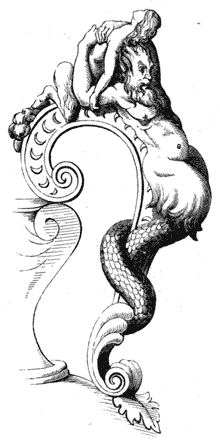 Fig. 71. |
 Fig. 72. |
We engrave a fine example of a vase handle (Fig. 71), apparently the work of an Italian goldsmith at the early part of the seventeenth century. The bold freedom of the design is utilised here by the upheaved figure grasped by the monster, and which gives hold and strength to the handle; the flowing character[67] throughout the composition accords well with the general curve of the vase to which it is affixed. There is a prevailing elegance in the Italian grotesque design which is not seen in that of other nations. The knife handle by Francisco Salviati, which we have also selected for engraving (Fig. 72), is a favourable example of this feeling; nothing can be more outré than the figure of the monster which crowns the design; yet for the purpose of utility, as a firm hold to the handle, it is unobjectionable; while the graceful convolutions of the neck, and the flow of line in the figure, combined with this monster, give a certain quaint grace to the design, which is further relieved by enriched foliage.
With one specimen of the later work of the silversmith, we take our leave of grotesque design as applied to art-manufacture; but that work is as whimsical as any we have hitherto seen. It is a pair of silver sugar-tongs (Fig. 73), evidently a work of the conclusion of the seventeenth or beginning of the eighteenth century. It is composed of the figure of Harlequin, who upholds two coiled serpents, forming handles; the body moves on a central pivot, fastened at the girdle, and the right arm and left leg move with the front, as do the others with the back of the body, which is formed by a double plate of silver, the junctures being ingeniously hidden by the chequers of the dress.
We have already had occasion to allude to the adoption of grotesque design in book illustrations, it is often seen in manuscripts, and abounds in early printed works. When wood engraving was extensively applied to the enrichment of the books which issued in abundance from the presses of Germany and France, the[68] head and tail-pieces of chapters gave great scope to the fancies of the artists of Frankfort and Lyons. The latter city became remarkable for the production of elegantly illustrated volumes, which have never been surpassed. Our concluding cuts represent one of these tail-pieces (Fig. 74), in which a fanciful mask combines with scroll-work; and a head-piece (Fig. 75), (one half only being given), where the grotesque element pervades the entire composition to an unusual extent, without an offensive feature. Yet it would not be easy to bring together a greater variety of heterogeneous admixtures than it embraces. Fish, beasts, insects, and foliage, combine with the human form to complete its ensemble. The least natural of the group is the floriated fish, whose general form has evidently been based on that of the dolphin. When Hogarth ridiculed the taste for virtu, which the fashionable people of his own era carried to a childish extent, and displayed its follies[69] in his picture of “Taste in high life,” and in the furniture of his scenes of the “Marriage-à-la-mode,” he exhibited a somewhat similar absurdity in porcelain ornament. In the second scene of the “Marriage” is an amusing example of false combination, in which a fat Chinese is embowered in foliage, above whom floats in air a brace of fish, which emerge from the leaves, and seem to be diving at the lighted candles. Hogarth’s strong sense of the ludicrous was always pertinently displayed in such good-humoured satire.
The pottery manufacturers were always clever at the construction of grotesques. We have noted their past ability, and our readers may note their present talent in many London shops. The French fabricants furnish us with the most remarkable modern works, and very many of the smaller articles for the toilette, or[70] for children’s use, are designed with a strong feeling for the grotesque. Little figures of Chinese, rich in colour, twist about in quaint attitudes, to do duty as tray-holders or match-boxes. Lizards make good paper-weights, and wide-mouthed frogs are converted into small jugs with perfect ease. There is evidently a peculiar charm possessed by the grotesque, which appeals to, and is gladly accepted by, our volatile neighbours. We are ashamed to laugh at a child-like absurdity, and take it to our hearts with the thorough delight which they do not scruple to display. In this we more resemble the Germans, and, like them, we have a sombre element even in our amusements.
This subject, though entering so largely into the decorative designs of all countries and every age, has never been treated with any attention as a branch of fine art. It is by no means intended here to direct study to the reproduction of anything so false as the grotesque; but as it has existed, and does still exist, its presence cannot be ignored, and will be recognised constantly by all who study art.

49-* “History of Ancient Egyptians.”
59-* “Ars Memorandi notabilis per Figuras Evangelistarum,” etc.
Archæology, which was formerly considered by the majority of persons to be a dull and uninteresting study, abounding with dry details of small general interest, which, when not pompously pretentious, were, in the other extreme, of trifling insignificance, has, by a better acquaintance with its true position as the handmaid of history, become so popular that most English counties have societies especially devoted to its district claims, and our large cities have their archæological institutes also. This is due to the good sense which has divested the study of its drier details, or has had the tact to hide them beneath agreeable information. It is not too much to assert that archæology in all its branches may be made pleasurable, abounding as it does in curious and amusing details, sometimes humorously contrasting with our modern manners.
In taking up one of these branches—the history of finger-rings—we shall briefly show the large amount of anecdote and curious collateral information it abounds in. Our illustrations depict the great variety of design and ornamental detail embraced by so[74] simple a thing as a hoop for the finger. It would be easy to multiply the literary and the artistic branch of this subject until a volume of no small bulk resulted from the labour. Volumes have been devoted to the history of rings—Gorlæus among the older, and Edwards,74-* of New York, among the modern authors. The ancients had their Dactyliotheca, or collection of rings; but they were luxurious varieties of rings for wear. The modern collections are historic, illustrative of past tastes and manners. Of these the best have been formed by the late Lord Londesborough (whose collection was remarkable for its beauty and value), and Edmund Waterton, Esq., F.S.A., who still lives to possess the best chronological series of rings ever brought together. We have had the advantage of the fullest access to each collection.
It is in the oldest of histories, the books of Moses, that we find the earliest records of the use of the finger-ring. It originally appears to have been a signet, used as we now use a written autograph; and it is not a little curious that the unchanged habit of Eastern life renders the custom as common now as it was three thousand years ago. When Tamar desired some certain token by which she should again recognise Judah, she made her first request for his signet, and when the time of recognition arrived, it was duly and undoubtingly acknowledged by all.74-† Fig. 76 exhibits the usual form assumed by these signets. It has a somewhat clumsy movable handle, attached to a cross-bar passing through a cube, engraved on each of its facets with symbolical[75] devices. Sir John Gardner Wilkinson75-* speaks of it as one of the largest and most valuable he has seen, containing twenty pounds’ worth of gold. “It consisted of a massive ring, half an inch in its largest diameter, bearing an oblong plinth, on which the devices were engraved, one inch long, six-tenths in its greatest and four-tenths in its smallest breadth. On one face was the name of a king, the successor of Amunoph III., who lived about B.C. 1400; on the other a lion, with the legend ‘lord of strength,’ referring to the monarch: on one side a scorpion, and on the other a crocodile.” Judah’s signet was, of course, formed of less valuable material, and had probably a single device only.
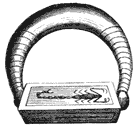 Fig. 76. |
 Fig. 77. |
The lighter kind of hooped signet, as generally worn at a somewhat more recent era in Egypt, is shown in Fig. 77. The gold loop passes through a small figure of the sacred beetle, the flat under side being engraved with the device of a crab. It is cut in carnelian, and once formed part of the collection of Egyptian antiquities gathered by our consul at Cairo—Henry Salt, the friend[76] of Burckhardt and Belzoni, who first employed the latter in Egyptian researches, and to whom our national museum owes many of its chief Egyptian treasures.
From a passage in Jeremiah (xxii. 24) it appears to have been customary for the Jewish nation to wear the signet-ring on the right hand. The words of the Lord are uttered against Zedekiah—“though Coniah, the son of Jehoiakim, King of Judah, were the signet on my right hand, yet would I pluck thee thence.”
The transition from such signets to the solid finger-ring was natural and easy. The biblical record treats them as contemporaneous even at that early era. Thus the story of Judah and Tamar is immediately followed by that of Joseph, when we are told “Pharaoh took off the ring from his hand and put it upon Joseph’s hand,” when he invested him with authority as a ruler in Egypt. Dr. Abbott, of Cairo, obtained a most curious and valuable ring, inscribed with a royal name. It is now preserved, with his other Egyptian antiquities, at New York, and is thus described in his catalogue:—“This remarkable piece of antiquity is in the highest state of preservation, and was found at Ghizeh, in a tomb near that excavation of Colonel Vyse’s called ‘Campbell’s Tomb.’ It is of fine gold, and weighs nearly three sovereigns. The style of the hieroglyphics is in perfect accordance with those in the tombs about the Great Pyramid; and the hieroglyphics within the oval make the name of that Pharaoh (Cheops) of whom the pyramid was the tomb.” Fig. 78 represents this ring, and beside it (Fig. 79) is placed the hieroglyphic inscription upon the face of the ring, which is cut with the most minute accuracy and beauty.
 Fig. 78. |
 Fig. 79. |
 Fig. 80. |
 Fig. 81. |
Rings of inferior metal, bearing royal names, were worn, probably, by officials of the king’s household. Henry Salt had one such in his collection, which was afterwards in the remarkable collection of rings formed by the late Lord Londesborough. It is represented in Fig. 80, and is entirely of bronze. The name of Amunoph III. is engraved on the oval face of the ring, exactly as it appears on the tablet of Abydus in the British Museum. Amunoph (who reigned, according to Wilkinson, B.C. 1403-1367) is the same monarch known to the Greeks as Memnon; and the colossal “head of Memnon,” placed in the British Museum through the agency of Mr. Salt, has a similar group of hieroglyphics sculptured on its shoulder. There was another kind of official ring, which we can recognise from the description of Pliny, and of which we give an engraving (Fig. 81) from the original in the[78] author’s possession. It is of bronze, and has engraved upon its face the figure of the scarabæus; such rings were worn by the Egyptian soldiers.
The lower classes, who could not afford rings of precious metals, but, like their modern descendants, coveted the adornment, purchased those made of ivory or porcelain. In the latter material they abounded, and are found in Egyptian sepulchres in large quantities; they are very neatly moulded, and the devices on their faces, whether depicting gods, emblems, or hieroglyphics, are generally well and clearly rendered.
This fondness for loading the fingers with an abundance of rings is well displayed on the crossed hands of a figure of a woman (Fig. 82) upon a mummy case in the British Museum. Here the thumbs as well as the fingers are encircled by them. The left hand is most loaded; upon the thumb is a signet with hieroglyphics on its surface; three rings on the forefinger; two on the second, one formed like a snail-shell; the same number[79] on the next, and one on the little finger. The right hand carries only a thumb-ring, and two upon the third finger. These hands are cut in wood, and the fingers are partially broken.
Wilkinson observes—“The left was considered the hand peculiarly privileged to bear these ornaments; and it is remarkable that its third finger was decorated with a greater number than any other, and was considered by them, as by us, par excellence, the ring-finger; though there is no evidence of its having been so honoured at the marriage ceremony.”
Herodotus narrates a curious antique legend he obtained in Egypt, concerning the ring of Polycrates. It is remarkable as having spread into the legendary history of all countries, being still credited by the commonality. We shall have hereafter to note its existence as an old London tradition; but the version of the Greek historian is briefly thus:—Amasis, King of Egypt, conceived an extraordinary friendship for the Greek, Polycrates, and, observing that the latter was attended by unusual success in all his adventures, reflected that such unvarying felicity seldom lasted through life, and the end of such a career was often calamitous. He therefore advised him to propitiate future fortune by seeking some object whose loss would produce most regret, and voluntarily casting it away from him where it could never be recovered. Polycrates attached most value to a signet-ring he constantly wore; it was of gold, set with an emerald cut by Theodorus of Samos, a famed engraver of gems. He went out in a galley far on to the open sea, and then cast his precious ring into its waters, returning in an excess of grief. Some six days afterwards a fisherman came[80] to his gate, bearing a fish so fine and large he deemed it to be only fitted for the table of Polycrates. The King of Samos accepted the gift, the fish was sent to the royal kitchen, and on opening it a valuable ring was found in its stomach. It was at once taken to Polycrates, who immediately recognised his abandoned treasure, which he now valued the more as it seemed to be returned by divine interposition.
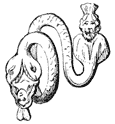 Fig. 83. |
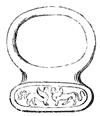 Fig. 84. |
In the comparatively modern era of Roman rule in Egypt, rings of more fanciful construction were occasionally worn. In the British Museum is a remarkable one (Fig. 83), having the convolutions of a serpent, the head of Serapis at one extremity and of Isis at the other; by this arrangement one or other of them would always be correctly posited; it has also the further advantage of being flexible, owing to the great sweep of its curve.
The ancient Assyrians, though remarkable for that love of jewellery which has ever been the characteristic of the Eastern nations, appear to have worn no finger-rings. Yet many of their bracelets are admirably designed for the purpose if produced on a limited scale; and they were worn by men as well as by women.[81] Bonomi, in his “History of Nineveh and its Palaces,” observes, “that not a single case occurs, amidst all this display of personal jewellery, of a finger-ring; the entire absence of this ornament in sculpture, wherein details of this nature are so elaborately and carefully attended to, leads to the conclusion that the finger-ring was an ornament then unknown.”
 Fig. 85. |
 Fig. 86. |
Among the earliest traces of western civilisation the finger-ring appears. Fig. 84 is an Etruscan ring of gold, now in the British Museum; upon the face are chimeræ opposing each other. The style and treatment of this subject partake largely of the ancient character of Eastern art, and, like that, is very decisive and conventional.
The Greeks and Romans literally revelled in rings of all styles and sizes. Nothing can be more beautiful in design and exquisite in finish than Greek jewellery, and the custom of decorating their dead with the most valued of these ornaments has furnished modern museums with an abundance of fine specimens. Figs. 85 and 86 are copied from originals found in the more modern Etruscan sepulchres, and are probably contemporary with the earliest days of the Roman empire. Fig. 85 is admirably adapted to the finger;[82] being made of the purest gold, it is naturally slightly elastic; but the hoop is not perfected, each extremity ending in a broad leaf-shaped ornament, most delicately banded with threads of beaded and twisted wire, acting as a brace upon the finger. Fig. 86 is equally meritorious; the solid half-ring is completed by a small golden chain attached to it by a loop passing over studs; the links of this chain are perfectly flexible, and of extreme delicacy; they resemble the modern guard-chain, or to speak more properly, the modern chain imitates the ancient one; and we shall meet in the course of our researches with very many other instances of the oft-repeated fact, that “there is nothing new under the sun.”
This ring mania was not content with considering the ring as an ornament, or even as a talisman; a new science was revealed, the Dactyliomancia, so named from two Greek words, signifying ring and divination. The performance of its mysteries was in itself so simple, that it was deemed expedient to add certain formulæ, in order to make them more expressive. A ring was held, suspended by a fine thread, over a round table, on the edge of which were placed counters engraved with the letters of the alphabet. The thread was shaken until the ring, touching the letters, had united as many as formed an answer to a question previously put. This operation was preceded and accompanied by certain ceremonies. The ring was consecrated with divers mysterious forms. The person who held it was arrayed in linen only; a circle was shaved round his head, and in his hand he held a branch of vervain. Before commencing the gods were appeased by prayer.82-* This[83] practice long prevailed, and is mentioned by Gibbon as having given rise to the persecutions for the crime of magic, in the reign of the Emperor Valens, at Antioch.83-*
 Fig. 87. |
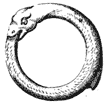 Fig. 88. |
The simplest and most useful form of ring, and that, by consequence, adopted by the people of all early nations, was the plain elastic hoop, as shown in Fig. 87. Cheap in construction and convenient in wear, it may be safely said to have been generally patronised from the most ancient to the most modern times. Fig. 88 gives us the old form of a ring made in the shape of a coiled serpent, equally ancient, equally far-spread in the old world, and which has had a very large sale among ourselves revived as a “decided novelty.” In fact it has been the most successful design our ring-makers have produced of late years. Yet this antique ring may add another “new idea” to the modern designer. It is “made on the principle of some of our steel rings which we use to hold household keys, widening their circle by pressure. In this finger-ring the part in the mouth is inserted loose, so as to draw out and increase to the size of the circle needed.”83-†
 Fig. 89. |
 Fig. 90. |
Though a great variety of form and detail was adopted by Greek and Roman goldsmiths for the rings they so largely manufactured, the most general and lasting resembled Fig. 89, a Roman ring, probably of the time of Hadrian, which is said to have been found in the Roman camp at Silchester, Berkshire. The gold of the ring is massive at the face, making a strong setting for the carnelian, which is engraved with the figure of a female bearing corn and fruit. By far the greater majority of Roman rings exhumed at home and abroad are of this fashion, which recommends itself by a dignified simplicity, telling, by quantity and quality of metal and stone, its true value, without any obtrusive aid.
Sometimes a single ring was constructed to appear like a group of two or three upon the finger. Mr. Edwards has furnished us with the example, Fig. 90. “It has the appearance of three rings united, widened in the front and tapering within the hand. Upon the wide part of each are two letters, the whole forming ZHCAIC, ‘Mayest thou live.’ The Romans often preferred the Greek language in their most familiar customs.”
Among the beautiful objects of antique art collected by B. Hertz, Esq., and sold by auction in 1859, by Messrs. Sotheby and Wilkinson, were many antique rings inscribed with sentences and mottoes of a remarkable kind. Those bearing Greek inscriptions[85] were the wordiest; such as—“I love not lest I go astray; but I observe well, and I laugh.”—“They say what they will; let them say, I care not.” Many were evidently memorials of friendship; one represented a hand pulling the lobe of an ear, with the word “Remember;” another, with a similar device, with the motto “Remind me of the noble character.” Others were inscribed—EYTYXI—“Good luck to you,” and “I bring luck to him who wears this ring.” Among the Latin inscriptions were simple good wishes expressed in the words “Vivas” and “Bene;” or sentiments expressed in few words, such as—“Love me, I will love thee;” “Come, I will not;” “Be greeted, Fabiana.” Many were simply inscribed with the names of the persons to whom they were presented, such as VLP. PRISCELLÆ (“Ulpia Priscilla”); others with the names of the owners, as Valeria Cleopatra and Hermadion Cæsaris. A massive silver ring inscribed with the name “Sabbina” is engraved (Fig. 91) from the original in the Londesborough collection.
 Fig. 91. |
 Fig. 92. |
We place beside it a ring with a very different device, but one that cannot fail to be looked on with singular interest. It is marked with the Labarum, the oldest sacred monogram of Christianity, which Constantine believed he saw in a vision, and placed[86] upon his victorious standard and his coins, with the motto—“In hoc signo vinces!” This ring came from the Roman sepulchre of an early Christian, and the hand for which it was originally fashioned may have aided in the conquering war of the first Christian emperor; or may have been convulsed in an agonising death, “thrown to the beasts” of the circus, but reposing after death with the first martyrs to the faith.
Clement of Alexandria suggests to the Christians of his era, that they should have engraved devices of symbolic meaning allusive to their faith, in place of the heathen deities and other subjects cut by Roman lapidaries; such as a dove, which symbolises life eternal and the Holy Spirit; a palm-branch, peace; an anchor, hope; a ship in full sail, the church; and others of similar import.
Gorius has preserved a representation of a gold ring (Fig. 93) which he believes to have been presented by a Roman lady to the victorious charioteer in the horse-races; it is of peculiar form, but one that was a favourite with Roman wearers. The bust of the donor appears on the summit of the ring, and on each side are the[87] heads of reined horses, as shown in our cut. Her name is engraved on the lower part of the hoop, and on each side AMOROSPIS. The latter properly being HOSPES, having the aspirate omitted and an I for an E, induces Gorius to consider it a late work of the Roman era.
We have already spoken of the ring-hand and the ring-finger, but have not noted the origin of the custom of placing the wedding ring on that finger. It resulted from an inaccurate belief that a nerve went from thence to the heart. That the ancients were indiscriminate in the use of their fingers as recipients for rings we have already shown; Mr. Waterton has placed in his curious Dactyliotheca the forefinger from a bronze statue of late Roman workmanship, wearing a large ring upon the second joint. In Germany it is still customary to wear the ring in this fashion, a custom they evidently borrowed from their Roman subjugators, and have retained through every century of change since then.
As the luxury of Rome increased, the wearing of rings increased also, and the emperors relaxed the law of restraint. Thus Tiberias, in A.D. 22, gave permission for gold rings to be worn by all persons whose fathers and grandfathers possessed property to the value of 200,000 sesterciæ. The Emperors Severus and[88] Aurelian ultimately gave the right of wearing gold rings to all soldiers of the empire; and the Emperor Justinian at length gave a similar right to all who had legal claims to Roman citizenship. Distinction once broken through, and wealth increasing, ring-wearing became general. Seneca, describing the luxury and ostentation of his time, says, “We adorn our fingers with rings, and a jewel is displayed on every joint.” The ridiculous excess to which the custom was carried may be understood from Martial’s description of Charinus, who wore as many as sixty rings on his hands at one time, and so fond was he of his jewellery that he kept them upon his fingers when in bed. They were decorated with a vast variety of subjects, originally cut in the metal of which the ring was made, whether gold, silver, or brass; ultimately the devices were cut upon stones and gems, occasionally representing the tutelar deity of the wearer. Thus Julius Cæsar wore one with Venus Victrix upon it, and his partisans did the same. Pompey’s ring was engraved with three trophies, indicating his victories in Europe, Asia, and Africa. Many used merely fanciful or emblematic devices; thus Mæcenas had a frog upon his ring. Others wore the portraits of their ancestors or friends. Publius Lentulus had that of his grandfather. Cornelius Scipio Africanus, younger son of the great Africanus, wore the portrait of his father; but, as he was a degenerate son of an illustrious sire, the people gave expression to their disgust at his conduct by depriving him of his ring, saying he was unworthy to wear the portrait of so great a man.
This ring-wearing became one of the troubles of the wealthy,[89] and as the Sybarite complained of the folded rose-leaf inconveniencing his bed, the rich Roman was fatigued with his rings. Hence came the custom of wearing light or heavy rings, or as they termed them, summer or winter rings, according to the season. That there really was some reason in the complaint, will be granted by the reader who looks on Fig. 95, copied from Montfaucon.89-* It is a thumb-ring of unusual magnitude, and of costly material; it has upon it a bust in high relief of the Empress Plotina, the consort of Trajan; she wears the imperial diadem,[90] which is here composed of precious stones cut into facets. This bust would of course come outside the hand, the narrower part of the wreathed ring passing between the thumb and first finger. The gorgeous inconvenience of the whole thing is at once apparent. It probably decorated the hand of some member of the imperial family.
 Fig. 96. |
 Fig. 97. |
The enormous sums expended by the wealthy on rings may be best understood by an allusion to the recorded value of two belonging to empresses of Rome. Thus, the ring of Faustina, we are told, cost £40,000, and that of Domitia £60,000, reckoning the Roman sestertia at its modern value.
Sometimes the decoration of a ring was not confined to a single gem, though such rings were comparatively rare. Valerian speaks of the annulus bigemmis, and Gorleus furnishes us with the specimen engraved in Fig. 96; the larger gem has cut upon it a figure of Mars, holding spear and helmet, but wearing only the chlamys; the smaller gem is incised with a dove and myrtle branch. Beside it are placed two examples of the emblematic devices and inscriptions adopted for classic rings, when used as[91] memorial gifts. The first is inscribed, “You have a love pledge;” the second, “Proteros (to) Ugiæ,” between conjoined hands—a type of concord still familiar to us.
Though the ancients seem scarcely to have thought of decorating the circlet of the ring, they occasionally varied its form, producing novelty at the expense of convenience. Fig. 98 is a whimsical example; it may, however, have been principally used as a signet. The same may be said of Fig. 99, which has a very broad face, set with an incised stone bearing a figure of Hygeia.
 Fig. 98. |
 Fig. 99. |
The ancients tell us of charmed rings; such was the ring of Gyges, which was reported to have rendered him invisible when he turned the stone inwardly, and closed it in his palm. Execetus, tyrant of the Phocians, carried two rings, which he was accustomed to strike together, to divine by the sound emitted what he had to do, or what was to happen to him.
The most curious adaptation of the finger-ring to a double use was made by the Romans. It was a combination of a ring and a key, as represented in Figs. 100 and 101, from originals engraved by Montfaucon in his great work on Roman antiquities. He has published many varieties, for they are very commonly discovered[92] in all places where the Romans located themselves. Many have been found in London, York, Lincoln, and other old cities, as well as in the neighbourhood of Roman camps. The use of these rings is apparent: they opened the small cabinets or boxes in which the most precious articles were preserved, and they were less likely to be lost, mislaid, or improperly used by others, when thus worn night and day on the finger.
 Fig. 100. |
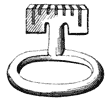 Fig. 101. |
It is recorded of the poisoning Pope Alexander VI. (Borgia), that he caused a somewhat similar key to be used in opening a cabinet; but the Pope’s key was poisoned in the handle, and provided with a small sharp pin, which gave a slight puncture sufficient to allow the poison to pass below the skin. When the Holy Father wished to rid himself of an objectionable friend, he would request him to unlock his cabinet; as the lock turned rather stiffly, a little pressure was necessary on the key-handle, sufficient to give the trifling wound that ultimately proved mortal. Poisoned rings were known to the ancients; when Hannibal, the Carthaginian general, was overcome by Scipio Africanus, it is recorded that he fled to Bithynia, and ended his life by poison, which for that purpose he had reserved in a ring.
 Fig. 102. |
 Fig. 103. |
Rings formed of bone, amber, and glass, were provided for the poorer classes, as was the case in ancient Egypt. They were also used as mortuary rings, and are found on the hands of the dead in Italian sepulchres. The Waterton collection supplies us with two specimens. Fig. 102 is of amber, cut to appear as if set with a stone. Fig. 103 is of glass, also made as if set with a jewel. The body of this ring is dark brown with bands of white crossing it; the jewel is yellow.
 Fig. 104. |
 Fig. 105. |
In the later days of the Roman empire the simplicity and purity in decorative design that the Romans obtained from the Greeks, gave way to the ostentatious love of gaudy decoration taught at Byzantium. Jewellery became complicated in design; enrichment was considered before elegance. The old simple form of finger-ring varied much. Fig. 104 is given by Montfaucon. Fig. 105 is in the Londesborough collection, and was found upon[94] the hand of a lady’s skeleton, buried with her child in a sarcophagus discovered in 1846, in a field near Amiens, called “Le Camp de Cæsar;” on two of her fingers were rings, one of which was set with ten round pearls, the other (here engraved) is of gold, in which is set a red carnelian, engraved with a rude representation of Jupiter riding on the goat Amalthea. The child also wore a ring with an engraved stone. The whole of the decorations for the person found in this tomb proclaim themselves late Roman work, probably of the time of Diocletian.
 Fig. 106. |
 Fig. 107. |
In 1841 a curious discovery was made at Lyons of the jewel case of a Roman lady, containing a complete trousseau, including the rings here engraved. Fig. 106 is of gold; the hoop is slightly ovular, and curves upward to a double leaf, supporting three cup-shaped settings, one still retaining its stone, an African emerald. Fig. 107 is also remarkable for its general form, and still more so for its inscription, VENERI ET TVTELE VOTVM, explained by M. Comarmond as a dedication to Venus and the local Tutela, the guardian of the navigators of the Rhine; hence he infers these jewels to have belonged to the wife of one of these rich traders in the reign of Severus.
[95]Carrying back our researches to the pre-historic era of our own island, and searching in the tumuli of the early British chieftain and his family, we shall discover the utmost simplicity of adornment; not probably the result of indifference to personal decoration, but simply to the rudeness of his position. The wild Gaelic hunter, located in the gloomy fastnesses of wood and morass, had little or no communication with the southern sea-margin of our isle: and when we find the south Cymry of Britain much advanced in civilisation, owing to connection with Belgic Gaul, and Phœnician colonists of Spain, and the Greek colonists of the Mediterranean, we find the tribes inhabiting the midland and northern counties still barbaric, and little advanced in the arts that make life pleasant. Such decoration as they adopted seems to have originated in the basket-weaving, for which the British Islands were famous even at Rome, where noble dames coveted these works from the far-off and mysterious Cassiteridæ. Plaited or interlaced-work, resembling the convolutions of wicker and rush, was imitated in threads of metal; thus circlets for the neck, bracelets for the arms, or rings for the fingers, were but twisted strands of gold.
The simplest form of finger-ring worn by these Gaelic ancestors consisted of a band of metal, merely twisted round to embrace the finger, and open at either end. Fig. 108 shows one of these rings, found in excavating at Harnham Hill, near Salisbury, a locality celebrated from the very earliest recorded time as the true centre of ancient Britain. This ring was found on the middle finger of the right hand of a person of advanced age. Sometimes[96] several rings were found on one hand. “Among the bones of the fingers of the left hand of an adult skeleton was found a silver ring of solid form, another of spiral form, and a plain gold ring.”96-* Mr. Akerman, who superintended these researches, says, “Similar rings have been found at Little Wilbraham, at Linton Heath, at Fairford, and other localities. They are for the most part of an uniform construction, being so contrived that they could be expanded or contracted, and adapted to the size of the finger of the wearer.”96-†
 Fig. 108. |
 Fig. 109. |
The prevailing form of the old Celtic finger-ring is shown in Fig. 109. It is formed of thick twisted wires of pure gold. This fashion seems to have been in most favour with all the early Celtic tribes, such rings being found in the grave-mounds of Gaul, Germany, Belgium, Denmark, Ireland, and Scotland. A discovery of many similar rings was made in one of the Western Islands of Scotland; they were formed of from three to eight wires each, elaborately and beautifully enwreathed.
 Fig. 110. |
 Fig. 111. |
The south Saxons retained to the last the simple form of wire-ring, which originated, as we have already shown, with the most ancient people. Its comparative cheapness and ease of construction were no doubt its great recommendations. Similar rings are still made for the poorer classes in the East: the author has seen such worn in modern Egypt. Specimens have been obtained in Anglo-Saxon grave-mounds in England, and others, identical in form, in the old Saxon cemeteries of Germany.97-* Fig. 110 represents one of the plainest of these wire-rings; it was exhumed from a tumulus on Chartham Downs, a few miles from Canterbury, Kent, in 1773, by the Rev. Bryan Faussett, who says, “the bones were those of a very young person.” Upon the neck was a cross of silver, a few coloured earthen beads, and “two silver rings with sliding knots.”
The industry of the same collector furnishes us with Fig. 111, a specimen of a wire-ring so twisted as to resemble a seal ring, or[98] one set with a stone: the wire round the finger has been beaten out flat. It was discovered in the extensive Saxon cemetery on Kingston Downs, near Canterbury, on the Dover Road. The tumulus was evidently the last resting-place of a person of small wealth, as this copper ring and two small beads only were found in it; and it was customary to bury the ornaments of the deceased, however valuable, with them.98-*
 Fig. 112. |
 Fig. 113. |
Ireland seems to have boasted a higher civilisation at an earlier period than the sister kingdoms, and her ancient art-works are remarkable for their skilled and tasteful elaboration. Gold, too, appears to have been used more commonly there, and the museum of the Royal Irish Academy can show a more wonderful collection of personal ornaments in that precious metal, as once worn by the native nobles, than is to be seen in the national museums of any other country, with the exception of Denmark. The gold is of the purest kind and richest colour, and the manner of its working could not be excelled by a modern goldsmith. The Londesborough collection includes two remarkable rings (Figs. 112 and 113), which[99] were found with other gold ornaments near the very remarkable tumulus known as “New Grange,” a few miles from Drogheda. They were accidentally discovered in 1842 by a labouring man, within a few yards of the entrance to the tumulus, at the depth of two feet from the surface of the ground, and without any covering or protection from the earth about them. Two bracelets of thick twisted gold, and a chain, also of gold, were found with them. Another labouring man, hearing of this discovery, carefully searched the spot whence they were taken, and found a denarius of Geta, which may aid us in arriving at some conclusion as to the age of these curious works. The stone set in both rings is a cut agate.

The rings worn by the higher class of our Anglo-Saxon ancestors during the Heptarchy were often very beautiful, and of imposing form. One of the finest we have seen belonged to the Rev. H. B. Hutchings, of Appleshaw, Hants,100-* and was found in a meadow at Bosington, near Stockbridge, in the same county, by a labourer who saw it among a heap of peat. We give a side and front view of this interesting relic; the whole is of gold, and is of considerable weight and thickness; the gold threads are all beautifully reeded, and the lettering and head executed with great care. The inscription reads—NOMEN EHLLA FID IN XPO, equivalent to its owner saying, “My name is Ella, my faith is in Christ.”
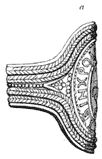 Fig. 114. |
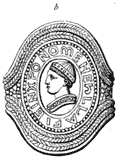 Fig. 115. |
The beautiful and remarkable collection of rings formed by Edmund Waterton, Esq., F.S.A., to which allusion has already been made, includes a ring of South Saxon workmanship, which was found in the Thames at Chelsea in 1856. The face of this ring (Fig. 116) is an elongated oval, with a circular centre. Within this circle is the conventional figure of a dragon, surrounded[101] by convoluted ornament, reminding us forcibly of the prevailing enrichments so lavishly bestowed on old Runic monuments, at home and abroad. Four quaintly-formed heads of dragons occupy the triangular spaces, above and below this centre. This ring is of silver. The ground between the ornament has been cut down, probably for the insertion of niello or enamel colours.
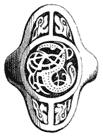 Fig. 116. |
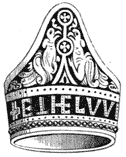 Fig. 117. |
Fig. 117 is an historic relic of singular interest, and a remarkable work of early art. It is the ring of Ethelwulf, King of Wessex (the father of Alfred the Great), who reigned A.D. 836-[102]838, and bears the royal name upon it. It was found in the parish of Laverstock, Hants, in a cart-rut, where it had become much crushed and defaced. The form is remarkable, the front rising pyramidally. Two birds of conventional form face each other, a flower ornament dividing them; these decorations, like those on Mr. Waterton’s ring just described, are relieved by a ground of glossy bluish-black enamel, cavities having been cut between the ornament for its infusion. This ring is of gold, weighing 11 dwts. 14 grs.; it is now preserved in the British Museum.
Mr. Waterton is the fortunate possessor of a ring second only in interest and value to this royal relic. It is the ring of Ahlstan, Bishop of Sherborne, the friend and counsellor of King Ethelwulf, who flourished A.D. 817-867. It was discovered in Carnarvonshire, and has the name of the bishop in divided letters distributed on the circular rosettes of the design; they are connected by lozenge-shaped floriated ornaments, having dragons in their centres. Our cut (Fig. 118) gives the general form and detail of this beautiful ring, which is remarkable for the elegance of its[103] design. It is of gold, like the preceding ring; both being admirable illustrations of the champ-levé process of enamelling as practised in the ninth century.
 Fig. 119. |
 Fig. 120. |
A remarkable discovery of coins and treasure was made in 1840 by workmen employed in digging at Cuerdale, near Preston, in Lancashire. It consisted of a large mass of silver, in the form of ingots or bars of various sizes, a few armlets and rings, and portions of other ornaments, cut into pieces as if for remelting. With them were packed nearly seven thousand coins of various descriptions, consisting of Anglo-Saxon pennies, others struck by the second race of French kings, a few Oriental coins, and others which appear to have been coined by some of the piratical northern chieftains. This treasure was minutely examined by E. Hawkins, F.R.S., of the British Museum, and he came to the conclusion that it had been deposited about the year 910, and that the ornaments must be considered such as were worn about the time of Alfred, or perhaps somewhat earlier. The rings retain much of the primitive British form, as will be seen on examining the two selected for engraving here. Fig. 119 is beaten out into a broad face, which is covered with an indented ornament produced by a chisel-shaped punch of triangular form, the points[104] of two conjoined in one pattern, the edge of the ring on each side further enriched by a series of dots. Fig. 120 has a still broader face, which is decorated by groups of three circles each, somewhat irregularly distributed over the surface, with indented lines between them. The open end of this ring has been drawn together and secured by a coil of wire. Such rings were probably worn by the middle classes.
The passion for gems and jewellery was excessive among all the Gothic nations. When Alaric pillaged Rome, his booty in this way was enormous; and it is recorded that his princess, Placidia, received as a present from the conqueror’s brother, fifty basins filled with precious stones of inestimable value. Not only were the persons of these sovereigns and nobles covered with gems, inserted in girdles, sword-scabbards, on borders of garments or shoes; but vases, dishes, bowls, drinking-cups, as well as portable articles of furniture, caskets, &c., were similarly enriched. The Ostrogoth and Wisigoth kings amassed, in Tolosa and Narbonne, immense treasures in gems and gold and silver vessels. When Narbonne was pillaged, the number of ornaments of pure gold enriched with gems that fell to the conquerors would scarcely be credited, were the details recorded by less trustworthy authors, or not corroborated by some few works of the same age which have fortunately descended to us.
The Church shared largely in this wealth; crosses, reliquaries, and sacred vessels of all kinds, were made of the most costly material, and encrusted with gems. One of these ancient works may still be seen in Cologne Cathedral—the chasse, or reliquary,[105] containing the reputed skulls of the three Magi, of whom we shall soon have to speak more fully. This remarkable work is studded all over with engraved intaglios of Roman workmanship. Churchmen at this time were clever artificers; and St. Dunstan, great statesman as he was, in the British, and St. Eloi in the Gallic, church, both skilled working goldsmiths, have since become the patron saints of confraternities of their followers.
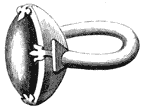 Fig. 121. |
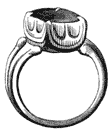 Fig. 122. |
The higher clergy on all solemn occasions displayed much personal decoration. A jewelled ring was part of the adornment of a bishop when arrayed in full pontificals. It indicated his rank, was made for him, and buried with him. The treasuries of our old cathedrals still possess a few of these rings. One of the earliest and most curious is kept by the Dean of Winchester, and is represented in Fig. 121. It was found during the repair of the choir under the tomb of William Rufus, and is supposed to have been the pontifical ring of Henry de Blois, Cardinal, and Bishop of Winchester, A.D. 1129. It is a massive ring of solid gold, set with an oval irregularly-shaped sapphire, en cabochon, polished only, not cut; held in its heavy socket by four fleur-de-lys, and[106] still further secured by drilling through its centre a passage for a gold wire—a reckless way of treating valuable jewels, which is characteristic of almost all these early works.
Fig. 122 is an ordinary pontifical gold ring of investiture, used in the Anglican Church about this time. It was found at Winchester, and is preserved with Fig. 121, described above. It has a very massive setting for a large blue sapphire, and is very characteristic, though simple in its design.
 Fig. 123. |
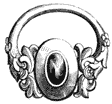 Fig. 124. |
Dignity, as exhibited by weight and simplicity, seems to have been chiefly regarded in the design of these old episcopal insignia. In the sacristy at York Minster is preserved a very excellent specimen, Fig. 123. This was found in the tomb of Archbishop Sewall, who died in 1256. With it is kept another fine ring of more elaborate design (Fig. 124), which was discovered in the tomb of Archbishop Greenfield, who died in 1315. The foliations which curl around the central stone and its setting, take the prevailing forms adopted in architectural enrichments of the archbishop’s age. The stones usually chosen for such rings were ruby, emerald, or crystal, and had a significance usual with all things connected with the Roman Catholic Church; ruby indicated its[107] glory, emerald its tranquillity and happiness, and crystal its simplicity and purity. The diamond typified invulnerable faith; the sapphire, hope; the onyx, sincerity; the amethyst, humility.
In the old romance of “Sir Degrevant,” we are told that at the marriage of the hero there came
“Archbishops with rings
More than fifteen.”
In the romance of “King Athelstan” (also a work of the fourteenth century), the king exclaims to an offending archbishop—
“Lay doun thy cross, and thy staff,
Thy miter, and thy ring, that I to thee gaff:
Out of my land thou flee.”
The episcopal ring, being thus necessarily a mark of rank, was worn about this time over the gloves: sometimes as a thumb-ring, and often of very large size. The ornaments of the clergy became more massive as the wealth of the Church increased. As the clergy were during church service separated from the laity, many of the latter were at a considerable distance from them. This may be a reason for the size adopted for episcopal rings. A late Dean of St. Patrick’s had in his collection a very large ring of this kind, represented in Fig. 125, from a sketch made by the[108] author when it was in the possession of W. Huxtable, F.S.A., in 1847. It was of bronze, thickly gilt, and set with a crystal.
This peculiar form was generally adopted for rings at this period. The Londesborough collection furnishes us with a curious specimen (Fig. 126), formed of gilt copper, and set with a small ruby, which must have stood forth from the finger in what would now be considered as a most inconvenient manner. Fig. 127 exhibits the form of the plain hooped ring, simply decorated with quatrefoils on each side of the stone (in this instance a small irregularly-shaped sapphire), which is embedded in a somewhat solid setting projecting from the ring.
 Fig. 126. |
 Fig. 127. |
In the Gentleman’s Magazine for 1848 is engraved a massive ring, also of brass, thickly gilt, the hoop chased with the arms of Pope Pius II.108-* (the famed Æneas Sylvius), and his name, Papa Pio, between the tiara and the cross-keys. On each of the four sides of this ring appears one of the four beasts of the Revelation, typifying the Evangelists: they are executed in high relief. It is set with a large topaz. This ring has since passed into Mr. Water[109]ton’s fine collection, who is the fortunate possessor of others of the same class. One in the Londesborough collection is here engraved, Fig. 128, as a good specimen of the general design adopted for such rings. The crossed-keys surmount a coat of arms on one side of the ring; the keys alone appear on the opposite side; foliated ornament fills the space above the circlet on either side. This ring is set with a large crystal.
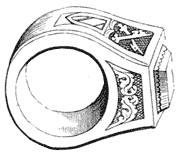 Fig. 128. |
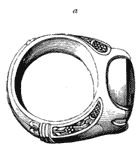 Fig. 129. |
 Fig. 130. |
We close our series of episcopal rings with one found in the cathedral at Hereford during the repairs of the choir in 1843, which rendered the removal of the beautifully carved alabaster monument of Bishop Stanbery unavoidable. This bishop held the See from 1452 until his death in May, 1474. Upon opening the tomb a few fragments of bone were discovered, very small portions of the mere remains of the silk of the robes in which the body of the bishop was enveloped, and this beautiful ring, of which views are given in Figs. 129 and 130. It is of gold, set with a sapphire; the sides of the ring are decorated with sprays and flowers on a ground of dark enamel; and inside is the motto “en bon an.”
 Fig. 131. |
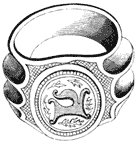 Fig. 132. |
A very large ring, bearing great general resemblance to the episcopal ring, was occasionally worn as a thumb-ring by the laity. A specimen of such a one is selected from the Londesborough collection in Fig. 131. It is somewhat roughly formed of mixed metal, and has upon the circular face a conventional representation of a monkey looking at himself in a hand-mirror. This is surrounded by a cable moulding, and on each side is set two large stones. The outer edge of this ring is also decorated with a heavy cable moulding: inside, next the finger, is the cross and sacred monogram, placed on each side of the mystic word anamzapta, which we shall immediately have to explain more fully when speaking of the rings commonly worn as charms.
These massive thumb-rings were indicative of wealth or importance, when worn by the middle classes who had obtained any municipal position. When Falstaff speaks of his slenderness in his youth, he declares that he could then have “crept through an alderman’s thumb-ring.” Like the massive gold chains still worn by that honourable fraternity, they told of a trader’s wealth.[111] The inventories of personal property belonging to burgesses in the Middle Ages, contain frequent allusions to such rings, without which they would have felt shorn of an important part of their head-earned honours. Among the wills and inventories preserved at Bury St. Edmund’s, published by the Camden Society, is one made by Edward Lee, of that town, bearing date 1535, in which he bequeaths to a friend, “my double wreathed ryng of gold, whych I ware on my thumbe.” From this description it is evident that this ring must have borne great resemblance to that given in Fig. 131, with its outer cable or double wreathed pattern. There is a brass in Hastings Church, Sussex, with the effigy of a gowned citizen wearing such a ring. That such rings became in the end indicative of that class, and were retained in fashion for this reason when they had been long discarded from general use, may be safely inferred from the description of a character introduced in the Lord Mayor’s Show in the year 1664, who is said to be “habited like a grave citizen—gold girdle and gloves hung thereon, rings on his fingers, and a seal ring on his thumb.” Such rings were evidently used according to the most ancient mode as personal signets, by such as were not entitled to bear arms; hence originated the quaint inventions known as “merchant’s marks,” which were impressed on merchandise, painted on shields instead of armorial bearings, inserted in memorial windows of stained glass, and worn on the thumb for constant use in sealing. A very fine ring of this kind is engraved in the Journal of the Archæological Institute, vol. iii., and is here copied in Fig. 132. It was found in the bed of the Severn, near[112] Upton, and is probably a work of the fifteenth century; it is of silver, and has been strongly gilt. The hoop is spirally grooved, and upon the circular face is a large letter H, surrounded by branches.
 Fig. 133. |
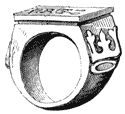 Fig. 134. |
The custom of placing initial letters on rings is a very old one, and they are sometimes surmounted by crowns or coronets; hence they have frequently been mistakenly appropriated to royalty. Fig. 133 is a ring of this kind, with a crowned I upon it; hence it was once called “King John’s ring.” It is most probably the initial of the Saviour’s name as King of the Jews, in the same way that the crowned M may indicate the Virgin Mary as “Queen of Heaven,” a favourite popish designation. Such rings may have been worn from religious feeling, or from the superstitious belief in the efficacy of holy names as preservatives from evil. The baseness of the metal of which they are often made, and their consequent small value, precludes the possibility of their having belonged to royalty. The same remark will apply to a ring also engraved in the Journal of the Archæological Institute, and now in the possession of the Rev. Walter Sneyd. It is there described as of mixed yellow metal gilt; on either side of the hoop there is[113] a crown (Fig. 134), of the form commonly seen on coins of the twelfth century, and on the signet are the words, ROGERIVS REX, chased in high relief. In the form of the character they correspond closely with legends upon coins of Roger, second Duke of Apulia, of that name, crowned King of Sicily A.D. 1129; he died A.D. 1152. This ring has every appearance of genuine character, but it is difficult to explain for what purpose it was fabricated, the inscription not being inverted, and the letters in relief ill suited for producing an impression. It seems very improbable that King Roger should have worn a ring of base metal; and the conjecture may deserve consideration, that it was a signet not intended for the purpose of sealing, but entrusted in lieu of credentials to some envoy. The popular literature of the Middle Ages abundantly proves this custom to have been in general use. The tale of Ipomydon, in Weber’s “Ancient Metrical Romances,” notes the gift of a ring to the hero from his mother, which is to be used as a token of recognition to his illegitimate brother, and which is brought secretly to his notice by being dropped into his drinking horn. In the “Romance of Florence and Blancheflor,” a ring serves the purpose of letters of introduction when the hero is on his travels, and ensures him hospitality when he deserves it.
Rings sometimes bore the name and title of the Saviour in full, as in Fig. 135 from the Londesborough collection. Two hands are clasped in front; it was, therefore, most probably a gift, or betrothal ring. It is silver, somewhat rudely fashioned. The inscription (here engraved below it) is in uncial characters,[114] and shorn of its somewhat awkward abbreviation, reads “Jesus Nazareneus Rex.”
 Fig. 135. |
 Fig. 136. |
 Fig. 137. |
The same collection furnishes us with the specimen of a religious ring (Fig. 136), apparently a work of the fourteenth century. It has a heart in the centre, from which springs a double flower. On the upper edge of the ring are five protuberances on each side; they were used to mark a certain number of prayers said by the wearer, who turned his ring as he said them, and so completed the series in the darkness of the night. Such rings are of very common occurrence, and must have been in general use. They are sometimes furnished with more prominent knobs, as in Fig. 137. They are termed decade rings when furnished with ten bosses, which were used to count the repetition of ten aves, but they are occasionally seen with one or two additional bosses; when there are eleven, they notify ten aves and a paternoster; the addition of the twelfth marks the repetition of a creed.
Allusion has already been made to the mystic virtues attributed to stones during the Middle Ages, and for the fondness for collecting antique gems. They were coveted not only as works of art, but for their supposed power over the circumstances of life, or the[115] welfare of individual wearers. The idea very probably originated with the Gnostics of the East, who engraved stones with mystic figures believed to impart good luck or to keep off evil influences. So completely had this belief gained hold on all classes, that a Gnostic gem set as a ring was found on the finger of the skeleton of an ecclesiastic, in the Cathedral of Chichester, “affording indubitable evidence that these relics were cherished in the Middle Ages by those whose express duty it was to reprove and check such gross superstition.”115-*
This belief was ultimately reduced to a system. An old French Lapidaire, compiled in the thirteenth century, assures us that a stone engraved with the figure of Pegasus or Bellerophon is good for warriors, “giving them boldness and swiftness in flight,” very contradictory qualifications, it must be allowed. One with the figure of Andromeda had the power of conciliating love between man and woman. “A gem bearing the figure of Hercules slaying a lion or other monster, was a singular defence to combatants. The figure of Mercury on a gem rendered the possessor wise and persuasive. The figure of Jupiter with the body of a man and the head of a ram, made the man who bore it beloved by everybody, and he was sure to obtain anything he asked. If you find a stone bearing the figure of a hare, it will be a defence against the devil; if you find a dog and a lion on the same stone, it will be a preservative against dropsy or pestilence. The figure of Orion was believed to give victory in war. If you find a stone, in which is[116] Perseus holding in his right hand a sword, and in his left the Gorgon’s head, it is a preservative against lightning and tempest and against the assaults of devils. A stone on which is engraved a long-bearded man sitting on a plough, with a bending in his neck, and four men lying down, and holding in his hand a fox and a vulture, this, suspended about the neck, enables you to find treasures. If you find a dove, with a branch of olive in its mouth, engraved in pyrites, and mount it in a silver ring, and carry it with you, everybody will invite you to be his guest, and people will feast you much and frequently. The figure of a syren, sculptured in a jacinth, rendered the bearer invisible. A fair head, well combed, with a handsome face, engraved on a gem, gave to the bearer joy, reverence, and honour. Such were the qualities attached to ancient gems in the Middle Ages.”116-*
Many plain stones were also believed to have magical virtues. Thus, the amethyst prevented drunkenness, and was consequently often set upon wine cups. The crystal clouded if evil was about to happen to its wearer. Amber was good against poison, hence drinking-cups were formed from it. The topaz cured and prevented lunacy, increased riches, assuaged anger and sorrow, and averted sudden death. Such was the faith placed in stones until the end of the sixteenth century. Dr. Donne speaks of
“A compassionate turquoise, that doth tell,
By looking pale, the wearer is not well.”
[117]But the most curious of all these superstitious beliefs attached itself to the crapaudine, or toad-stone. It is most unattractive to sight, of an opaque dirty-brown tint, and known to mineralogists as a variety of trap-rock. It was believed to have most sovereign virtues against poison if pounded and drank, and, like the turquoise, to give warning of its presence by a change of colour, when simply worn in a ring. It was believed to exist in the head of the toad. Fenton, writing in 1569, says, “There is found in the heads of old and great toads a stone which they call borax or stelon; it is most commonly found in the head of a he-toad.” It was not easily attained, for the toad “envieth so much that man should have that stone,” says old Lupton, in his “Thousand Notable Things.” Hence came a true test for such stones, according to the same credulous author, who thus enlightens us:—“To know whether the toad-stone called crapaudina be the right and perfect stone or not, holde the stone before a toad so that he may see it, and if it be a right and true stone, the toad will leap toward it, and make as though he would snatch it from you.” It should be obtained, says a mediæval author, while the toad is living, and this is to be done by simply placing him upon a piece of scarlet cloth, “wherewithal they are much delighted, so that while they stretch out themselves as it were in sport upon that cloth, they cast out the stone of their head, but instantly they sup it up again, unless it be taken from them through some secret hole in the same cloth.”117-*
 Fig. 138. |
 Fig. 139. |
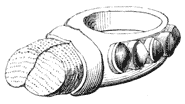 Fig. 140. |
Lupton, whom we have just quoted, tells us of “a rare good way to get the stone out of the toad,” which has the advantage of greater simplicity. It is to be done thus:—“Put a great or overgrown toad (first bruised in divers places) into an earthen pot; put the same into an ants’ hillocke, and cover the same with earth, which toad at length the ants will eat, so that the bones of the toad and stone will be left in the pot.” Boethius relates how he watched a whole night an old toad he had laid on a red cloth to see him cast forth the stone, but the tedious watch was not rewarded; the toad retained his jewel, and he had nothing from thence to “gratify the great pangs of his whole night’s restlessness.”
The Londesborough collection supplies us with two remarkable specimens of rings connected with toad superstition. Fig. 138 is of mixed metal gilt, having upon it the figure of a toad swallowing a serpent. There is a mediæval story of a necromancer introducing himself to another professor of magic by showing him a serpent ring, upon which the latter, who did not desire any one to interfere with his practice, produced his toad-stone ring, observing that the toad might swallow the serpent, thereby intimating his[119] power to overcome him. Fig. 139 is curious, not only as containing the true toad-stone, but also that the stone is embossed with the figure of a toad, according to the description of Albertus Magnus, who describes the most valuable variety of this coveted gem as having “the figure of the reptile imprinted upon it.”
The elder poets have, as usual with them, turned into a moralisation this fabulous bit of natural history. Lyly, in his “Euphues,” observes, “the foule toad hath a faire stone in his head.” Shakspere has immortalised the superstition in the most effective and beautiful manner, when he declares how
“Sweet are the uses of adversity,
Which, like the toad, ugly and venomous,
Yet wears a precious jewel in its head.”
Superstition did not confine its belief to a few charms; it ranged over more than we can now record. In the Londesborough collection is the massive thumb-ring delineated in Fig. 140, having the tooth of some animal as its principal gem, fondly believed by its original owner to have mystic power over his well-being. To “make assurance doubly sure,” it is set all round with precious stones, all believed to have magical virtues.
 Fig. 141. |
 Fig. 142. |
Superstition was not confined to the real world of animal life, but ranged over the fabulous natural history which mixed largely with the true, in all men’s minds, at this credulous era of the world’s history, when persons put more faith in false charms for the cure of disease or the prevention of evil, than in the power of medicine, or the value of proper preventives. The horn of the unicorn, the claw of the griffin, and other relics of equal verity and[120] value, were sought eagerly by those rich enough to procure them, and when obtained were believed to ensure much good fortune to the possessor. A fear of the “evil eye”—that bugbear which still disturbs the happiness of the lower class Italians and of the Eastern nations generally—was carefully provided against. One great preservative was the wearing of a ring with the figure of a cockatrice upon it. This imaginary creature was supposed to be produced from that rarest of all rare things, a cock’s egg, foolishly believed to be laid on certain occasions under magic influence and planetary agencies. Sir Thomas Browne, in his “Vulgar Errors,” describes this imaginary creature “with legs, wings, a serpentine and winding tail, and a crest or comb somewhat like a cock.” The Londesborough collection supplies us with a thumb-ring (Fig. 141), having two cockatrices cut in high relief upon an agate. The eye of the living cockatrice was believed to be so deadly as to kill by a look, to which Shakspere alludes in Twelfth Night, and again in Romeo and Juliet:—
“Say thou but I,
And that base vowel I shall poison more
Than the death-darting eye of cockatrice.”
[121]There was, however, a counteraction to the danger, for it was also believed that if a person saw the creature before it saw him, then the cockatrice died from the effect of the human eye. To this Dryden alludes:—
“Mischiefs are like a cockatrice’s eye,
If they see first they kill, if seen they die.”
The figure of this bird merely gave security against the evil eye; it had no other effect; and for this purpose various engraved stones were used. Thus, Fig. 142, from the same collection, has set in its centre a Gnostic gem with cabalistic figures, believed able to avert the dreadful glance.
Such stones were, of course, “far sought, dear bought;” and rings believed to possess such covetable power had a high money value. How then were the poor, still more ignorant and superstitious, to be aided? Craft came to the aid of faith: demand, as usual, produced supply, and inscriptions took the place of costly jewels. Rings were fabricated in silver and baser metals, having cabalistic words upon them, the names of spirits or of saints. To meet the poorest ring-wearer they were even cast in lead, and sold on the cheapest terms. They were believed to prevent cramp and epilepsy. One in the Londesborough collection is inscribed with the mystic word Anamzapta. In a manuscript of the fourteenth century, in the library at Stockholm, we have this recipe “for the falling sickness. Say the word anamzaptus in his ear when he is fallen doun in that evyll, and also in a woman’s ear anamzapta, and they shall never more after feel that evyll.”
In the Journal of the Archæological Institute, vol. iii., is an engraving of a curious magical ring, copied in Fig. 143. It was found on the coast of Glamorganshire, near to “the Worm’s Head,” the western extremity of the county, where numerous objects have been found at various times on the shifting of the sand, such as firearms, an astrolabe, and silver dollars. This ring is of gold, much bent and defaced, and inscribed with mystic words inside and outside the hoop. Their talismanic character seems to be sufficiently proved by the English medical manuscript preserved at Stockholm, already alluded to, in which, among various cabalistic prescriptions, is one “for peynes in theth.... Boro berto briore + vulnera quinque dei sint medicina mei + Tahebal + Ghether + + + Othman.” The last word should probably be read Guthman, and it is succeeded by five crosses, possibly in allusion to the five wounds of the Saviour.
 Fig. 144. |
 Fig. 145. |
As a preventive of peril by travel and sudden death, the names of the three Magi, or the “Kings of Cologne,” as they were more popularly termed, were believed to be most efficacious. Their bodies travelled first to Constantinople, thence to Milan, and[123] lastly to Cologne, by various removals. The faithful may still view the skulls of the Arabian kings who visited the Saviour in the manger (if they can believe the old legend), in the richly-jewelled reliquary, guarded so sacredly in the Cathedral of Cologne. Their possession brought enormous revenues to the building, and a heavy tax is still imposed on all who would see them. It was once (and may be still) believed that anything which had touched these skulls had a protective virtue. Their names acted as a charm, and were inscribed on such articles of wearing apparel as girdles or garters, of which many specimens exist in the curious collection of Mr. C. Roach Smith, and were found at London in excavations or in the Thames. Upon rings they are most common; two are here selected from the Londesborough collection. Fig. 144 is a thick gold hoop, inscribed with their names, Jasper, Melchior, Balthazar, and the abbreviated motto, “in · god · is · a · r.,” which the late Mr. Crofton Croker, who compiled a descriptive catalogue of these rings, thought might probably mean “in God is a remedy.” Fig. 145 furnishes a good example of a fashion of hoop-ring prevalent in the fifteenth and sixteenth centuries, flat inside and angular outside. Each face is inscribed with the same talismanic names. It is formed of cheap mixed metal, was found in London, and presented to the collection by Mr. Roach Smith.
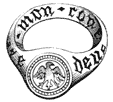 Fig. 146. |
 Fig. 147. |
Inscriptions on rings became at this time very common, nor were they confined to mystic or sacred words. Mottoes of love and gallantry were frequent, as well as moral sentences, and those strictly heraldic. In the curious inventory of the plate and jewels of the Duke of Anjou, compiled about 1360, mention is made of a ring with a large square emerald, surrounded by letters in black enamel. In “Archæologia,” vol. xxxi., is a fine example of such an engraved ring. The representation is copied in Fig. 146. It is a weighty ring of fine gold, and was found in 1823 at Thetford, in Suffolk. The device which appears upon this ring is an eagle displayed; on the inner side is engraved a bird, with the wings closed, apparently a falcon, with a crown upon its head. The following poesy, or motto, commencing on the outer side, is continued on the interior of the ring:—deus me ouroge de bous senir a gree—com moun couer desire—“God work for me to make suit acceptably to you, as my heart desires.” The devices appear to be heraldic, and the motto that of a lover, or a suitor to one in power. The eagle is the bearing of several ancient Suffolk families; it was also a badge of the House of Lancaster, and Thetford was one portion of the Duchy of Lancaster.
[125]These mottoes, or “reasons,” as they were sometimes termed, were occasionally engraved in relief. Fig. 147 represents a specimen from the Londesborough collection. It is of gold, and was found in the Thames. The inscription upon it is—sans bilinie—“without baseness,”—a motto that may have been adopted by some Bayard of the Middle Ages.
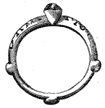 Fig. 148. |
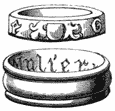 Figs. 149 and 150. |
A very early ring, with an unusual pretty poesy, is in the collection of J. Evans, Esq., F.S.A., and is engraved (Fig. 148). It is of gold, set with a small sapphire, and is inscribed—IE. SVI ICI EN LI’V D’AMI—[“I am here in place of a friend].” It was probably made at the beginning of the fourteenth century. Fig. 149 is chased with the Nortons’ motto, “God us ayde;” and Fig. 150 is inscribed withinside with the sentence, “Mulier, viro subjecta esto.” Both are works of the fifteenth century.
In Bromsgrove Church, Staffordshire, are the fine monumental effigies of Sir Humphrey Stafford and his wife (1450), remarkable alike for the rich armour of the knight and the courtly costume of the lady. She wears a profusion of rings, every finger, except the little finger of the right hand, being furnished with one. They exhibit great variety of design, and are valuable as exponents of[126] the fashion of that day. We engrave in Fig. 151 the hands of the lady, as uplifted in prayer, with four of the rings, the full size of the originals.
Recurring to the ancient people whose sacred records gave us the earliest knowledge of the use of rings, we may profitably devote some attention to the very beautiful rings, formerly used by the Hebrews for betrothals and weddings. The Londesborough collection furnishes us with the two fine examples engraved in Figs. 152 and 153. They are often termed “tower rings,” from the figure of the sacred temple placed on their summit. In the first specimen it takes the form of a sexagonal building, with a domed roof of an Eastern character; in the second it is square, with a deeply pitched roof, having movable vanes at the angles, and is probably the work of some German goldsmith. Upon the roof of the first is inscribed in enamelled letters the best wish—“joy be with you”—that a newly-married couple would command. The same words are inscribed in more richly-designed letters on the curve of the second ring. Both are of gold, richly chased,[127] enamelled, and enriched by filigree work, and are sufficiently stately for the most imposing ceremonial.
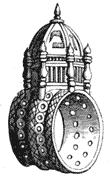 Fig. 152. |
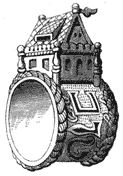 Fig. 153. |
A third Hebrew ring of less striking appearance, but of equal or greater curiosity, is also engraved from the same rich collection, in Fig. 154. It bears on its surface a representation (in high relief) of the temptation of our first parents, who are surrounded by various animals, real and imaginary, their joint residents in Paradise. The workmanship of all these rings has been dated to the commencement of the sixteenth century.
We close our series with a wedding-ring, commemorative of a marriage which excited the marked attention of the entire Christian community, as a vigorous protest against monkery by that “solitary monk that moved the world”—Martin Luther. Renouncing the faith of Rome, he revoked his vow of celibacy, and completed his total severance from its creed by marrying a lady who had been once a nun, named Catharine Boren. The ring, here engraved, is that used on the occasion. It is of elaborate[128] design and execution; a group of emblems of the Saviour’s Passion, the pillar, the scourge, the spear, and various other objects, combine with a representation of the Crucifixion, a small ruby being set in the centre of the ring above the head of the Saviour. We engrave this most interesting object of personal decoration as it appears to the eye, and also the full design in plano; beneath it are the names and date inscribed on the inside of the ring.
The period known as mediæval commences with the fall of ancient Rome under the Gothic invasion, and concludes with the capture of Constantinople by the Turks in 1453. The modern era therefore commences in the middle of the fifteenth century, during the reign of Henry VI.
As private wealth increased, finger-rings became much more ornamental; to the art which the goldsmith and jeweller devoted to them, was added that of the engraver and enameller. Fig. 156, from the Londesborough collection, is decorated with floral ornament, engraved and filled with green and red enamel colours. The effect on the gold is extremely pleasing, having a certain quaint sumptuousness peculiarly its own. Fig. 157 is a fine specimen, from the same collection, of a signet-ring, bearing “a merchant’s mark” upon its face. These marks varied with every owner, and were as peculiar to himself as is the modern autograph; they were a combination of initials or letter-like devices, frequently surmounted by a cross, or a conventional sign, believed to represent the sails of a ship, in allusion to their trading vessels. The marks were placed upon the bales of merchandize, and were constantly used where the coat-armour or badge of persons entitled to bear[130] arms would be placed. The authority vested in such merchants’ rings is curiously illustrated in one of the historical plays on the life and reign of Queen Elizabeth, written by Thomas Heywood, and to which he gave the quaint title, “If you know not me, you know nobody.” Sir Thomas Gresham, the great London merchant, is one of the principal characters, and in a scene where he is absent from home, and in sudden need of cash, he exclaims, “Here, John, take this seal-ring; bid Timothy presently send me a hundred pound.” John takes the ring to the trusty Timothy, saying, “Here’s his seal-ring; I hope a sufficient warrant.” To which Timothy replies, “Upon so good security, John, I’ll fit me to deliver it.” Another merchant, in the same play, is made to obtain his wants by similar means:—
“—— receive thou my seal-ring:
Bear it to my factor; bid him by that token
Sort thee out forty pounds’ worth of such wares
As thou shall think most beneficial.”
 Fig. 156. |
 Fig. 157. |
The custom must have been common to be thus used in dramatic scenes of real life, which the plainest audience would criticise. These plays were produced in 1606, and serve to show that the value attached to a seal-ring descended from very ancient to comparatively modern times.
[131]In the Waterton collection is a massive gold signet-ring, with the rebus of the Wylmot family quaintly designed in the taste of the fourteenth century. In the centre is a tree; on one side of it the letters WY, and on the other OT. Supposing the tree to be an elm, the name reads Wy-elm-ot, or Wylmot.
 Fig. 158. |
 Fig. 159. |
In the fifteenth and sixteenth centuries religious figures were frequently engraved on rings. Fig. 158 represents a ring upon which is very delicately engraved a representation of St. Christopher bearing the Saviour on his shoulder across an arm of the sea, in accordance with the old legendary history of this saint. The circle is formed by ten lozenges, each of which bears a letter of the inscription, de boen cuer. The figure of St. Christopher was used as an amulet against sudden death—particularly by drowning; for it was popularly believed that no sudden or violent death could occur to any person on any day when he had reverently looked upon this saint’s effigy. Hence it was not uncommon for charitable individuals to place such figures outside their houses, or paint them on the walls. There is a colossal figure (and St. Christopher was said to have been of gigantic stature), thus painted, beside the great gate of the ancient city of Treves, on the Moselle.
[132]The enameller and engraver were both employed on the ring Fig. 159, also from the Londesborough collection. The hoop is richly decorated, with quaint floriated ornament cut upon its surface, and filled in with niello, then extensively used by goldsmiths in enriching their works, as it is still in Russia. This beautiful ring is inscribed withinside with the motto mon cor plesor—“my heart’s delight”—and was doubtless a gage d’amour.
Of Elizabeth of England and Mary of Scotland, interesting mementoes are preserved in the shape of rings. Fig. 160 represents the gold signet-ring of Mary, now preserved in the British Museum. Upon the face is engraved the royal arms and supporters of Scotland, with the motto IN . DEFENS, and her initials M.R. But the most curious portion of the ring is the inner side of the seal, as shown in the cut, where a crowned monogram is engraved, which might have been an unsolved enigma, but for the existence in our State Paper Office of a letter written by Mary to Queen Elizabeth, in which she has drawn this[133] identical monogram after signing her name. Sir Henry Ellis, who first traced out this curious history, says, “It is clearly formed of the letters M and A (for Mary and Albany), and gives countenance to the opinion that the written monogram was intended for Elizabeth and Burleigh to study; the subsequent creation of the title of Duke of Albany in Lord Darnley ultimately opening their eyes to the enigma.” Elizabeth’s intense dislike to the Darnley marriage is well known, as she endeavoured to force Mary into a match with one of her own favourites, the Earl of Leicester.
The Waterton collection boasts a gem of no inferior interest in connection with this unhappy marriage. It is the ring of Henry, Lord Darnley, husband to Mary Queen of Scots. On the bezel it bears the two initials M.H. united by a lover’s knot, and within the hoop the name engraved of HENRI . L . DARNLEY, and the year of the marriage, 1565. The cut, Fig. 161, shows the face of the ring with the initials; below is engraved a fac-simile of the interior of the ring as a plane surface.
Queen Elizabeth’s history, and that of her unfortunate favourite, the Earl of Essex, has a tragic story connected with a ring. The narrative is popularly known, and may be briefly told. It is said that the queen, at a time when she was most passionately attached to the earl, gave him a ring, with the assurance that she would pardon any fault with which he might be accused when he should return that pledge. Long after this, when he was condemned for treason, she expected to receive this token, and was prepared to have granted the promised pardon. It came not. The queen was confirmed in the belief that he had[134] ceased to care for her, and pride and jealousy consigned him to the death of a traitor. But the earl had, in the last extremity of despair, entrusted the ring to the Countess of Nottingham, wife of the Lord High Admiral, an enemy to the unfortunate Essex, who forbade his wife to take any proceedings in the matter, but to conceal the trust entirely, and secrete the ring. When the countess lay upon her death-bed, she sent for her royal mistress, for the first time told her guilt, “and humbly implored mercy from God and forgiveness from her earthly sovereign, who did not only refuse to give it, but having shook her as she lay in bed, sent her, accompanied with most fearful curses, to a higher tribunal.” Such is the awful account of the scene by Francis Osborne. Dr. Birch says the words used by Elizabeth were, “God may forgive you, but I never can.” It was the death-blow to the proud old queen, whose regret for the death of Essex could not be quenched by her pride and belief in his ingratitude. A confirmed melancholy settled upon her; she died lonely and broken-hearted.
 Fig. 162. |
 Fig. 163. |
 Fig. 164. |
This ring is now in the possession of the Rev. Lord John Thynne, and three views of it are given in Figs. 162, 163, and 164.[135] It is of gold, of extremely delicate workmanship throughout. A cameo head of the queen is cut on hard onyx and set as its central jewel; the execution of this head is of the highest order, and may possibly have been the work of Valerio Vincentino, an Italian artist who visited England and cut similar works for Elizabeth and Burleigh. It is one of the most minute but the most striking likenesses. The hoop of the ring is enriched with engraving, and the under surface decorated with floriated ornament, relieved by blue enamel. It has descended from Lady Frances Devereux, Essex’s daughter, in unbroken succession from mother and daughter, to the present possessor. Although the entire story has met with disbelievers, the most sceptical must allow that whether this be the ring or not, it is valuable as a work of art of the Elizabethan era.
 Fig. 165. |
 Fig. 166. |
A ring possessing even greater claim to notice, but depending for its appropriation on its own internal evidence, is the next on our list (Figs. 165 and 166). It purports to be the seal-ring of William Shakspere, and was found March 16, 1810, by a labourer’s wife, in the mill close adjoining Stratford-on-Avon churchyard. It passed into the possession of R. B. Wheler, Esq., the historian[136] of the town; and his sister, at his death, presented it to the museum of Shaksperian relics formed in the birthplace of the poet. It is of gold, weighing 12 dwts.; having the initials W.S. braced together by a tasselled cord; the only other ornament upon the ring being a band of pellets and lines on the outer edge of the bezel.
Is it Shakspere’s? It is evidently a gentleman’s ring, and of the poet’s era. It is just such a ring as a man in his station would fittingly wear—gentlemanly, but not pretentious. There was but one other person in the small town of Stratford at that time to whom the same initials belonged. This was one William Smith, but his seal is attached to several documents preserved among the records of the corporation, and is totally different.136-* Mr. Halliwell, in his “Life of Shakspere,” observes that “little doubt can be entertained that this ring belonged to the poet, and it is probably the one he lost before his death, and was not to be found when his will was executed, the word hand being substituted for seal in the original copy of that document.”136-†
In the great poet’s will, five of his friends have bequests of memorial rings. Two are his townsmen, Hamlett Sadler and William Raynoldes, who each have twenty-six shillings and [137]eightpence left them “to buy them ringes;” the other three being the actors (“my fellows,” as he affectionately terms them) John Heminge, Richard Burbage, and Henry Condell,137-* each of whom has a similar sum.
Rings were at this time an almost necessary part of the toilet of a gentleman; they indicated rank and character by their style or their devices. Hence the wills and inventories of the era abound with notices of rings, many persons wearing them in profusion, as may be seen in the portraits painted at this time. The Germans particularly delighted in them, and wore them upon many fingers, and upon different joints of the fingers, the forefinger especially; a custom still followed by their descendants. The ladies even wreathed them in the bands of their head-dresses. Rabelais speaks of the rings Gargantua wore because his father desired him to “renew that ancient mark of nobility.” On the forefinger of his left hand he had a gold ring, set with a large carbuncle; and on the middle finger one of mixed metal, then usually made by alchemists. On the middle finger of the right hand he had “a ring made spire-wise, wherein was set a perfect balew ruby, a pointed diamond, and a Physon emerald of inestimable value.”
Italy now furnished the most splendid and tasteful jewellery;[138] the workmen of Venice exceeding all others. The Londesborough collection supplies us with a graceful example, Fig. 167. The claws support the setting of a sharply-pointed pyramidal diamond, such as was then coveted for writing on glass. It was with a similar ring Raleigh wrote the words on the window-pane—“Fain would I rise, but that I fear to fall”—to which Queen Elizabeth added, “If thy heart fail thee, do not rise at all;” an implied encouragement which led him on to fortune.
 Fig. 167. |
 Fig. 168. |
In Burgon’s life of Sir Thomas Gresham is engraved the wedding ring of that merchant-prince. “It opens horizontally, thus forming two rings, which are, nevertheless, linked together, and respectively inscribed on the inner side with a Scripture poesy. Quod Deus conjunxit is engraved on one half, and Homo non seperet on the other.” It is here copied, Fig. 168.
In Ben Jonson’s comedy, The Magnetic Lady, the parson compelled to form a hasty wedding asks—
“Have you a wedding ring?”
To which he receives as answer—
“Ay, and a poesy:
Annulus hic nobis, quod sic uterque, dabit.”
[139]He at once exclaims—
“... Good!
This ring will give you what you both desire.
I’ll make the whole house chant it, and the parish.”
Such rings were known as Gemel or Gimmal rings, the word being derived from the Latin gemellus, twins. The two making one, and though separate, indivisible, peculiarly fitted them for wedding rings. Their structure will be best understood from the very fine specimen in the Londesborough collection, Fig. 169. The ring, as closed and worn on the finger, is shown in the uppermost figure (a). It is set with sapphire and amethyst, the elaborate and beautiful design enriched by coloured enamels. The lower figure shows the ring parted (b), displaying the inscription on the flat side of each section, which is also enriched by engraving and niello.
Dryden, in his play of Don Sebastian, describes such a ring:—
“A curious artist wrought them
With joints so close as not to be perceived;
Yet they are both each other’s counterpart.
(Her part had Juan inscribed, and his had Zaida:
You know those names were theirs), and in the midst
A heart divided in two halves was placed.
Now if the rivets of those Rings inclosed
Fit not each other, I have forged this lie:
But if they join, we must for ever part.”
A complete illustration of this passage of the poet is afforded in Fig. 170, from the same collection. It also illustrates Dr. Nares’s remark that “Gimmal rings, though originally double,[140] were by a further refinement made triple, or even more complicated; yet the name remained unchanged.” So Herrick:—
“Thou sent’st to me a true love knot; but I
Return a ring of jimmals, to imply
Thy love had one knot, mine a triple tye.”
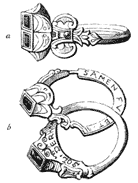 Fig. 169. |
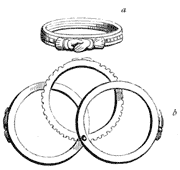 Fig. 170. |
This ring (Fig. 170) is shown (a) as it appears when closed. It parts into three hoops, secured on a small pivot, as seen (b); the toothed edge of the central hoop forming an ornamental centre to the hoop of the ring, and having two hearts in the middle; a hand is affixed to the side of the upper and lower hoop; the fingers slightly raised, so that when the hoops are brought together, they link in each other, and close over the hearts, securing all firmly.
A mechanical ring of still greater mystic significance is shown, Fig. 171, and is one of the most curious of the Londesborough series. The outside of the hoop is perfectly plain, and is set with a ruby and amethyst. Upon pressing these stones, a spring[141] opens, and discovers the surface covered with magical signs and names of spirits; among them Asmodiel, Nachiel, and Zamiel occur, a similar series occupying the interior of the hoop. Such a ring might be worn without suspicion of its true import, looking simplicity itself, but fraught with unholy meaning. It was probably constructed for some mystic philosopher, or student of the occult sciences, searching for the philosopher’s stone, the elixir of life, and the power given to man to control the unseen world of spirits.
 Fig. 171. |
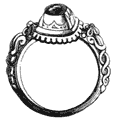 Fig. 172. |
 Fig. 173. |
We close our review of the art of ring-making in the sixteenth century with two very beautiful examples. Fig. 172, from the Londesborough collection, has a ruby in a very tall setting, enriched by enamel. The sides of the hoop are highly decorated with flowers and scroll ornament, also richly enamelled. The Waterton collection gives us Fig. 173, a gold enamelled ring, set with a large turquoise in the centre, and surrounded by six raised garnets. This ring is stated to have subsequently belonged to Frederick the Great, King of Prussia, whose cipher is upon it.
Fig. 174. |
Fig. 175. |
We must not, however, end this portion of our history without a reference to the simple, but most important, “plain gold ring” of matrimony. It was at this time almost universally inscribed with a “poesy” of one or two lines of rhyme. Two specimens are here engraved. Fig. 174 is formed like the badge of the Order of the Garter, with the buckle in front, and the motto of the order outside the hoop; withinside are the words “I’ll win and wear you.” The ordinary form of ring is shown in Fig. 175, and is inscribed “Let likinge laste.” They were invariably inscribed withinside the hoop. Thus Lyly, in his “Euphues,” 1597, addressing the ladies, hopes they will favour his work, “writing their judgments as you do the poesies in your rings, which are always next to the finger, not to be seen of him that holdeth you by the hand, and yet known by you that wear them on your hands.” Such jingling rhymes were in great request, and exerted the ingenuity of poetasters and small wits. In 1624 a small collection of them was printed, with the quaint title, “Love’s Garland; or poesies for rings, handkerchiefs, and gloves, and such pretty tokens that lovers send their loves.” They are generally in double, seldom in triple lines of rhyme. The Rev. R. Brooke, of Gateforth House, Selby, has presented a curious collection of such rings to the South Kensington Museum. The[143] six following poesies are selected from this series, as they are good examples of the average inspirations of ring-poets:—
“Seithe God hath wrought this choice in thee,
So frame thyselfe to comfourth mee.”
“United hearts death only parts.”
“Let us share in joy and care.”
“A faithfull wife preserveth life.”
“As God decreed, so we agreed.”
“Love and live happily.”
The custom of thus inscribing rings continued until the middle of the last century. There is a story told of Dr. John Thomas, Bishop of Lincoln, in 1753, that he inscribed his fourth wife’s ring with these words:—
“If I survive
I’ll make them five.”
Horace Walpole says—“My Lady Rochford desired me t’other day to give her a motto for a ruby ring,” so that at that time poesies were not confined to wedding rings.
Allusion has already been made in Chapter I. to the custom of using rings as receptacles for relics or poisons. The most famed belonged to Cæsar Borgia, son of Pope Alexander VI., both adepts in poisoning; a grasp from the hand wearing this ring ensured a very slow, but certain death: it contained a virulent poison, which found vent through a small spike, pressed out by a spring when the hand was grasped, and which was so slight in its operation as to be scarcely felt, and not usually noticed[144] by the person wounded during the excitement of the hearty friendship so well simulated. When conspiracies against the life of William of Orange were rife under the influence of the court of Spain [circa 1582], the unworthy son of Count Egmont “had himself undertaken to destroy the prince at his own table by means of poison which he kept concealed in a ring. Saint Aldegonde (his friend and counsellor) was to have been taken off in the same way, and a hollow ring filled with poison is said to have been found in Egmont’s lodgings.”144-*
 Fig. 176. |
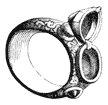 Fig. 177. |
Fig. 176 represents a curious Venetian ring, the bezel formed like a box to contain relics. The face of the ring (in this instance the cover of the box) has a representation of St. Mark seated, holding his gospel, and giving the benediction. The spaces between this figure and the oval border are perforated, so that the interior of the box is visible, and the relic enshrined might be seen. Fig. 177 is another ring of the same construction: it is richly engraved and set with two rubies and a pyramidal diamond; the collet securing the latter stone opens with a spring,[145] and exhibits a somewhat large receptacle for such virulent poisons as were concocted by Italian chemists in the sixteenth and seventeenth centuries.
The elaborate character of design adopted at this time for Venetian rings, the highly artistic taste that governed it, as well as the beauty of the stones employed in settings, combined to perfect bijouterie that has never been surpassed. Fig. 178 is a ring of very peculiar design. It is set with three stones in raised bezels; to their bases are affixed, by a swivel, gold pendent ornaments, each set with a garnet; as the hand moves these pendants fall about the finger, the stones glittering in the movement. This fashion was evidently borrowed from the East, where people delight in pendent ornaments, and even affix them to articles of utility. Fig. 179 is a ring of silver, of East Indian workmanship, discovered in the ruins of one of their most ancient temples; to its centre are affixed bunches of pear-shaped hollow drops of silver, which jingle with a soft low note as the hand moves.
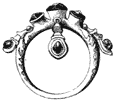 Fig. 178. |
 Fig. 179. |
We have already alluded to the old Eastern tale of “The Fish and the Ring,” invented some thousands of years since. It has[146] survived to our own day, and is still related and believed by the commonalty to the east of London. In the church at Stepney is a tomb to the memory of Lady Rebecca Berry, who died 1696, in whose coat-of-arms a fish and an annulet appear. She has hence been supposed the heroine of a once popular ballad, the scene of which is laid in Yorkshire; it is entitled, “The Cruel Knight, or Fortunate Farmer’s Daughter,” and narrates how one of knightly rank in passing a village heard the cry of a woman in travail, and was told by a witch that he was pre-doomed to marry that girl on her arrival at womanhood. The knight in deep disgust draws a ring from his finger, and casting it into a rapid river, vows he will never do so unless she can produce that ring. After many years a fish is brought to the farmer’s daughter to dress for dinner, and she finds the ring in its stomach, enabling her to win a titled husband, who no longer fights against his fate.
The civic arms of Glasgow exhibit a fish holding a ring in its mouth. This alludes to an incident in the life of St. Kentigern, patron of the See, as related in the “Acta Sanctorum.” The queen, who was his penitent, had formed an attachment to a soldier, and had given him a ring she had received from her husband. The king knew his ring, but abided his revenge, until one day discovering the soldier asleep by the banks of the Clyde, he took the ring from his finger and threw it in the stream. He then demanded of his queen a sight of his old love gift, a request she was utterly unable to comply with. In despair, she confessed all to St. Kentigern, vowing a purer life in future. The saint[147] went to the river, caught a salmon, and took from its stomach the missing ring, which restored peace to all parties.147-*
The occurrence of the fish and ring in the arms of Glasgow and in the Stepney monument, is “confirmation strong as proofs of holy writ” of the truth of these stories, in the minds of the vulgar, who would regard scepticism in the same light as religious infidelity.
 Fig. 180. |
 Fig. 181. |
Memorial rings were sometimes made to exhibit a small portrait, and on some occasions to conceal one beneath the stone. Such is the ring, Fig. 180, from the Londesborough collection, which was made for some devoted adherent of King Charles I., when such devotion was dangerous. A table-cut diamond is set within an oval rim, acting as a lid to a small case opening by means of a spring, and revealing a portrait of Charles executed in enamel. The face of the ring, its back, and side portions of[148] the shank, are decorated with engraved scroll-work, filled in with black enamel. “Relics” of this kind are consecrated by much higher associations than what the mere crust of time bestows upon them; and even were they not sufficiently old to excite the notice of the antiquary, they are well deserving of attention from their exhibiting “memorials of feelings which must ever command respect and admiration.” Horace Walpole had in the Strawberry Hill collection, “one of the only seven mourning rings given at the burial of Charles I. It has the king’s head in miniature behind a death’s head; between the letters C. R. the motto, ‘Prepared be to follow me.’”
A much more lugubrious memorial is presented from the same collection, Fig. 181. Two figures of skeletons surround the finger and support a small sarcophagus. The ring is of gold enamelled, the skeletons being made still more hideous by a covering of white enamel. The lid of the sarcophagus is also enamelled, with a Maltese cross in red, on a black ground studded with gilt hearts. This lid is made to slide off, and display a very minute skeleton lying within.
These doleful decorations first came into favour and fashion at the court of France, when Diana of Poictiers became the mistress of Henry II. At that time she was a widow, and in mourning; so black and white became fashionable colours: jewels were formed like funeral memorials; golden ornaments shaped like coffins, holding enamelled skeletons, hung from the neck; and watches made to fit in little silver skulls were attached to the waist.
[149]In the Duke of Newcastle’s comedy, The Country Captain, 1649, a lady of title is told that when she resides in the country a great show of finger-rings will not be necessary: “Shew your white hand with but one diamond when you carve, and be not ashamed to wear your own wedding ringe with the old poesy.” That many rings were worn by persons of both sexes is clear from another passage in the same play, where a fop is described, “who makes his fingers like jewellers’ cards to set rings upon.”
The stock of rings described in the same author’s play, The Varietie, as the treasure of an old country lady, is amusingly indicative of past legacies or memorials, as well as of the tastes of the yeomanry: “A toad-stone, two Turkies (Turquoise), six thumb-rings, three alderman’s seals, five gemels, and foure death’s head.” The enumeration concludes with the uncomplimentary observation, “these are alehouse ornaments.”
These death’s-head rings were very commonly worn by the middle classes in the latter part of the sixteenth and the early part of the seventeenth centuries; particularly by such as affected a respectable gravity. Luther used to wear a gold ring, with a small death’s head in enamel, and these words, “Mori sæpe cogita” (Think oft on death); round the setting was engraved “O mors, ero mors tua” (Death, I will be thy death). This ring is preserved at Dresden. Shakspere, in his Love’s Labour’s Lost (Act V. scene 2), makes his jesting courtier, Biron, compare the countenance of Holophernes to “a death’s face in a ring.” We have already adverted to a similar ring worn by one of Shakspere’s fellow townsmen.
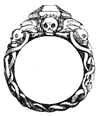 Fig. 182. |
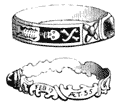 Figs. 183 and 184. |
In the “Recueil des Ouvrages d’Orfeverie,” by Gilles l’Egaré, published in the early part of the reign of Louis XIV., is an unusually good design for one of these rings, which we copy, Fig. 182. It is entirely composed of mortuary emblems, on a ground of black enamel. Fig. 183 is an English memorial ring set with stones; on the circlet is engraved an elongated skeleton, with crossbones above the skull, and a spade and pick-axe at the feet; the ground is black enamel. It has been converted into a memorial by its original purchaser, who caused to be engraved withinside the hoop, “C.R., Jan. 30, 1649, Martyr.” It is now in the Londesborough collection, from whence we obtain Fig. 184, a very good specimen of a mourning ring of the early part of the last century, with which we take leave of this branch of the subject.
 Fig. 185. |
 Fig. 186. |
The jewellers of the last century do not seem to have bestowed the same attention on design as their predecessors did. Rings appear to have reached their highest excellence in design and execution in the ateliers of Venice. We meet with little originality of conception, and certainly great inferiority of execution, in the works then issued. In southern Europe, where jewellery is[151] deemed almost a necessary of life, and the poorest will wear it in profusion, though only made of copper, greater scope was given to invention. Fig. 185 is a Spanish silver ring of the early part of the century. In its centre it has a heart, winged and crowned; the heart is transfixed by an arrow, but surrounded by flowers. It is possibly a religious emblem. Fig. 186 is another Spanish ring of more modern manufacture, but of very light and elegant design. The flowers are formed of rubies and diamonds, and the effect is extremely pleasing.
 Fig. 187. |
 Fig. 188. |
Such works may have originated the “giardinetti” rings, of which a good collection of specimens may be seen in the South Kensington Museum, two being here copied in Figs. 187 and 188. They are there described as English works of the seventeenth and eighteenth centuries, and appear to have been used as guards, or “keepers,” to the wedding-ring. They are of pleasing floriated design, and of very delicate execution. Much taste may be[152] exhibited in the selection of coloured stones for the flowers of such rings, which are certainly a great ornament to the hand.
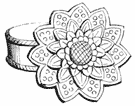 Fig. 189. |
 Figs. 190 and 191. |
Recurring to the Eastern nations, in whose eyes jewellery has always found great favour, we find that the Indians prefer rings with large floriated faces, spreading over three fingers like a shield. When made for the wealthy in massive gold, the flower leaves are of cut jewels, but the humbler classes, who equally love display, are content with them in cast silver. Such a ring is engraved, Fig. 189, from an original in the British Museum, from whence we also obtain the two specimens of rings beside it, being such as are worn by the humblest classes. Fig. 190 is of[153] brass, Fig. 191 of silver, the latter boasting a sort of apology for a jewelled centre.
 Fig. 192. |
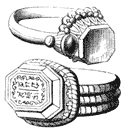 Figs. 193 and 194. |
A triplicate of Moorish rings will enable us to understand their peculiarities. Fig. 192 has a large circular face, composed of a cluster of small bosses, set with five circular turquoise, and four rubies; the centre being a turquoise, with a ruby and turquoise alternating round it. The ring is of silver. It is in the Londesborough collection, as also is Fig. 193, another silver ring set with an octangular bloodstone, with a circular turquoise on each side. Fig. 194 is a signet ring, bearing the name of its original owner engraved on a carnelian. This also is of silver.
The modern Egyptians indulge greatly in finger-rings. The wife of the poorest peasant will cover her hands with them, though they be only cast in pewter, decorated with gems of coloured glass, and not worth a penny each. For ladies of the higher class very pretty rings are designed. One of them is here engraved (Fig. 195), from an original purchased by the author in Cairo. It is a simple hoop of twisted gold, to which is appended a series of pendent ornaments, consisting of small beads of coral, and thin plates of gold, cut to represent the leaves of a plant. As the hand moves, these ornaments play about the finger, and a very brilliant effect might be produced if diamonds were used in the pendants. Fig. 196 is the ring commonly worn by the middle class Egyptian men. They are usually of silver, set with mineral stones, and are valued as the manufacture of the silversmiths of Mecca, that sacred city being supposed to exert a holy influence on all the works it originates.
[154]There is also a curious ring, with a double “keeper,” worn by Egyptian men, as shown in Fig. 197. It is composed entirely of common cast silver, set with mineral stone. The lowermost keeper of twisted wire is first put on the finger, then follows the ring, the second keeper is then brought down upon it; the two being held by a brace which passes at the back of the ring, and gives security to the whole.
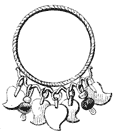 Fig. 195. |
 Fig. 196. |
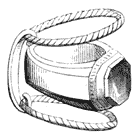 Fig. 197. |
At the commencement of the present century, “harlequin-rings” were fashionable in England. They were so called because set round with variously-coloured stones, in some way resembling the motley costume of harlequin. To these succeeded “regard-rings,” the stones selected so that the initial of the name of each spelt altogether the word regard, thus:—
[155]These pleasing and agreeable gages d’amitie originated with the French jewellers, and were soon made to spell proper names. Where precious stones could not be obtained with the necessary initial, mineral stones, such as lapis-lazuli, and verde antique, were pressed into the service. These rings are now occasionally made. Her Royal Highness the Princess of Wales is said to possess one having the familiar name of the Prince, “Bertie,” spelt thus upon it.
 Fig. 198. |
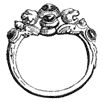 Fig. 199. |
With two specimens of modern French work we close our selection of designs. Fig. 198 is a signet ring, the face engraved with a coat-of-arms. At the sides two cupidons repose amid scroll-work partaking of the taste of the Renaissance. The same peculiarity influences the design of Fig. 199. Here a central arch of five stones, in separate settings, is held by the heads and outstretched wings of Chimeras, whose breasts are also jewelled. Both are excellent designs.
The last ring we shall bring before the reader’s notice (Fig. 200) is the famous “Fisherman’s ring” of the Pope. It is a signet ring of steel used for the briefs issued from the Romish Court.[156] “When a brief is written to any distinguished personage, or has relation to religious or general important matter, the impression from the Fisherman’s ring is said to be made upon a gold surface; in some other cases it appears upon lead; and these seals are generally attached by strings of silk. Impressions of this seal are also made in ink direct upon the substance on which the brief is written.” Mr. Edwards calls attention to the classic form of the boat and oar, showing direct derivation from an antique original. The seal is also made in the fashion of a Roman signet. A new one is made for every pope, and Mr. Edwards thus narrates the ceremonies connected therewith:—“When a pope dies, the Cardinal Chamberlain, or Chancellor, accompanied by a large number of the high dignitaries of the papal court, comes into the room where the body lies, and the principal or great notary makes an attestation of the circumstance. Then the Cardinal Chamberlain calls out the name of the deceased pope three times, striking the body each time with a gold hammer, and as no response comes, the chief notary makes another attestation. After this the Cardinal Chancellor demands the Fisherman’s ring, and certain ceremonies are performed over it; and then he strikes the ring with a golden hammer, and an officer destroys the figure of Peter by the use of a file. From this moment all the authority and acts of the late pope pass to the College or Conclave of Cardinals. When a new pope is consecrated, it is always the Cardinal Chancellor, or Chamberlain,[157] who presents the renewed Fisherman’s ring, and this presentation is accompanied by imposing ceremonies.”
The facts we have gathered about finger-rings are scattered over the history of many ages and nations; and in the selection of illustrations we have been guided by their historic value as well as their artistic merits, so that they may be referred to as authorities to test the age and country of other works of their class, if brought to them for comparison.

74-* “History and Poetry of Finger-rings.”
74-† Genesis, chap. xxxviii.
75-* “Manners and Customs of the Ancient Egyptians,” vol. iii. p. 373.
82-* Barrera, “History of Gems and Jewels.”
83-* “Decline and Fall of the Roman Empire,” chap. xxv.
83-† “The History and Poetry of Finger-rings,” by Charles Edwards.
89-* “Antiquité Expliquée et Representée en Figures.”
96-* “Account of Excavations at Harnham Hill.” Archæologia, vol. xxxv.
96-† “Remains of Pagan Saxondom,” p. 71.
97-* In the museum at Augsburg are several which were found in cutting for the railway near that city. A large series of personal ornaments is also preserved there, which are so exactly similar to others found near Richborough, in Kent, that they would appear to have come from the same manufactory. As the Romans introduced their arts wherever they went, so the Saxons seem to have continued theirs in all their colonies.
98-* See the “Inventorium Sepulchrale: an Account of some Antiquities dug up by the Rev. Bryan Faussett, of Heppington, Kent.” Edited by C. Roach Smith.
100-* Engraved as an illustration to the volume describing the congress of the British Archæological Association at Winchester, in 1845.
108-* He was elected 1418, and died 1464.
115-* J. Y. Akerman on Gnostic Gems, in Archæologia, vol. xxxii.
116-* T. Wright, M.A., &c., in Archæologia, vol. xxx.
117-* Masarius, quoted in Topsel’s “History of Serpents,” 1611.
136-* He was a draper; and his seal has a device upon it consisting of a skull with a bone in the mouth; the letters W. S. are under it, and very small. This ring was most probably of silver. It is unlikely that a small trader like Smith should wear a heavy gold ring, like this which claims to be Shakspere’s.
136-† The concluding words of the will are—“in witness whereof I have hereunto put my seale,” the last word being struck through with a pen, and hand substituted.
137-* Heminge was the old stage-manager, who, like Shakspere, became very wealthy by the profession. Burbage was the great tragedian, and the original performer of Richard III. Condell was a comedian, part-proprietor of the Globe Theatre; it is to him and Heminge we are indebted for the first complete edition of Shakspere’s works, the folio of 1623.
144-* Motley’s “Rise of the Dutch Republic.”
147-* In the Koran this wild version of the story occurs:—“Solomon entrusted his signet with one of his concubines, which the devil obtained from her, and sat on the throne in Solomon’s shape. After forty days the devil departed, and threw the ring into the sea. The signet was swallowed by a fish, which being caught and given to Solomon, the ring was found in its belly, and thus he recovered his kingdom.”—Sale’s Koran, chap. xxxviii.
Every artist who paints an historical picture knows the difficulty of obtaining the necessary minutiæ, in order to give vraisemblance to his picture, as the authorities are widely scattered, and can only be brought together by those who know where to look for them; for often they lie hidden in illuminated MSS., or in books of considerable rarity, seldom looked at by the general reader, and only fully appreciated by literary men and students. We propose to show how varied and curious the history of any article of dress becomes if studied carefully, and how such minor details indicate clearly defined periods, as faithfully as any other historic data left for our guidance.
The use of the fibula, or brooch, was, in all probability, first adopted by men to secure the outer cloak upon the shoulders. It originated among the ancient Greeks, and appears to have been considered as a characteristic of Greek costume, even after it had long been adopted by the Romans, as may be understood from a passage of Suetonius in his life of Augustus. “He distributed among various other persons, togæ and pallia, and made a law that the Romans should wear the Greek habit, and the Greeks the[162] Roman habit;” that is, that the Greeks should wear the toga, and the Romans the pallium. Now, though it is certain that the pallium, or cloak, was peculiar to the Greeks, and that many authors, besides Suetonius, testify the same, yet it is as evident that this article of dress became afterwards the common habit of Greeks and Romans.
The earliest form in which we meet with a fibula is that of a circular disc, having a pin crossing it behind, which passed through the folds of the cloak, and was hidden from sight by this outer disc. It retained that form for ages, and is rarely seen upon antique monuments in any other shape. It is very clearly represented upon the statue of Paris, as shown in Fig. 201. It will be seen that the cloak covered the left arm, the opening being upon the right one, where the brooch reposed on the shoulder, leaving the right arm free. There is a very beautiful and well-known antique statue of Diana, representing the goddess fastening her mantel in the same manner.
[163]The character of this outer garment varied with the seasons, but whether heavy and warm, or light and cool, it was usually plain in its character, or simply decorated with a border, and corner ornament. Sometimes, when worn by great personages, it appears to have been decorated with needlework, and shot with threads of gold. Such a one is described in the Odyssey (book xix.) as worn by Ulysses:—
“In ample mode
A robe of military purple flow’d
O’er all his frame: illustrious on his breast
The double-clasping gold the king confest.
In the rich woof a hound, mosaic drawn,
Bore on full stretch, and seized a dappled fawn:
Deep in the neck his fangs indent their hold;
They pant and struggle in the moving gold.”
When the brooch secured the short military cloak of the Romans, it was usually worn in the centre of the breast. As the desire for personal display increased, a brooch was worn on each shoulder; the ladies often wearing a row of them to close the sleeve left open down the arm. Occasionally, they were also used to fasten the tunic above the knee, in the way that Diana,
“Queen and huntress, chaste and fair,”
appears to have secured hers before she indulged in the chase.
As luxury increased in the Roman Empire, these articles of utility became also ornaments of much cost and splendour. The art of the goldsmith was devoted to enrichments for them; that of the enameller to brilliant colouring. They increased in size greatly, and became distinctive of rank and wealth. The influence[164] of Eastern taste, when the seat of royalty was transferred from Rome to Constantinople, was visible in the jewellery afterwards usually worn; nor was the taste by any means confined to the fair sex, the men in the East being still as fond of jewellery as the ladies of the harem. The poorest persons eagerly wear what their limited means allow, and load themselves with cheap ornaments, although a pound weight of them would not be worth five shillings.
These enamelled brooches are frequently found in places where Roman towns once stood. They may, in fact, be said to abound in most museums. We select two, as examples, from the York Museum, a collection singularly rich in relics of Roman art. York was one of the most important stations in England, and here died the Emperor Septimus Severus, in the year 211, at the age of sixty-five, “worn out with anxiety, fatigue, and disease,” says the Rev. C. Wellbeloved, the historian of York. He had returned from his successful war in the north, but had achieved victory with the loss of fifty thousand of his soldiers. Caracalla, his eldest son, was with him at the time, but immediately set out for Rome. In the year 304, when the empire was divided between the Cæsars, Galerius, Maximianus, and Constantius Chlorus, Britain fell to the share of the latter, who immediately came over, and fixed his residence in York. He died two years afterwards, and his son, Constantine the Great, by Helena, a British princess, succeeded him, being proclaimed emperor by the army at York, where he was at the time of his father’s death. The first of these elegant brooches is of circular form (Fig. 202), like a raised shield divided[165] into several compartments. The side view placed with it will enable the reader to understand the arrangement of the pin, which moves freely on a pivot, the point held by a curve in the lower projecting bar. The second example (Fig. 203) was found near Bootham bar, and is of more elaborate design. The raised centre is divided into ornamental compartments, filled with rich purple and white enamel colours. The point of the pin is here brought closer to the brooch, as if it had been intended to fasten a finer kind of material than the preceding one, which from its width would take in a coarser texture.
[166]The use of enamel colours as enrichments to metal ornaments belongs to the later days of Rome. Sometimes the work is very coarse, but specimens occur (though rarely) of extremely delicate execution. It was executed in what the French antiquaries term the champ-levé manner; that is, the part to be enamelled was cut, or hollowed, by a graving tool, in the surface, and then filled with fusible colours, rubbed when cool to a level surface. This decoration was not confined to small articles of jewellery, but was used for belts and sword-handles. An admirable example of a small bronze vase, thus beautifully enriched, was found in excavating the triple tumuli popularly known as the Bartlow Hills, in Cambridgeshire. Horse-trappings were highly enriched in the same manner. Boxes, and small articles of furniture, were also inlaid with enamelled plaques of metal.
A tendency to great variety of design characterised the jewellery of the Byzantine empire; and the old circular fibula, that had been worn contentedly for so very many centuries, was discarded for new forms; which were again cast aside at the caprice of the wearer, attracted by the ever-varying designs of the jeweller. The bow or harp-shaped fibula, however, retained its place when once introduced, nearly as long as its circular forerunner. One of the finest specimens of a fibula of this kind is here given, copied from the original, which was discovered about twenty years ago by labourers employed on the railway near the town of Amiens, at a spot where other objects of the Gallo-Roman period were met with. The place may probably have been the cemetery of the town, when the masters of the world[167] ruled there. The workmen found a leaden coffin of great thickness, which contained two skeletons, the smaller having within it many articles of female ornament. These consisted of a pair of gold ear-rings of very peculiar and original design; a gold ring set with a carnelian, on which was engraved a youthful figure riding on a goat; a pair of slender armlets of gold; a pendent ornament of glass, evidently formed to wear as a charm to keep off the baneful effect of the evil eye, so much dreaded by the ancients; and this buckle (Fig. 204). The latter is constructed of the finest gold, the bow decorated with an upright row of pellets, and three small flowerets across the centre. The shaft is covered with most delicate chased ornament, or reeded patterns, soldered to the surface; a row of raised studs are each in the middle of a curved quatrefoil, the outer border raised in lines of indented decoration. The whole bears traces of the influence of Greek art, the workmen of that highly-cultivated and artistic nation always excelling their Roman brethren, and the richer classes in Rome patronising them in preference. Nothing can exceed the delicacy and beauty of Greek jewellery; the Roman being of a heavier and less artistic taste. The character of the two nations may thus be clearly traced in so insignificant an article as a breast-pin.
Figs. 205 and 206 represent two of the most ordinary forms of the bronze bow-shaped fibulæ, as worn by the ordinary classes. Fig. 205 was found at Strood, in Kent, in a brick-[168]field opposite Rochester Castle, on the other side of the Medway, which field had been the cemetery of the city when the Romans ruled it.
 Fig. 205. |
 Fig. 206. |
The reader will notice, in both the latter instances, the pin is a continuation of a coil of strong metal, of which it is formed, and which gives it great strength and elasticity. When the latter was passed through the several folds of the dress, and the end secured in the strong metal catch below, it would not be easy to unfasten the garment or lose the pin. The second example is less stiff in contour, and from it the reader may more clearly comprehend the arrangement for securing the pin. Here, again, the pin proceeds from spirals at the upper part of the brooch.
These common articles were sometimes made more attractive to the eye by decorating the upper portion with coarse enamel colours; a specimen is given in Fig. 207; it is of clumsy form, and cheap construction; it was found, with many other minor antiquities, among heaps of bones, in the well-known caves at King’s Scarr, about two miles north-east of Settle, in Yorkshire—caves that are conjectured to have been the homes of the old Britons who once lived a semi-savage life in them.
In the excellent museum at Boulogne are preserved many articles found in the immediate neighbourhood, and belonging to[169] the Gallo-Roman period. Among them is the bronze fibula Fig. 208, which shows the very decided arc formed by the upper part, and the mode by which the point of the pin was secured in the sheath below.
 Fig. 207. |
 Fig. 208. |
Sometimes these bow-shaped fibulæ were made with an extremely large and ugly bow, as in Fig. 209, which hung over the dress. They are occasionally met with six inches in width, with a pin an inch or two longer: being used for the heavier winter cloaks. The gore-shaped pendant is made hollow, and is often decorated with incised lines and zigzag patterns. They appear to have been in most favour among the Roman provincials in Gaul and Britain, particularly as the nature of the winters obliged them to seek in the heavy woollen sagum, or in the skin mantle, some greater protection against the inclemency of the weather than their southern conquerors required.
Allusion has already been made to the extreme taste for showy jewellery, and gaudy personal decoration, indulged in by the later Roman rulers, after the seat of government had been removed[170] to Constantinople. It seems to have increased as their power decayed: for the rude paintings and mosaics of the eighth and ninth centuries depict emperors and empresses in dresses literally covered with ornament and jewellery—indeed, the artists must have put forth their best strength in depicting the dresses, as if they had received similar orders to those given by good Mrs. Primrose, who expressly desired the painter of her portrait to put as many jewels on her stomacher “as he could for the money.”
Fig. 210, the bust of the Emperor Constantine Pogonatus (so called from the ample beard the monarch wore), is an example of male foppery. This emperor came to the throne A.D. 668, and died in 685. It will be perceived that two brooches fasten his outer garment, one upon each shoulder. That upon the right one is highly enriched, but the original, as really worn by the emperor, was most probably much more so, by chasing, enamel, and jewels which the artist had not space, or perhaps ability, to express. From it hang three chains, which were most probably formed of hollow gold beads, cast in an ornamental matrix; such having been found in Crimean graves; and[171] less frequently in those of the Germanic and Gaulish chieftains and aristocrats. To the ends of these chains were affixed circular ornaments, sometimes decorated with enamel, like the York fibulæ already described, and sometimes with cameos, set in a gold framework: for as the Arts decayed, the finer works of this kind, executed in the palmy days of Rome, were much prized and valued as the works of a race who were acknowledged to be mentally superior.
The empresses naturally wore a greater abundance of jewellery than their lords; they also wore great circular brooches on each shoulder, but they increased the pendent ornaments by adding heavy gold chains, which hung across the breast, and from the brooches on both sides nearly to the waist; at the ends of these chains was a group of smaller chains, each supporting a jewel of varied form, so that a heavy bunch of them was formed. Ultimately other chains with pendent jewels were attached to the chain that passed across the breast, and completely covered that part of the person with decoration.
In the museum at Mayence is preserved a very curious monumental sculpture, upon which is presented the effigy of the man for whom it was erected, his wife, and son. He was a sailor, who died at the ripe age of seventy-five, and appears to have been generous to his lady in the article of jewellery, according to the usual habit of his craft. Mr. C. Roach Smith, who first published this curious monument in his “Collectanea Antiqua,” observes that “she had evidently dressed for the portrait.” She wears a vest, fitting closely to the arms and bust, and at the neck[172] gathered to a frill, which is enclosed by a torque, or gold necklet. Over this hangs a garment, which falls gracefully down in front, and is crossed at the breast over the left arm. The jewellery of the widow is of no common description, nor niggardly bestowed. Upon the breast, below the torque, is a rose-shaped ornament or brooch, and beneath that a couple of fibulæ; two more of a similar pattern fasten the upper garment near the right shoulder, and upon the left arm, just above the elbow; an armlet encircles the right arm, and bracelets the wrist. Fig. 211 gives the upper portion of the form of this lady: judging from the style of her head-dress she may have lived in the reign of the Emperor Hadrian. Probably many years younger than her sailor-husband,[173] she appears to have tempered her grief with judgment, and to have taken advantage of his death to set herself forth to the world in her gayest costume.
As barbarism increased, and subverted good taste, brooches of the most absurd forms were invented, and made more grotesque by unnatural enamel colours. Birds, fish, men on horseback, formed the face of these brooches, which would never have been understood by a modern eye, had they not been found with the pins attached to them behind. Three examples from the great work of Montfaucon are given in Figs. 212, 213, and 214, they were found in Italy and Germany. The first represents a combination of two warlike implements on one handle—the upper one an axe, the lower a bipennis. The second specimen is made like a bird: we have given it at an angle, to show the way the pin was fastened at the back of it. The third specimen is a fish, which might pass as a fair representation of some member of the finny tribe, whose proper name need not be too curiously asked for; but unluckily the designer of the brooch, indulging in the[174] grotesque, has represented some monstrous bird with bat’s ears emerging from one side of the fish.
 Fig. 215. |
 Fig. 216. |
We give two specimens, one from the banks of the Rhine, the other found opposite our own shores. Fig. 215 represents a bird, probably of the hawk kind, whose eye has been made the socket for a garnet, and the extremity of his tail a receptacle for another piece of jewellery. It was found on the site of the Roman station at Cologne. Fig. 216, which is of plain bronze, is more fortunate as an attempt to represent a cock; it was discovered, with many other curious antiquities, at Etaples, near Boulogne, and is preserved in the museum of the latter town.
A very distinct character pervades the ornamental works of the ancient nations that once inhabited the British Isles.
A curious discovery of the fibula, Fig. 217, was made at Stamford, Lincolnshire. It was found in the process of enlarging a stone-pit in the parish of Castle Bytham. It is described by Mr. Akerman, in his “Pagan Saxondom,” as “a[175] ring fibula, of white metal, gilt, in very excellent preservation, and set with four gems closely resembling carbuncles. An irregular interlacing pattern is worked over the whole front surface, but it is perfectly plain behind.” Mr. Akerman is inclined to think that it has a Scandinavian character, and favours the supposition that its owner was a Danish lady.
This supposition seems borne out by the researches of Dr. Davies, in his interesting ethnographical sketch of the various ancient populations who have invaded and inhabited Anglia[176] in pre-historic times, prefixed to that very valuable work, the “Crania Britannica.” He is of opinion that about the time of Cæsar, the population of our island throughout the northern and midland counties was derived from the tribes of Jutland and North Germany, and that the southern portions of the island were exclusively filled by the Saxon immigrants.
A fibula of very peculiar form is found in these northern counties in great abundance. We give an example in Fig. 218. It is of bronze, and was found at Driffield, Yorkshire, in the grave of a female. Sometimes these fibulæ are richly ornamented with interlaced patterns, and heads of strange birds and animals. They are then generally gilt, and have been found of enormous size, eight inches in length by six in breadth. I imagine these very large brooches fastened the heavy outer cloak, the smaller being used for lighter portions of the dress.
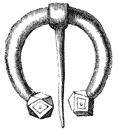 Fig. 219. |
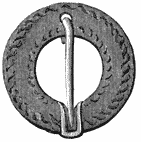 Fig. 220. |
The ordinary form of brooch worn by the humbler classes is shown in the two specimens (Figs. 219 and 220), both are of bronze,[177] with very slight attempt at ornament, and were found by labourers employed in repairing the road on the line of the Watling Street, about a mile from the Romano-British settlement at Cesterover, between Bensford Bridge and the road leading from Rugby to Lutterworth.
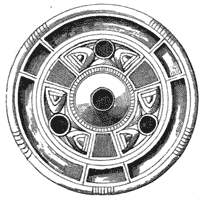 Fig. 221. |
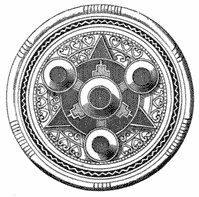 Fig. 222. |
Two specimens of the circular fibulæ of the southern Anglo-Saxons are given in Figs. 221 and 222. They were both found in Kent, where the wealthiest and most refined Saxons were located. It is curious to note how completely in design and execution they resemble such as are found in South Germany. In the Augsburg Museum are some identical in design and execution with Kentish specimens in the Mayer Museum at Liverpool. They appear as if made by the same workmen.
These fibulæ are generally much enriched on the upper surface. A soft enamel, or slices of pearl (which have generally perished), probably filled the outer rim in Fig. 221; the centre[178] is here raised, and is formed of pearl, in the centre of which is a garnet, and slices of garnet are cut to fit the triangular ornaments; to give them greater brilliancy, they are laid on a thin piece of gold foil. Fig. 222 is of more elaborate design; the use of garnet is again apparent, but the spaces between the jewellery are filled with a double row of incurvated ornaments, made of fine threads of gold; sometimes these threads of gold are reeded, or plaited, of two or three finer gold threads. I have been assured by practical goldsmiths that more delicate work could not be done in the present day. All these small ornaments are made singly, and then fastened in their places. They excite astonishment at the great refinement that must have characterised the Anglo-Saxons, and which is carried out in other articles found in their tumuli.
Fig. 223 represents a group of Anglo-Saxon pins. The first specimen is of the simplest design, with no attempt at ornament, except the double cross roughly incised in the bronze. The middle pin, on the contrary, is one of the finest kind; the head is ornamented with jewellery and goldsmith’s work, the stem is of bronze. The pin beside it is of silver gilt, the centre decorated with a raised garnet. I have placed in front of them a very remarkable specimen of a double pin, connected by a chain, exactly similar to such as were universally fashionable a few years ago. Though fashion may be “ever changing,” it is not “ever new.”
The ancient Irish brooch was unlike others worn in Scotland or England. It had a long central pin, with an open ring at its[179] summit, allowing free motion to the bar which passed through it, and formed a half-circle, supporting a lunette-shaped pendant, covered with elaborate decoration and jewellery. They varied in size and decoration according to the rank of the wearer. The highest price of a silver one for a king, according to Vallancey, was thirty heifers, when made of refined silver; the lowest value attached to them being three heifers. I have seen a very large specimen, of the intrinsic value of three pounds. The pin is 9½ inches long, and the circular brooch 5 inches in diameter.[180] Larger specimens have been found and mistaken for poniards. They were made thus large and strong to pass easily through the thick woollen garments necessary to the cold, wet climate.
This old style of design in ornament continued in use in Ireland until the twelfth or thirteenth century—in fact, until the inhabitants had destroyed its civilisation by internecine war. Many works, like the bell of St. Patrick at Belfast, might, at the first glance, be attributed to the same era as the famous “Durham book,” or book of St. Cuthbert, now one of the chief treasures of the British Museum library, and which is[181] believed to have been executed as early as the seventh century by Eadfrith, afterwards of Lindisfarne, who died in 721. We are, however, certain as to the date of the bell, for an inscription is upon it, stating it was made to the order of Donnell O’Lochlain, one of the old Irish kings, who came to the throne in 1083, and died in 1121.
The first brooch discovered in Ireland is in the possession of Mr. Waterhouse, the goldsmith, of Dublin. It is represented in[182] Fig. 224, and is engraved the full size of the original, but the length of the long plain pin has been curtailed. It was found accidentally by a peasant near Drogheda. It is of bronze, decorated with gems and ornament in enamel, and may probably be of no earlier date than the bell just alluded to.
A simpler kind of ornamental pin was worn by the lower classes, of which I give two specimens in Fig. 225, a, b. They are engraved about half the size of the originals. The first is a plain pin, with a small ring hanging from its head. The second is unique in its character, having an old man’s head at its summit: it is of bronze, gilt. As we descend in the scale of rank, these pins become plainer, the poorer classes using them of bone, roughly fashioned by themselves.
The common kind of Scottish pins was of very similar[183] character, as the example placed beside those last described will show. The head of the pin c projects some distance in advance of it, as seen in the side view. A small cross is in the centre of the upper part; the other ornament is convoluted, and is brought into relief by chasing.
The ordinary form of the later Scottish brooch is that of a broad open circle, decorated with intricate knot-work, or floral designs. Dr. Wilson, in his “Archæology and Pre-historic Annals of Scotland,” has engraved one very similar, and says, “The interlaced knot-work appears to have been a favourite device of Celtic art (Fig. 226). It occurs on the sculptures, the jewellery, the manuscripts, and the decorated shrines and bookcases of Early Irish Christian art, and has been perpetuated almost to our own day on the weapons and personal ornaments of the Scottish Highlanders.”
“The brooch has always been a favourite Celtic ornament, and is, indeed, almost indispensable to the Highland costume. It is worn universally by the Scottish Highlanders, both male and female; and in many Highland families of various ranks, favourite brooches have been preserved through many generations as heirlooms, which no pecuniary inducement would tempt their humblest owner to part with.”

Dürer is the one great name which represents early German art in its pure nationality. In his works we see all its peculiarities and may study all its merits. It is not without its defects also, but as they may be honestly considered a part of the whole, it becomes a necessary thing to[188] consider them with the beauties to which they may be conjoined; nor must we be deterred in our search for the latter quality by such occasional drawbacks, if we would investigate the efforts of the artist-mind toward excellence, for that was its characteristic feature from the fall of Rome to the period in which Dürer flourished. In the somewhat gaudy glories of the Byzantine school, we can trace only the failing powers of a great empire conscious of its old dignity but not fully able to display it. In the barbaric night which succeeded, we find art sunk to the most childish attempt at imitating simple nature; which was “copied most vilely.” In the thirteenth and fourteenth centuries we trace the latent wish for the delineation of beauty struggling again into life; but it was simply the wish rather than the power to delineate the graceful, that we find displayed in the contorted figures which the artists of these days attempted to picture as graceful beings. Still, crude and strange, or even grotesque, as they may appear, they are not to be despised. Amid much that is repulsive to modern cultivated taste, we occasionally find naïve delineations of simple beauty, natural expression, and touches of human pathos, which tell how honestly and how eagerly these old artists worked; how truly they wished to do more than they had power to accomplish; and though clogged to the earth by the dark age they lived in, how earnestly they wished to soar above that position. The archaisms of old Greece are not better than such works; and as we can trace the onward course of those ancient masters of art from the rude outlines on the vases of Etruria, to the glorious works of Phidias and Praxiteles—even so, if we wish to know the true course of[189] the revival of modern art, must we trace it in the sculpture, wall-painting, and missal-drawing, of the middle ages, until we find it assume a more definite and better-regulated style in the fifteenth century; that period of the revival of classical tastes, and bright day-spring of art in Italy, from which we ourselves still drink inspiration as from the “well undefiled.”
The influence of the Italian school after the era of Raffaelle may be said to be paramount. As his works became known and studied, they gave laws to other artists; and the mannerisms and peculiarities of earlier schools were softened down and disappeared. Gothic art—if such a term may be applied to the art which was the hand-maiden of Gothic architecture (the term Gothic being by no means understood as meaning barbaric)—had run its course by aid of its own experience alone, possessing qualifications of its own, but being in some degree more remarkable for its strength of feeling than grace of expression. The Italian school inoculated it with elegance; but it naturally possessed an independent power, together with a vigour and native grace which rewarded those who sought for it, rather than courted them by its palpable display. Gothic art in its native strength, as it had grown gradually and achieved its own position, may be seen in the works of the northern contemporaries of Raffaelle; the study of its rise and progress is no unworthy study of the human mind in its onward course toward excellence, nor should we allow prejudice to weigh with us in contemplating these labours. It has been well observed that “in art as in many other branches of human knowledge and industry, exclusiveness, or the tendency to depreciate that which[190] does not conform to our own taste and feelings, is a fertile source of error and mischief. Such a disposition deprives mankind of the free and unrestrained enjoyment of much that is calculated to cheer and improve them. The naïveté of the early German and Italian painters, the earnest simplicity with which they conceived and expressed the devotional subjects treated by them, and the moral beauty of the subjects themselves, may excite our admiration, without disqualifying us for duly admiring the brilliant breadth of light and shadow of Rembrandt, or the genuine truth and humour of Wilkie.”190-* In this spirit must we study the works of the early native artists of the northern schools, and in this way comprehend their true philosophic position, and the æsthetics of their style.
Germany, a great and powerful nation, was in the fifteenth century the home of northern intelligence; and nowhere was it more fully made visible than in the old town of Nürnberg; it was the centre of trade, the abode of opulence, the patron of literature and the arts. Here, amid congenial spirits, lived Albert Dürer—“in him,” says Dr. Kügler, “the style of art already existing attained its most peculiar and its highest perfection. He became the representative of German art at this period.” To himself and his works, therefore, must we look for a true knowledge of the German school; and to Nürnberg, as it was in his epoch, for an acquaintance with the characteristics of the refined life of the German people. It is no unprofitable labour to unveil these ancient[191] and forgotten times; much in man’s history, great and good, is hidden in the pages of old chronicles, and it is a worthy task to call back forgotten glories that may induce modern emulation, or at least vindicate the true position of the great departed.
“From the barred visor of antiquity,
Reflected, shines the eternal light of truth
As from a mirror.”191-*
The modern traveller who visits Nürnberg will see an old city most singularly unaltered. For the last two centuries it would seem to have remained almost stationary; its inhabitants succeeding each other without a wish for change, living in the old houses of their progenitors, and quietly retaining a certain stolid position which has neither lost nor won in the great battle of life around them. On approaching its walls it is difficult at first to believe that a city so quaint and peculiar still exists intact. It is precisely like looking at a pictured town in an old missal, with its series of square towers, and long curtain wall embracing its entire circumference; its old castle perched on the rock, and its great massive round towers proudly protecting its chief gates upon all sides. There is a strange “old-world” look about everything within these walls also, and we scarcely feel that we have arrived at the nineteenth century as we indulge in the thoughts they call forth. It is a place to dream in over the past, to carry one’s mind away from the bustle of modern life to the thoughtful contemplation of that once enjoyed here by generations long[192] departed. It seems no place for the actual realities of our railroad days, and there is a sort of impertinence in bringing us by such means close to its quiet old walls; you feel thrown, as it were, from the go-a-head rapidities of modern times into the calm, heavy, slow-going days of Kaiser Maximilian, without time to consider the change. It is a place for a poet, one imbued with a love of old cities and their denizens, like Longfellow,—and how admirably in a few lines has he described the feeling it engenders, and the aspect of the city and its suburbs!—
“In the valley of the Pegnitz, where across broad meadow lands,
Rise the blue Franconian mountains, Nürnberg, the ancient, stands.
[193]Quaint old town of toil and traffic, quaint old town of art and song,
Memories haunt thy pointed gables, like the rooks that round them throng.
Memories of the middle ages, when the emperors, rough and bold,
Had their dwelling in thy castle, time-defying, centuries old.
And thy brave and thrifty burghers boasted in their uncouth rhyme,
That their great imperial city stretched its hand through every clime.”
The “uncouth rhyme” was the familiar old proverb which told of the universal trade of the old city, couched in the few words—
Nürnberg’s hand,
Geht durch alle land;
and which may be rendered in our modern vernacular—
“Nürnberg’s hand
Goes through every land.”
This proud boast was more truthful than boasts are in general; its artisans literally sent their handiwork far and wide, their connections were great, and their city was the centre of trade between the East and West; for, prior to the discovery of the circumnavigation of the Cape of Good Hope, it was the depôt for eastern merchandise, which was principally sent with their own productions from Venice and Genoa; its convenient central position in Europe enabling its traders to distribute such produce, and all others coming to it, by means of the Danube and the Rhine to the north and west of Europe. Its own manufacturers were also much esteemed, and their works in metal highly valued, whether consisting of armour for the knight or bijouterie for his lady. The[194] city, in fact, held within its warehouses the combined results of the taste, luxury, and necessities of the age, and was busied in exchanging them with the great trading towns of the low countries,—Bruges, Ghent, and Antwerp,—the trade of the latter rising on the decline of that of old Nürnberg, whose inland position kept it far away from the sea-traffic which resulted from the discovery already alluded to. The religious wars contributed ultimately to accelerate its downfall at the commencement of the seventeenth century, and when peace was again restored, prosperity had flown in the turmoil.
[195]It was during the fifteenth and sixteenth centuries that Nürnberg attained its greatest prosperity. At this time it was a free city of the German empire, possessing an independent domain around it extending twenty-three German miles, and was enabled to furnish the Emperor with six thousand soldiers. Its castle had been the home of these rulers from the twelfth century: memories of such inhabitants may still be traced.
“In the court-yard of the castle, bound with many an iron band,
Stands the mighty linden, planted by Queen Cunigunde’s hand.”
The old tree still overshadows the inner yard of the castle, and the “Heathen Tower” tells of still earlier times. The entire place is full of antique memories; it has no sympathy with modern life; and you stand in its quiet crumbling walls, and expect, if the silence be broken at all, it will be by the heavy tread and clanking echo of a mail-clad knight. Maximilian himself and his knights, so quaintly delineated by Hans Burgmair, might rise from their graves, and enter their old quarters as if they had but left them yesterday, so unchanged is the aspect of the picturesque old castle which crowns the rock, and was erst the proud home of Germany’s proudest rulers.
But why dwell on the past glories of the warlike great? rather let us again quote the words of Longfellow, and exclaim
“Not thy councils, not thy Kaisers, win for thee the world’s regard;
But thy painter Albert Dürer, and Hans Sachs the cobbler bard.”
Of the latter worthy we shall discourse anon; but the place of[196] honour and our primary attention must now be given to the artist.
In the city of Nürnberg, on the 20th of May, in the year 1471, the house of the goldsmith, Albert Dürer, rejoiced over the birth of a son. Albert was thrifty, industrious, and had achieved for himself a good position among the burghers of the old town. He was a native of Cola in Hungary, but had sought congenial employ early in life where patronage was more rife, and had entered the service of the goldsmith, Jerome Haller, who had perfected him in a knowledge of his art, and finding the young man worthy, he had ultimately given him his daughter in marriage, living to rejoice with him over his increasing prosperity, and to congratulate him on the birth of his son, who was destined to bear the same names as his father, and to give them an undying celebrity. The young Albert grew up a handsome, intellectual lad, and his tastes were such as an artistic life in early youth might lead him to. The old goldsmiths were indeed the best patrons of ancient art; but for them an important branch of it—ornamental design—would have wanted the constancy of inventive spur, and the art of engraving and printing from incised plates originated in their workshops. They were intimately connected with the artists of their day; and the greatest among them did not disdain to furnish designs for their artisans. Hence the great variety and flow of fancy exhibited in their works. This intercommunication benefited both parties, and should be a lesson to modern exclusiveness, as it is a sort of key to the reason why the artistic beauty of the past eclipses much of the artisan’s work of the present age; and why also it[197] displays an abundance of creative ingenuity, which can scarcely be compatible with the narrow studio a modern workshop[198] has made itself. The early intercourse of young Dürer with art and artists, spurred him on to desire to occupy himself in greater works than he could find himself employed upon in his father’s house. He had learned nearly all he could learn there, and had diligently acquired the power to execute good works as a goldsmith by the time he had reached his sixteenth year; but he was wearied with the task of copying, and wished to join the ranks of the master spirits of whom he occasionally caught a glimpse in the hours of business. He also would be an artist, and communicated his higher aspirations to his father. The elder Dürer had worked his way patiently on by a slow and steady course, and could not understand why his son, now a good workman, with a fair prospect of equally succeeding in trade, should not be content to do as he had done. He had also that unpoetic thrifty style of looking at the whole question, which led him to consider his son as making a total wreck of the many years’ study which he had already gone through to fit him for the goldsmith’s trade; and he was, consequently, much displeased. He considered the question in the light of a positive loss for an uncertain gain, and somewhat rudely dismissed it from his mind. Like the majority of men, he could not bear that his son should shape himself a new course by the aid of the strong will of his own genius, when he considered the old course the best. He had rested on the hope of his son’s aid, which he saw he was well able to give him; and the prospect of his quietly succeeding him as a thrifty goldsmith of Nürnberg he thought enough to satisfy the most ardent hope. It was long[199] before he could patiently listen to his son’s contrary mode of reasoning, and it was not until the young Albert, by reiterated attacks of earnest argument, closely but carefully enforced, had in some degree shaken him, that he would turn a willing ear to his wishes. Once having done this, and become fully aware of the strength of his son’s hopes, and the eagerness of his aspirations, the elder Dürer changed his whole conduct, and with laudable zeal sought the best artist by whom his son should be instructed. There were always many in Nürnberg, but none had better reputation than Michael Wohlgemuth; he also was an earnest, busy man, constantly employed in many branches of his profession, possessing in fact a great deal of the trading spirit, and therefore he was the man with whom Dürer would most desire to see his son studying. It was ultimately arranged that the young Albert should be bound to him for the term of three years to learn the art of painting.
Wohlgemuth was at this period in the full vigour of his life, and was performing an abundance of labour; he painted pictures, he furnished designs for goldsmiths and artisans, he illustrated books, and was a thriving and prosperous man. His works would not delight any eye now as they once charmed the Nürnbergers. They are essentially stiff and hard, exhibiting the exaggeration of form and attitude which makes early art look grotesque: he was fond of stern drawing, and generally painted a firm black outline to his figures, which has a very harsh effect. His colouring is equally positive, and his saints are generally arrayed in prismatic tints, relieved by the gold backgrounds which prevailed so[200] constantly in early art. His portrait painted by Dürer at a later period of his life, is characteristic of the man. It is now in the Pinacothek at Munich, and has been well described by Dr. Kügler, as delineating “a strangely sharp, bony, and severe countenance.” Wohlgemuth was born at Nürnberg in 1434, and died in 1519. His native city still contains some of his best works, particularly in the Moritzkapelle, that sacred resting-place of quaint old art, thus religiously preserved for an age which brings to it few worshippers. It is but justice, however, to one who was great in his own day, to observe that he occasionally rises above the level of the bald style above indicated; and the eminent writer we have just now quoted, observes,—“whenever tranquil feeling is to be shown, he then exhibits many indications of a sense for grace in form, and tenderness in expression;” and at a later[201] period of his life,—“the sharp cutting style, which strikes us so disagreeably in his early works, is much softened: the colouring is also warm and powerful.” He was certainly the best of the Nürnberg painters until his pupil eclipsed him. Dr. Waagen considers the picture in the south aisle of the Frauenkirche as one of the best works now possessed by his native city; it represents St. Gregory celebrating mass amid many other saints; but the men of Nürnberg seem most to value those in the Moritzkapelle, and which he painted in 1487 for the high altar of the Schusterkirche, at the expense of the family of Peringsdorfer. They represent various saints life-size, and are drawn with much vigour, and coloured with considerable power; the outlines are strongly marked in black, and they exhibit his full merits. We select the figure of St. Margaret as an example of his style; the somewhat constrained and angular attitude of the right arm carries the mind back to the missal paintings of the previous century; the small, pinched, and confused folds of the drapery, belong to the German school almost entirely; and to it may be traced Dürer’s errors in this particular portion of art. In the figure we have selected from his works for comparison, we see the same peculiar, “crinkled,” minute folds, completely destructive of dignity or breadth, and untrue to nature: but we see also a grandeur of general conception, and the bold leading lines of the composition unbroken by such minutiæ, which are secondary to the main idea. It represents St. Anne (the mother of the Virgin) clasping her hands in anguish at the refusal of the high priest to accept the offering of herself and husband in the temple at Jerusalem, and occurs in the[202] first of Dürer’s series of woodcuts illustrating the life of the Virgin.
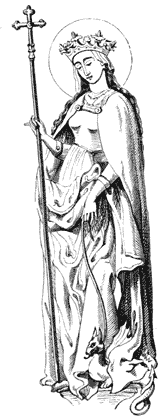 Fig. 232.—St. Margaret, after Wohlgemuth. |
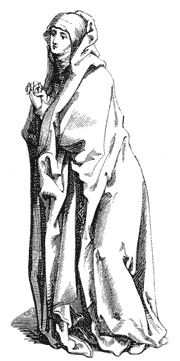 Fig. 233.—St. Anne, after Dürer. |
This striking peculiarity of treatment adopted by the early German artists in their draperies, was once explained to us by an old native artist, who assured us that it was entirely caused by the models for study which they universally employed. These were[203] small lay figures, over which draperies were cast formed in wet paper, disposed according to the artist’s fancy, and allowed to dry and set in the rigid form we see in their pictures. We have nowhere met with this key to the mode of study adopted by them; but it so completely accords with the character of their drawings, and would be so easy to attain in this material, and so difficult in any other, that it seems to bear the impress of accuracy.
The work of Wohlgemuth, by which he is now most familiarly known, are the illustrations of the Nürnberg Chronicle, of Hartmann Schedel, published in 1493, which he executed in conjunction with William Pleydenwurff. This once famous history is a folio, full of historic learning, and illustrated by more than a thousand woodcuts, many of which are very large. It would appear that Pleydenwurff executed the views of cities and minor illustrations, and his greater fellow-labourer designed and drew upon the wood the historical scenes. In conformity with the custom of ancient chronicles, the history begins with the creation of the world, the various incidents connected therewith being all delineated. There is considerable invention, but great lack of grace, in all these designs; they bear, however, strong resemblances to the leading characteristics of Wohlgemuth’s paintings, and they are superior to the woodcuts that preceded him, particularly as regards the amount of finish and chiaroscuro they exhibit. The earliest woodcuts by Dürer bear some resemblance to these works, and are in the dry hard style of a master who evidently valued positive drawing at a higher rate than the blandishments of colour; this, indeed, has always been a characteristic of German art.
[204]The three years of Dürer’s pupilage having expired, in conformity with the usual German custom, he travelled to see the world and improve himself. Of the early works of his genius we have no certain trace. That he was a good portrait painter we may be assured by the examination of his own picture in the gallery of the Uffizi at Florence, painted in 1498, and that of his father, in the Pinacotheck at Munich; but earlier chalk drawings exist, showing his proficiency in this branch of art at the age of fourteen. In the course of his peregrinations in Germany he visited his brother artists, returning to his native city in 1494. His earliest works on his return seem to have been designs on wood, for in 1498 appeared the series of woodcuts, illustrating the Revelations of St. John. Dr. Kügler says “we should regard them as proofs of his activity in the years immediately preceding; such at least is the case in similar works. In these compositions the artist has already attained great and peculiar excellence, but in these, as might be expected from the subject, the fantastic element forms the groundwork of the whole. These mystical subjects are conceived in a singularly poetical spirit; the wonderful and monstrous meet us in living bodily forms. Some of them exhibit a power of representation to the eye, and a grandeur of conception the more surprising, since the shapeless exuberance of the scriptural visions might easily have led the artist astray, as has indeed frequently happened in the case of others who have attempted these subjects.” In artistic effects these cuts are inferior to his latter works, and the drawing is sometimes more defective; but in inventive power they are master-pieces, and no[205] artist before or since has so successfully treated these mysteries. The reputation of Dürer was well-established by these cuts, and gave him a good position in his native town, which he never left afterwards, except for a journey to Venice in 1506, and to the Netherlands in 1520.
All Dürer’s tastes were essentially national, if indeed they may not be said to be narrowed within the circle of the town of Nürnberg and its neighbourhood. He married soon after his return; and living entirely at home, prosecuted his art with unwearied assiduity, the avarice of his wife urging still further his constant labours. His studies seem to have been made from the people around him, or from the scenes which constantly met his eye. Thus, in his scripture prints, the people of Nürnberg and the peasants of the neighbourhood, figure as representatives of the ancient Jews. St. Joseph is a Nürnberg carpenter, and the Virgin herself seems to have been modelled from some fair maiden of the city. The stout burghers, who witness the happy meeting of St. Joachim and Anne at the golden gate of the temple, in his series of prints illustrative of the Life of the Virgin, are such as Dürer might have seen daily loitering by the tower gate opposite his own windows; and the modest-looking maiden with the extravagantly fashionable head-dress, whom he has introduced in his “Marriage of the Virgin,” has been absolutely copied from nature; the original sketch, made by his own hand from a Nürnberg damsel, is preserved with many similar studies by him in the British Museum. He was untiring in his converse with nature as he saw it around him; and the minutely careful sketches which now[206] enrich our national collection, testify to his industry and anxiety for truth as the basis of his labours.
The old town of Nürnberg was eminently picturesque, and was enriched with artistic works by the best men of the day. The wealth of its inhabitants was expended on their houses within and without, and the churches were lavishly adorned with paintings and sculpture, as well as with other riches of art connected with the service of religion. In its quaint old streets might be studied the fruits of the faith and feeling of its inhabitants. Numerous figures of the Holy Mother decorated the street corners, or were[207] enshrined over the portals of the doors of the merchantmen, the light burning before each serving the double purpose of religion and utility, in a city of dark tortuous lanes. The ingenuity of the mason and sculptor was taxed in varied inventions for the further adornment of the homes of the wealthy; and the numerous specimens of artistic ironwork still remaining attest the taste and opulence of the merchant princes of the old city. Art was thus wedded to utility as well as to luxury, and at every step in Nürnberg the attention will still be arrested by its influence.
Dürer lived in a large mansion at one extremity of the town,[208] close to the gate from whence he could in a few minutes escape from the pent-up city to the open fields. His house is one of those roomy buildings in which there is enough timber to build at least a dozen modern houses. The lower portion is stone, the upper, with its open galleries, of wood. The view from his doors embraced the town gate, and the picturesque tower, known as the Thiergartenthor, beside it. The house between that and the narrow lane which leads up the castle hill was the property at that time of one Martin Kötzel, who, having twice employed himself in pilgrimages to Jerusalem, and in measuring the number of paces the Saviour trod on the Via Dolorosa, had determined on his return to consider his house as the representative of Pilate’s house, the Gate of Nürnberg as that of Jerusalem, the churchyard of St. John in the fields beyond, as Calvary, and the road between as the Via Dolorosa, and to cause representations of the events of the Saviour’s journey in the line of this road at the various distances where they were traditionally supposed to occur; and the chief sculptor of Nürnberg, Adam Kraft, was employed to execute the sculptures, which still stand a monument of the piety of the old citizen, whose house (known by the figure of an armed knight at its angle) is still familiarly called “Pilate’s House.” Time has written strange alterations on these old works, and wanton injury has also been done to them, but there still remains enough to show the ability of their conception and execution.
The castle comprises the somewhat rambling series of buildings of all ages, styles, and dates, which crown the rock above. The singular manner in which this isolated mass of stone suddenly[209] rises from the sandy plain may have induced the first foundation of the city, by the secure locality it afforded the castle of a ruler in days of old. Its early history is shrouded in obscurity—one of its towers has been attributed to the Romans; it can still show undoubted works of the ninth century in the chapels of Sts. Ottmar and Margaret, from which time it received alterations and additions of all kinds, ending in leaving it the picturesque assemblage of quaint old buildings which it at present remains. The Himmelsthor, or “tower of heaven,” is the name given to the large round tower which is built within the castle precincts on the[210] highest point of the rock, and which, as its title implies, soars toward heaven, and forms a prominent feature in all views of Nürnberg. The panorama from its summit is singularly striking, comprising the entire country for an immense distance round. The alt Feste, where Wallenstein encamped, in his memorable defence of these lines and of the city when besieged by Gustavus Adolphus, of Sweden, and the blue hills known as the Franconian Switzerland, terminating with the Moritzberg, give relief to the otherwise flat vicinity. This tower has been introduced in the background of some of Dürer’s designs, as well as other portions of the castle. The old town-walls also figure in those scenes from Holy Writ he so frequently designed. The anachronisms which result from such a mode of realising scenes in past history were sufficiently familiar in his own day to save them from all adverse criticism; indeed, it had become the formula of early art, thus to verify sacred events by adapting them to the experiences of every-day life around, to which it never appealed in vain. To comprehend fully the art of any one period, and the talent of any artist of that period, we must go back mentally to the time in which he flourished, and measure him by such as had preceded him. In this way alone can we form a right judgment of his powers, and award him his due place in art.
In the days of Albert Dürer the street in which he resided was known as “die Zisselgasse;” it is now appropriately named after the great artist himself. When he lived and worked in his roomy old mansion, Nürnberg was not quite so crowded within its own walls as it has since become by the pressure of[211] modern exigencies; and Dürer’s house appears to have had out-buildings, and, most probably, a small garden, such as was awarded to better-class houses in mediæval times. Dr. Frederick Campe tells us that he bought, in 1826, from the proprietor of the house, a balcony in which Dürer worked in summer time, and which originally must have commanded some sheltered space wherein a few trees might grow. The house has since been purchased by a society of artists, who honour themselves by that act, and do honour to Dürer by preserving it as much as possible in the state in which he left it, and exhibiting his works in the rooms. The interior of the house has undergone some renovation, but it[212] has been done cautiously, and in strict character with the original portions: it chiefly consists of new panelling and new doors, and they are quaintly carved in the style of the sixteenth century. The external door of the house still retains its old ironwork and lock fittings.212-* We pass through from the street, and enter a roomy hall, with a wide passage on one side, and an equally wide staircase on the other, which leads to the upper floors. A ponderous beam supports the ceiling, and a massive wooden pillar props the centre of this beam. The profusion of timber, and abundance of space accorded to passages and staircase, are indicative of past times, when wood was of less value than it has since become. The floor on which this pillar rests is flagged with stones; a small parlour is to the right; we pass it, and midway in the passage come to a low door leading into a small square room,—it was the studio of Dürer.
“Here, when art was still religion, with a simple, reverent heart,
Lived and laboured Albert Dürer, the Evangelist of Art.”212-†
It is lighted from the street by a long narrow window about five feet from the ground inserted in the top of an arch in the wall, as seen from the inside, beneath which is a shelf of capacious breadth. A small richly-carved altar-piece is now placed within it, and a few chairs. It is a quiet secluded room, having no communication with any other. The top of the walls and turrets of the old town,[213] and a small patch of sky, may be seen by an upward glance at the window; but there is no feature to distract the denizen of the apartment: it is a place for concentration of mind, and such must have been Dürer’s habits, as the enormous amount of his works show. Leaving this room and proceeding farther, we reach the quaintly constructed kitchen, with its enormous fire-place half filling the apartment. The one small window to the street lets in a gleam of light such as Rembrandt would have admired. The arched door is fitted with a lock of that peculiar form and character which assure the spectator that it is the handwork of an[214] ingenious smith of Dürer’s day; its broad plate is decorated with a simple ornament consisting of the favourite gnarled twigs and leaves, so constantly adopted in German decorations of all kinds, at the end of the fifteenth, and during the sixteenth century. We leave the ground floor and ascend the wide stairs. The front room on the first floor commands a pleasant view of the small Platz opposite the house, as it fronts the Thiergartenthor, and the castled crag rises grandly over the houses beside it. The walls are panelled, and the beams across the wooden ceiling chamfered, and slightly carved. The aspect of the whole room is striking,[215] and it is rendered more impressive by the many examples of Dürer’s genius placed within it, as well as of others by his master Wohlgemuth. The woodcuts are framed, and comprise the best examples of both masters; there is also an original drawing on vellum testifying to the minute accuracy of Dürer’s studies. It is the figure of a lion, bearing date 1512, drawn with all that patient care which characterises his transcripts from nature. In the British Museum is a large volume containing numerous studies for his principal works, and it is a wonderful record of truth-seeking patience, as the minute parts of his designs appear to have been drawn from nature as carefully as if such sketches had been parts of a finished picture; his unwearied assiduity in his profession has never been exceeded.
Nürnberg contains fewer of Dürer’s works than a stranger might be led to expect.215-* The print-room of our British Museum, with its great number of engravings and drawings, and its wonderful sculpture in hone-stone by him, is a far better place to study the works of this artist. There is, however, one work of singular interest preserved in the old city, which is worth a long journey to see. It is the portrait of the old Nürnberg patrician—Jerome Holzschuher, the friend and patron of the artist. It represents a cheerful, healthy man over whose head fifty-seven years have[216] passed without diminishing his freshness and buoyancy of spirit; the clear complexion, searching eye, and general vigour which characterise the features, almost seem to contradict the white hair that falls in thick masses over the forehead. For freshness, power, and truth, this portrait may challenge comparison with any of its age. Time has also dealt leniently with the picture, for it is as clear and bright as the day it was painted, and is carefully preserved in its original frame, into which a sliding wooden panel is made to fit and cover it: the outside being emblazoned with the armes parlantes of the family of Holzschuher—a wooden shoe, raised from the ground in the manner of the Venetian chopine. The picture was painted in 1526, and “combines,” says Kügler, “the most perfect modelling with the freest handling of the colours; and is certainly the most beautiful of all this master’s portraits, since it plainly shows how well he could seize nature in her happiest moments, and represent her with irresistible power.” It still remains in the possession of the Holzschuher family, and is located in their mansion at the back of the Egidienkirche, where it is politely shown to strangers on proper application; and should the visitor have the advantage accorded to the writer, of the attendance of the last representative of the family, he will see that the same clear eye and expressive features have also descended as a heir-loom in the house.
It is at Florence, Vienna, and Munich, that Dürer’s paintings are principally located. The Castle at Nürnberg possesses his portraits of the Emperors Charlemagne and Sigismund. In the Moritzkapelle is the picture which he painted for the church of St.[217] Sebald in Nürnberg, by the order of Holzschuher. It represents the dead Saviour just removed from the cross, and mourned over by his mother and friends. It is peculiarly brilliant in colour, and there is considerable force in the deep rich draperies with which the figures are clothed, but it has the defect visible in the works of Dürer’s master—a love of hard black outlines. In this picture the faces, hands, and feet are delineated by lines very slightly relieved by shadow, and reminding the spectator too much of his woodcuts. This love for expressing firm outline is better adapted to such works as his wall-paintings in the Rathhaus, or Town-hall. They are executed on the north wall of the grand saloon, and are divided by the principal door leading from the gallery; on one side of which is an allegory of the “Unjust Judge” (which formed one of the series of moral broadsheets published by Hans Sachs); and a group of musicians in a gallery, probably representing those that belonged to the town; on the other side of the door the entire length of the wall is occupied by the allegorical triumphal car of the Emperor Maximilian I., a work which Dürer copied on wood in a series of large cuts, published in 1522. In a fanciful car, drawn by many horses, sits the emperor in regal state, attended by all the virtues and attributes which may be supposed to wait on moral royalty. The very nature of such a work is beset with difficulties, and it is seldom that any artist has entirely surmounted them. State allegories present small fascinations to any but the statesman glorified; but Dr. Kügler in his criticism of this work, while he acknowledges its defects, is prepared to say that some of the figures “display motives of extraordinary beauty, such as[218] might have proceeded from the graceful simplicity of Raphael.”218-* This painting has suffered from time, and “restoration;” the design may be best studied in the woodcut made from it.
The Emperor Maximilian was a great patron of the arts, but particularly of that branch which had newly arisen—the art of wood-engraving—which he fostered with continual care, and by the help of such men as Dürer, Burgmeyer, Schaufflein, and Cranach, produced works which have never been excelled. During this period, extending over the first quarter of the sixteenth century, a series of elaborate woodcuts were executed under his own auspices, which were, however, principally devoted to his own glorification. Two of these are the well-known “Adventures of Sir Thuerdank,” and “The Wise King,” written in ponderous folios after the fashion of the old romances, by Melchior Pfintzing, who resided in the old parsonage house of St. Sebald (he being a canon of that church), a picturesque building on the sloping ground beside it, which rises upward to the Schlossberg, and which still retains the aspect it bore in his days; its beautiful oriel and open balcony still testify to the taste of mediæval architects. It is but a short distance from Dürer’s house, and he must have frequently visited here. Here also, came the emperor to examine the progress of these works: and the great interest he took in superintending them has been recorded; for it is said that during[219] the time when Jerome Retzsch was engaged in engraving on wood the triumphal car from the drawing by Dürer, the emperor was almost a daily visitant to his house. This anecdote may naturally lead here to the consideration of the question—did Dürer engrave the cuts which bear his name, or did he only draw them upon the wood for the engraver? It is generally considered that all cuts bearing an artist’s mark are engraved by that artist, but this is in reality an error resulting from modern practice. It is now the custom for wood-engravers to place their names or marks on their cuts, and very seldom those of the artists who draw the designs for[220] them upon the wood. It was the reverse in the old time; then it was usual to place that of the designer alone, and as he drew upon wood every line to be engraved, after the manner of a pen-and-ink drawing, the engraver had little else to do than cut the wood from between the spaces: hence his art was a very mechanical one, and his name was seldom recorded. That of Retzsch does not appear on the car just named, but the mark of Dürer solely; and when we consider the vast amount of labour performed by Dürer as an artist, it is not likely that he wasted time in the mechanical labour of cutting out his own drawings when he could employ it more profitably. The Baron Derschau, himself a collector of old cuts, assured Dr. Dibdin “that he once possessed a journal of Dürer’s, from which it appeared that he was in the habit of drawing upon the blocks, and that his men performed the remaining operation of cutting away the wood.” Bartsch is decidedly of opinion “that he had never employed himself in this kind of work.” Mr. W. A. Chatto, in his anonymous “History of Wood Engraving,” has gone into this question with much research and learning, and comes to the same conclusion; which is strengthened by the fact, that the names of fourteen engravers, and the initials of several others, were found engraved on the backs of the cuts they executed for the “Triumph of Maximilian,” now preserved in the imperial library at Vienna; the names of others are incidentally preserved; and among the drawings by Dürer in the British Museum, is one of a young lady, whom he has designated “wood engraver,” and who was most probably employed by him. There is also a sufficient difference in the style[221] and manner of cutting his designs, which shows they must have been done by different hands. It is not possible to note here a tithe of the cuts done from his drawings.221-* His great serials are the “Apocalypse,” published in 1498, the two series of the “Passion of Christ,” and the “Life of the Virgin” (from which we give a specimen, Fig. 241, “Christ bidding Farewell to his Mother”), all published in 1511. His largest woodcut was published in 1515, the “Triumphal Arch of the Emperor Maximilian,” and this, like the car already alluded to, was engraved on a series of ninety-two wood blocks, and then the impressions pasted together, forming a large print ten feet high. It is a work of great labour, and displays considerable invention.
Of Dürer’s powers as a painter we have already spoken; but he excelled also as an engraver on copper, and his prints of “Adam and Eve,” “Melancholia,” and the small “Life of Christ,” have not been surpassed. To him also we owe the invention of etching; he practised the art on iron and on copper, and it is impossible to overvalue its utility. In addition to his other labours he executed several pieces of sculpture, one of which, the “Naming of John the Baptist,” we have already alluded to as preserved in the British Museum, and some few others in hone-stone, bearing his well-known mark, exist. He also wrote on Art, and a portion of the original manuscripts of his book on[223][222] the proportions of the human figure, is still preserved in the library of the old Dominican monastery at Nürnberg. He was a good mathematician, he also studied engineering, and is believed to have designed and superintended the additional fortifications in the town walls beside the castle, which are remarkable as the earliest examples of the more modern system of defence, which originated in the south of Europe, and with which Dürer became acquainted during his sojourn in Venice, and the fruits of which he thus practically brought to the service of his native city.223-* He published too an essay on the fortification of towns. In fact, there were few subjects to which his mind was directed that he did not make himself complete master of.
Thus lived and laboured Dürer in the city of his adoption, studying nature most diligently, and combining therewith high imaginings of his own. In 1506 he undertook a journey to Venice, and its influence improved him greatly. In the letters he wrote on this journey to his intimate friend Pirkheimer he acknowledges this; in one of them he declares “the things which pleased me eleven years ago please me no longer.” He also notes the popularity which had preceded him, and says, “the Italian artists counterfeit my works in the churches and wherever else they can find them, and yet they blame them, and declare that as they are not in accordance with ancient art they are worthless.”223-† But though[224] subjected to the slights of the unworthy, Dürer gratefully records the nobler acts of nobler men, and notes that Giovanni Bellini publicly praised him before many gentlemen, “so that I am full of affection for him.” This noble old man did not confine his acts to praise alone, but came to Dürer’s lodging and requested him to paint him a picture, as he was desirous to possess one of his works, and he would pay liberally for it. Dürer at this time was far from rich, was merely paying his way by the practice of his art; and the small sums of money he notes as sending for the use of his wife and widowed mother in Nürnberg, sufficiently attest this, as well as his request to Pirkheimer to help them with loans which he would repay.
Pirkheimer’s name is so intimately connected with Dürer, and he remained throughout his life so steady and consistent a friend, that no memoir of Dürer can be written, however briefly, without his name appearing. He was a man of considerable wealth and influence in Nürnberg, a member of the Imperial Council, and frequently employed in state affairs. He had it, therefore, in his power to aid Dürer greatly; he did so, and Dürer returned it with a gratitude which ripened to affection, he declares in one of his letters that he had “no other friend but him on earth,” and he was equally attached to Dürer. The constant intercourse and kindly advices of his friend were the few happy relaxations Dürer enjoyed. Pirkheimer was a learned man, and cheerful withal, as his facetious book “Laus Podagræ,” or the “Praise of the Gout,” can testify. The house in which he resided is still pointed out in the Egidien Platz; it has undergone alterations, but the old[225] doorway remains intact, through which Dürer must have frequently passed to consult his friend. “What is more touching in the history of men of genius than that deep and constant attachment they have shown to their early patrons?” asks Mrs. Jameson.225-* How many men have been immortalised by friendships of this kind; how many of the greatest been rendered greater and happier thereby? When the Elector John Frederick of Saxony[226] met with his reverses in 1547, was driven from his palace, and was imprisoned for five years, the painter Lucas Cranach, whom he had patronised in his days of prosperity, shared his adversity and his prison with him, giving up his liberty to console his prince by his cheerful society, and diverting his mind by painting pictures in his company. He thus lightened a captivity and turned a prison into a home of art and friendship; thus the kindness and condescension of a prince were returned in more value “than much fine gold,” in the bitter hour of his adversity, by his humble but warm-hearted artist-friend.
That brotherly unity which ought to bind professional men of all kinds—isolated as they must be from the general world—was more of a necessity in the past time than in the present; and the artists formed a little band of friends within the walls of ancient Nürnberg, consulting with and aiding each other. The peculiarity of thought and tendency of habit which constitute the vitality of the artist-mind, are altogether unappreciated by the general world; completely misunderstood, and most frequently contemned by men of a trading spirit, who look upon artists as “eccentrics,” upon art as a “poor business,” and judge of pictures solely by their “market value.” These things should bind professors more strongly together. Their numbers are few; their time for socialities limited; their world a small select circle; few can sympathise with their cares or their more exquisite sensibilities; they must, therefore, be content with the few whose minds respond to theirs, and they ought not to make the narrow circle narrower, by unworthy jealousies or captious criticism. Well would it be for[227] us all, and infinitely better for the world of art, if we practised still more
“Those gentler charities which draw
Man closer with his kind,
Those sweet humilities which make
The music which they find.”227-*
Dürer was essentially a man to love. His nature was kindly and open; he knew no envy, and was never known to condemn the work of another artist,—which, if bad, he would only criticise with a smile, and a “Well! the master has done his best.” His general information was so good, that it was declared of him by a contemporary, that his power as an artist was his least qualification. His personal appearance was dignified, and his face eminently handsome.227-† Yet, with all these means of being happy, and making others so, few men endured more misery. In an evil hour his family made a match for him in the household of Hans Frei, whose daughter Agnes he married, and scarcely knew peace after. She was a heartless, selfish woman, who could have no feeling in common with her husband, and who only valued his art according to the money it realised. “She urged him to labour day and night solely to earn money,[228] even at the cost of his life, that he might leave it to her,” says Pirkheimer, in one of his letters to Tscherte, their mutual friend the Viennese architect. All his friends she insulted and drove from the house, in order that their visits might not interfere with his labours. His aged mother, whom he had taken into his house after his father’s death, was subject to contempt and ill-treatment. His letters from Venice are sad, and show no pleasant home-thoughts. Yet he did much for the bad woman to whom he was wedded, and seems to have thought of her gratification by numerous presents. His amiable heart would not allow him to separate from her, thus he bore her ill humours for his life, and patiently endured his lot.228-* There were few men more adapted to make a woman happy than Dürer: he had a handsome person, much fame, good friends, great talent, and the most kindly amiability; but his wife was perhaps the worst on record, on whom all this was thrown away. Yet she was of very religious habit, and preserved all the externals of propriety; but, as Pirkheimer observes, “one would rather choose a woman who conducts herself in an agreeable manner, than a fretful, jealous, scolding wife, however devout she may be.”
Banished from the society of friends, Dürer’s only solace was in his art. Here only he found peace and pleasure. How earnestly[229] and deeply he laboured, the long catalogue of his productions can prove. The truthfulness of his style is shown in his patient studies from nature, and his works are the reflex of such a habit. The figure of the burly townsman of Jerusalem who lifts his cap in acknowledgment of Joachim and Anna, as they meet at the Golden Gate, in his illustrations of the Life of the Virgin (Fig. 243), may be cited for its homely truth, a characteristic which runs through all Dürer’s works, and gives them a certain naïveté. The figure is an evident study of an honest townsman of Nürnberg, and is as little like an ancient Jew as possible, though admirable as a transcript from nature. Of far higher order are the figures of the apostles, John, Peter, Mark, and Paul, which he painted in 1526, and presented to his native city.229-* We engrave the figure of Paul, the drapery of which is simple and majestic. A study for this drapery, made as early as 1523, is in the collection of the Archduke Charles of Austria. In these pictures, which are painted of life-size, he has exerted his utmost ability, and eschewed any peculiarities of his own which might interfere with the greatness of his design. “These pictures are the fruit of the deepest thought which then stirred the mind of Dürer, and are executed with overpowering force. Finished as they are they form the first complete work of art produced by Protestantism.229-† What[230] dignity and sublimity pervade those heads of such varied character!230-* What simplicity and majesty in the lines of the drapery! what sublime and statue-like repose in their attitudes! Here we no longer find any disturbing element: there are no small angular breaks in the folds, no arbitrary or fantastic[231] features in the countenances, or even in the fall of the hair. The colouring too is very perfect, true to nature in its power and warmth. There is scarcely any trace of the bright glazing, or of those sharply defined forms seen in other works by him, but everywhere a free pure impasto. Well might the artist now close his eyes, he had in this picture attained the summit of his art—here he stands side by side with the greatest masters known in history.”231-*
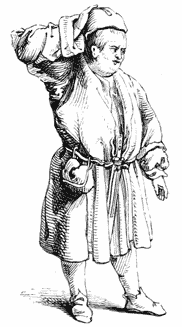 Fig. 243.—Figure from Dürer’s Life of the Virgin. |
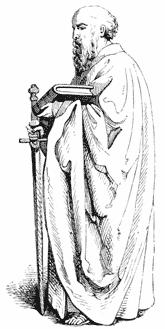 Fig. 244.—St. Paul, after Dürer. |
Of the great contemporaries of Dürer—whose works have given undying celebrity to the old town of their residence—we must now discourse a little. Honoured as these works still are by the Nürnbergers, they are little known out of Germany; although, as exemplars of art in general at the particular period when they were executed, they may challenge their due position anywhere. The most remarkable is the bronze shrine of St. Sebald, the work of Peter Vischer and his five sons, which still stands in all its beauty in the elegant church dedicated to the saint. The shrine encloses, amid the most florid Gothic architecture, the oaken chest encased with silver plates, containing the body of the venerated saint; this rests on an altar decorated with basso-relievos, depicting his miracles.231-† The architectural[232] portion of this exquisite shrine partakes of the characteristics of the Renaissance forms engrafted on the mediæval, by the influence of Italian art. Indeed, the latter school is visible as the leading agent throughout the entire composition. The figures of the[233] Twelve Apostles and others placed around it, scarcely seem to belong to German art: they are quite worthy of the best Trans-alpine master. The grandeur, breadth and repose of these wonderful statues cannot be excelled. Vischer seems to have completely freed his mind from the conventionalities of his native schools: we have here none of the constrained “crumpled draperies,” the home-studies for face and form, so strikingly present in nearly all the works of art of this era; but noble figures of the men elevated above the earthly standard by companionship[234] with the Saviour, exhibiting their high destiny by a noble bearing, worthy of the solemn and glorious duties they were devoted to fulfil. We gaze on these figures as we do on the works of Giotto and Fra Angelico, until we feel human nature may lose nearly all of its debasements before the “mortal coil” is “shuffled off,” and that mental goodness may shine through and glorify its earthly tabernacle, and give an assurance in time present of the superiorities of an hereafter. Dead, indeed, must be the soul that can gaze on such works unmoved, appealing as they do to our noblest aspirations, and vindicating humanity from its fallen position, by asserting its innate, latent glories. Here we feel the truth of the scriptural phrase—“In his own image made He them.”
The memory of Peter Vischer is deservedly honoured by his townsmen. The street in which his house is situated, like that in which Dürer’s stands, has lost its original name, and is now only known as “Peter Vischer’s Strasse;” but these two artists are the only ones thus distinguished.234-* Vischer was born in 1460, and died in 1529. He was employed by the warden of St. Sebald’s, and magistrate of Nürnberg, Sebald Schreyer, to construct this work in[235] honour of his patron saint; he began it in 1506, and finished it in 1519. Thirteen years of labour were thus devoted to its completion, for which he received seven hundred and seventy florins. “According to tradition, Vischer was miserably paid for this great work of labour and art; and he has himself recorded in an inscription upon the monument, that ‘he completed it for the praise of God Almighty alone, and the honour of St. Sebald, Prince of Heaven, by the aid of pious persons, paid by their voluntary contributions.’”235-* The elaboration of the entire work is marvellous; it abounds with fanciful figures, seventy-two in number, disposed among the ornaments, or acting as supporters to the general composition. Syrens hold candelabra at the angles; and the centre has an air of singular lightness and grace. It is supported at the base by huge snails. At the western end there is a small bronze statue of Vischer, which we copy (Fig. 247): he holds his chisels in his hand, and in his workman’s dress, with capacious, leather apron, stands unaffectedly forth as a true, honest labourer, appealing only to such sympathies as are justly due to one who laboured so lovingly and so well.
Sharing the palm with Vischer for perfect mastery in sculpture (the one as a worker in metal, the other in stone) stands Adam Krafft, whose works are still the principal ornaments of the city. To him were his fellow-townsmen indebted for the grand gate of the Frauenkirche, the series of sculptures on the “Via Dolorosa,”[236] numerous others in the churches and public buildings, but principally for the “Sacramentshauslein,” in the Church of St. Laurence (Fig. 248). This marvellous work is placed against a pillar beside the high altar, and is intended as a receptacle for the consecrated bread and wine in its service; a small gallery runs round the lower portion, in which the “host” is kept; over this the sculpture[237] ascends upwards in a series of tapering columns and foliage of the most light and fanciful description, until it reaches the spring of the arched roof, where the crowning pinnacle “bows its beautiful head like the snowdrop on its stem,” in the curve of the arch, gracefully completing a work which, for originality, delicacy, and the most extraordinary elaboration of design, is a perfect marvel[238] of stone-carving. The foliations are so flowing and delicate, that it has given rise to a popular tradition that Krafft was possessed of some secret for making stone plastic. We have nothing so delicate in this country, unless it be some of the leaflets on the Percy shrine, and screen of Beverley Minster. Krafft’s leaves are as thin and delicate, as crisp and free, as if moulded from nature in plaster of Paris, while the grand curves of his ornamental adjuncts are astonishing, when we reflect on the mass of stone necessarily cut away to produce these boldly-flowing enrichments. Krafft was born at Ulm in 1430, and died 1507. His father was the printer, Ulrich Krafft. He commenced this work in the year 1496, and completed it in 1500. In it we see the perfect mastery produced by a life of labour, and in front of it he has sculptured his own effigy,[239] kneeling, mallet in hand, and supporting his favourite work. There is a touching simplicity in this union of the artist and his labours, made in these instances all the more impressive by its utter want of pretension. There is no affectation—no studied artistic or classical portraying; we have simply the man and his work before us, appealing by their dumb native eloquence to that[240] homage and love, which are their due by their own inherent greatness.
That works based on truth and nature will always possess this power, may be proved by the admiration bestowed on a small work by a pupil of Vischer’s, which is popularly loved by the Nürnbergers, and known as “Das Gänsemänchen” (Fig. 250). It forms the central figure of a small fountain beside the Frauenkirche, and represents a country boor leaning against a small pillar, with a goose under each arm, waiting a customer in the market; from the mouth of each goose a stream of water descends. The figure is not more than eighteen inches high, and is, from the smallness of its size, compared with the greatness of its celebrity, a general disappointment to those who see it for the first time. It rivals in celebrity the work of Vischer himself, and was executed by his scholar, Pancratius Labenwolf (born 1492, died 1563); the fountain in the quadrangle of the “Rathhaus” is also by him. The Goose-seller owes its popularity to its perfect truth and simplicity.
Another artist of this era, inferior to none in taste and delicacy of sentiment, was Veit Stoss. He was a native of Poland, born at Cracow in 1447; making Nürnberg the city of his adoption, and dying there in 1542.240-* The same exquisite grace and purity which characterises the works of Vischer is seen in those of Stoss. He devoted himself to sculpture in wood, and in this way is said to have furnished models to those who worked in stone, as well as[241] to goldsmiths, and other artisans who required designs. “The Crowning of the Virgin,” still preserved in the old castle at Nürnberg, had all the delicacy and grace of the missal paintings of Julio Clovio.
There is an exquisite repose about his works, only to be gained by great mastership in art. At times a tenderness of sentiment singularly beautiful is apparent in these too-much-forgotten works. We engrave, as an illustration of this, one of the compartments of the “Rosenkranztafel,” preserved in the same locality, and representing the “Nativity.” The Virgin in the stable at Bethlehem, piously rejoices in the birth of the Lord, and is about to wrap the sacred infant in the folds of her own garments, having no other clothing. She has reverently laid the[242] babe in a corner of her mantle, when, penetrated with a sense of the divinity, she clasps her hands in prayer before the Infant Saviour; while her husband Joseph, who holds the lantern beside her, feeling the same emotion, drops on one knee, and reverently lifts his hat in acknowledgment of the Immortal One.
It is this fervent devotion, this pure, high, yet simple-mindedness, which gives vitality to ancient works of art, and is to be felt by all who are not insensible to its agency in the time present. Another touching incident is seen in the sculpture by Adam Krafft over the grave of Schreyer, representing “The[243] Entombment.”243-* The dead body of our Saviour is being reverently lifted into the tomb; the sorrowing mother, loving as only mothers love, partially supports the wounded body of her inanimate son; in process of movement the Saviour’s head falls languidly on one side, and the dead cheek is again greeted with the fervent kiss of love, which still burns in the breast of the sorrowing mother. Who shall rudely criticise the perspective, the draperies, the absence of “scholastic rule,” in this touching work of a true-hearted man? Not the writer of these lines! Let it be rather his province to vindicate for these old artists their due position, among the few forming that galaxy of the great and good, elevating and adorning human nature.
Our parting glance at “the Athens of Germany” must comprehend a view of the life and manners of the people among whom Dürer and his compatriots lived. Theirs were the palmy days of the old city, for its glories rapidly fell to decay toward the end of the sixteenth century. Its aspect now is that of a place of dignity and importance left to loneliness and the quiet wear of time; like an antique mansion of a noble not quite allowed to decay, but merely existing shorn of its full glories. “Nürnberg—with its long, narrow, winding, involved streets, its precipitous ascents and descents, its completely Gothic physiognomy—is by far the strangest old city I ever beheld; it has retained in every[244] part the aspect of the Middle Ages. No two houses resemble each other: yet, differing in form, in colour, in height, in ornament, all have a family likeness; and with their peaked and carved gables, and projecting central balconies, and painted fronts, stand up in a row, like so many tall, gaunt, stately old maids, with the toques and stomachers of the last century. Age is here, but it does not suggest the idea of dilapidation or decay; rather of something which has been put under a glass case, and preserved with care from all extraneous influences. But, what is most curious and striking in this old city, is to see it stationary, while time and change are working such miracles and transformations everywhere else. The house where Martin Behaim, four centuries ago, invented the sphere, and drew the first geographical chart, is still the house of a map-seller. In the house where cards were first manufactured, cards are now sold. In the very shops where clocks and watches were first seen, you may still buy clocks and watches. The same families have inhabited the same mansions from one generation to another for four or five centuries.”244-*
In a city where all its associations of greatness are with the past, and its memories essentially connected with those who have been long numbered with the dead, it is natural we should find a strong tendency to remembrances of events and personages generally forgotten in other and more stirring cities. The Nürn[245]bergers lovingly preserve all that will connect them with the glorious days of Kaiser Maximilian, when their “great Imperial City” held the treasures of the Holy Roman empire, the crown and royal insignia of Charlemagne, as well as the still more precious “relics” which he had brought from the Holy Land.245-*
Among all their literary magnates none is better remembered than
“Hans Sachs, the cobbler-bard,”
and statuettes of this great poet of small things are to be seen in most Nürnberg book and print shops. Since the days of Lope de Vega no writer scribbled so fluently and so well on the thousand-and-one incidents of his own day, or fancies of his own brain. Sachs was born at Nürnberg in 1494 and was the son of a poor tailor, who insured his education in the free-school of the town, and at fifteen he was apprenticed to a shoemaker; when the period of servitude had expired, in accordance with the German practice, he set out on his travels to see the world. It was a stirring time, and men’s eyes were rapidly opened to the corruptions of church[246] and state; the great principles of the Reformation were making way. Hans possessed much of that stirling common sense, and shrewd practical observation which belong to many of the lower class, and make them outspoken rude despisers of courtiership. On his return he applied for admission as a fellow rhymester among the master-singers’ fraternity of Nürnberg, a corporation of self-styled poets, who surrounded the “divine art” with all kinds of routine ordinances, and regulated the length of lines and number of syllables which each “poem” (?) should contain, so magisterially that they reduced it to a mathematical precision, and might class it among the “exact sciences.” Before this august tribunal the muse of Sachs appeared, his poem was read, its lines were measured, its syllables counted, and he was admitted to the honour of being an acknowledged master of song. From that hour till his death, he cobbled and sang to the wonderful amusement of the good citizens; and when seventy-seven years had passed gaily over his head, “he took an inventory of his poetical stock-in-trade, and found, according to his narrative, that his works filled thirty volumes folio, and consisted of 4,273 songs, 1,700 miscellaneous poems, and 208 tragedies, comedies and farces, making an astounding sum-total of 6,181 pieces of all kinds. The humour of his tales is not contemptible; he laughs lustily and makes his reader join him; his manner, so far as verse can be compared to prose, is not unlike that of Rabelais, but less grotesque.”246-* His most popular productions[247] were broadsheets with woodcuts, devoted to all kinds of subjects, sold about the streets, and stuck “like ballads on the wall” of old English cottages; speaking boldly out to the comprehension and tastes of the people on subjects they were interested in. From a large volume of these “curiosities of literature” now lying before the writer, his immense popularity with the people can be well understood. Here we find fables of never-dying interest, such as “The Old Man and his Ass,” reproduced in doggerel they could enjoy, with a humour they could relish, and headed by bold woodcuts. If they wanted morality they had it in “pious chansons” about fair Susannah, “The Destruction of Sodom and Gomorrah,” “Daniel in the Lions’ Den,” “Twelve short Sermons,” &c. Moral allegories suited to every-day life wooed their attention in his “Christian Patience,” where the whole human family is depicted as a solitary in a ship on a stormy sea, with the world, death, and the devil, as adversaries to oppose his safe entry into his port, “das vaterland,” but who is mercifully guarded by the Most High. If amusing satire were required, it might be found in his “Women setting Traps for Fools;” while the strong religious tendencies of the Reformers were enforced in his rhymes of the “True and False Way,” above which was printed a large cut where the Saviour invites all to the open door of his fold, while the pope and his priests hinder all from entering, except by back-doors, holes, and corners. At this period Nürnberg was torn by religious faction; and it ultimately became enthusiastically Protestant. There is no doubt that Hans Sachs helped greatly to foster the feeling in its favour, as his “broadsides” told forcibly,[248] and were immensely popular. They were in fact the only books of the poor.
The portrait of the old cobbler was painted in 1568 by Hans Hoffman, and is a strikingly characteristic resemblance of a man whose
“age is as a lusty winter,
Frosty, but kindly.”
There is an intensity of expression in the clear, deep-set eye, a shrewd observant look in the entire features, while it shows a capacity of forehead that will make Hans pass muster with modern phrenologists. The cobbler-bard wrote and sung, and mended his neighbours’ boots in an unpretending domicile in a street leading from the principal market, which street now goes[249] by his name. Since his time the house has been almost rebuilt and entirely new fronted. Its old features have been preserved in an etching by Fleischmann, after a sketch by J. A. Klein, at which period it was a beershop known by the sign of the “Golden Bear.” Hans died full of years and honour in the year 1576, and is buried with the great men of his city in the cemetery of St. John.
The domestic life of the old Nürnbergers seems to have been characterised by honourable simplicity, and their posterity appear to follow laudably in their footsteps. They delight in the[250] antiquity of their city, and reverently preserve the relics of their past glories. Their houses seem built for a past generation, their public edifices for the Middle Ages; their galleries abound in the art of the fifteenth century, and admit nothing more modern than the seventeenth. In the old garden upon the castle bastion is a quaint quadrangular tower250-* having its entrance therefrom, and this has been fitted up with antique furniture, to give a true idea of the indoor life of Dürer’s days. It contains a hall hung with tapestries, from which a staircase leads to a suite of rooms, one fitted as a kitchen, another as a music-room, filled with the most quaint and curious antique instruments, which have ceased “discoursing most eloquent music” for the last two hundred years. The third room (a view of which we engrave) is a boudoir, containing the large antique German stove, built up with ornamental tiles cast in relief, with stories from bible history of saints, and arabesque. Beside it is a bronze receptacle for water, shaped like a huge acorn, the tap having a grotesque head, and the spigot being a small seated figure; this was gently turned when wanted, and a thin stream of water trickled over the hands into the basin beneath; an embroidered napkin hangs beside it; and above it is the old-fashioned set of four hour-glasses, so graduated that each ran out a quarter of an hour after the other. The furniture and fittings of the entire building are all equally curious, and[251] reproduce a faithful picture of old times, worthy of being copied in National Museums elsewhere.
Nürnberg being a “free city” was governed by its own appointed magistrates, having independent courts of law. The executive council of state consisted of eight members, chosen from the thirty patrician families who, by the privilege granted to them from the thirteenth century, ruled the city entirely. In process of time these privileges assumed the form of a civic tyranny, which was felt to be intolerable by the people, and occasionally opposed by them. The fierce religious wars of the sixteenth century[252] assisted in destroying this monopoly of power still more; yet now that it is gone for ever, it has left fearful traces of its irresponsible strength. All who sigh for “the good old times,” should not moralise over the fallen greatness of the city, and its almost deserted but noble town-hall; but descend below the building into the dark vaults and corridors which form its basement; the terrible substructure upon which the glorious municipal palace of a free imperial self-ruled city was based in the Middle Ages, into whose secrets none dared pry, and where friends, hope, life itself, were lost to those who dared revolt against the rulers. There is no romance-writer who has imagined more horrors than we have evidences were perpetrated under the name of justice in these frightful vaults, unknown to the busy citizens around them, within a few feet of the streets down which a gay wedding procession might pass, while a true patriot was torn in every limb, and racked to death by the refined cruelty of his fellow-men. The heart sickens in these vaults, and an instinctive desire to quit them takes possession of the mind, while remaining merely as a curious spectator within them. The narrow steps leading to them are reached through a decorated doorway, and the passage below receives light through a series of gratings. You shortly reach the labyrinthine ways, totally excluded from external light and air, and enter one after another confined dungeons, little more than six feet square, cased with oak to deaden sounds, and to increase the difficulty of attempted escape. To make these narrow places even more horrible, strong wooden stocks are in some, and day and night prisoners were secured in total darkness, in an atmosphere[253] which even now seems too oppressive to bear. In close proximity to these dungeons is a strong stone room, about twelve feet wide each way, into which you descend by three steps. It is the torture-chamber. The massive bars before you are all that remain of the perpendicular rack, upon which unfortunates were hung with weights attached to their ankles. Two such of stone, weighing each fifty pounds, were kept here some years back, as well as many other implements of torture since removed or sold for old iron. The raised stone bench around the room was for the use of the executioner and attendants. The vaulted roof condensed the voice of the tortured man, and an aperture on one side gave it freedom to ascend into the room above, where the judicial listeners[254] waited for the faltering words which succeeded the agonising screams of their victim. So much we know and still see, but worse horrors were dreamily spoken of by the old Nürnbergers; there was a tradition of a certain something that not only destroyed life, but annihilated the body of the person sacrificed. The tradition took a more definite form in the seventeenth century, and the “kiss of the Virgin” expressed this punishment, and was believed to consist in a figure of the Virgin, which clasped its victim in arms furnished with poignards, and then opening them, dropped the body down a trap on a sort of cradle of swords, arranged so as to cut it to pieces, a running stream below clearing all traces of it away.
These frightful traditions were received with doubt by many, and with positive disbelief by others, until a countryman of our own, with unexampled patience and perseverance, fully substantiated the truth of all, and after many years traced the absolute “Virgin” herself, which had been hurriedly removed from Nürnberg during the French Revolution, two or three days before the French army entered the town, and then passed into the collection of a certain Baron Diedrich, and was kept by him in a castle called Feistritz, on the borders of Steinmark. Determined to persevere in tracing this figure, our countryman visited this castle in 1834, and there was the machine; it was formed of bars and hoops covered with sheet iron, representing a Nürnberg maiden of the sixteenth century in the long mantle generally worn. It opened with folding doors, closing again over the victim, and pressing a series of poignards into the body, two being affixed to[255] the front of the face, to penetrate to the brain through the eyes. “That this machine had formerly been used cannot be doubted; because there are evident blood-stains yet visible on its breast and part of the pedestal.” This machine was introduced to Nürnberg in 1533, and is believed to have originated in Spain, and to have been transplanted into Germany during the reign of Charles V., who was monarch of both countries. At this period there were great tumults in Germany and continual quarrels at Nürnberg between the Catholics and Protestants: the men of that city had no doubt to thank “the most holy Inquisition” for this importation of horrors.
The great leading principles of the Reformation interested Dürer as they did other thinking men. He examined by the biblical test the unwholesome power and pretensions of the papacy, and found it wanting. We have already noted the exhortation to abide by “the written word” which he appended to his famous picture of the Apostles. In his journal he breaks forth into uncontrolled lamentations over the crafty capture of Luther made by his friend the Elector of Saxony, who conveyed him thus out of harm’s way, and kept him nearly a twelvemonth in the Wartburg. He exclaims, “And is Luther dead? who will now explain the Gospel so clearly to us? Aid me, all pious Christians, to bewail this man of heavenly mind, and pray God for some other as divinely enlightened.” He then exhorts Erasmus to “come forth, defend the truth, and deserve the martyr’s crown, for thou art already an old man.” Dürer had painted Erasmus’s portrait at Brussels in 1520, and appears to have been intimate with that great man as[256] he was with Melancthon, who said of Dürer, that “his least merit was that of his art.”
Amid the strong dissensions of the Reformation, at a time when old Nürnberg was tottering to its fall, worn down by mental toil, and withered at heart by one of the worst wives on record, died Albert Dürer at the age of fifty-seven.
In the old cemetery of St. John lies all that is mortal of the artist who has given lasting celebrity to Nürnberg. Let us take a walk in that direction. Passing out of the town by the gate opposite Dürer’s house, the sculptured representations of the scenes of Christ’s Passion, by Adam Krafft, already alluded to, will guide our footsteps on our way. About three-quarters of a mile from the town, we reach the gate beside which stands Krafft’s group of the Crucifixion.257-* We enter, and stand in a graveyard thickly covered with gravestones. Here the burgher aristocracy of Nürnberg have been buried for centuries.
The heavy slabs which cover the graves are in many instances[258] highly enriched by bronze plates elaborately executed, containing coats of arms, emblems, or full-length figures. Each grave is numbered, and that of Dürer is marked 649. The stone had fallen into decay, when Sandrart the painter had it renewed in 1681.258-* This honourable act of love from a living artist to a dead brother, enabled the memorial to stand another century of time. The artists of Nürnberg now look after its conservation; it has recently been repaired by them, and on the anniversary of the Spring morning when the great master departed, they reverently visit his resting-place. The inscription upon it runs thus:—
ME. AL. DU.
QUICQUID ALBERTI DURERI MORTALE
FVIT SUB HOC CONDITUR TUMULO.
EMIGRAVIT. VIII. IDUS. APRILIS
M.D.XXVIII.
The sentiment of this epitaph has been beautifully rendered by Longfellow—
“Emigravit is the inscription on the tombstone where he lies;
Dead he is not,—but departed—for the artist never dies.”
Thus ends our brief review of the life and labours of Dürer and his fellow artists. If it has “called up forgotten glories,” it has not been a labour ill-bestowed. If it should induce others to leave England for Nürnberg, as the writer hereof was induced, he can venture to predict full satisfaction from the journey. Any one[259] who may ramble through its streets, know its past history, feel its poetic associations, like the American bard we have just quoted, will say, as he has done, of old Nürnberg and the great and good Albert Dürer—
“Fairer seems the ancient city, and the sunshine seems more fair,
That he once has trod its pavement, that he once has breathed its air!”
FINIS.
PRINTED BY VIRTUE AND CO., CITY ROAD, LONDON.
190-* Sir E. Head’s introduction to the English translation of Kügler’s “Handbook of Painting.” Part II.
191-* Longfellow’s “Spanish Student.”
212-* Engravings of these will be found in the Art-Journal for 1854, pp. 307-8.
212-† Longfellow.
215-* They have been presented from time to time to such potentates as the townsmen wished to conciliate. Thus, his Four Apostles, bequeathed by the artist to his native town, was presented by the council to the Elector Maximilian I., of Bavaria, and are now in the Pinacothek in Munich.
218-* “Guido seems to have availed himself of some of these figures in his celebrated fresco of the Car of Apollo, preceded by Aurora, and accompanied by the Hours.”—Chatto’s History of Wood Engraving, p. 303.
221-* For a general notice of Dürer’s works, and several engravings of the best of them, see the Art-Journal for 1851, pp. 141-144 and pp. 193-196. See also, “Vignettes d’Albert Dürer,” par George Franz.
223-* These incipient bastions and horn-works may be seen in our cut, p. 194.
223-† Marc Antonio had copied Dürer’s cuts on copper, but they are poor substitutes for the originals. They, however, did Dürer an injury of which he complained.
225-* In her “Visits and Sketches of Art at Home and Abroad,” 4 vols. 8vo., 1834.
227-* L. E. L.
227-† Mrs. Jameson speaks of his portrait as “beautiful, like the old heads of our Saviour; and the predominant expression is calm, dignified, intellectual, with a tinge of melancholy. This picture was painted at the age of twenty-eight; he was then suffering from that bitter domestic curse, a shrewish, avaricious wife, who finally broke his heart.” We have engraved this portrait in the head-piece to this subject (p. 187), along with those of his wife and of his friend Pirkheimer.
228-* Leopold Schefer has constructed a novelette on his domestic career, which has been cleverly translated by Mrs. Stodart. It is entitled “The Artist’s Married Life, being that of Albert Dürer.” It teaches much by its pure philosophy.
229-* They are now in the Pinacothek at Munich.
229-† Dürer had warmly espoused the Reformation, and had placed quotations from the gospels and epistles of the Apostles beneath each picture, containing pressing warnings not to swerve from the written word, or listen to false prophets and perverters of the truth. When the town presented these pictures to the Roman Catholic Elector Maximilian I., of Bavaria, in 1627, they cut off these inscriptions, and affixed them to the copies they had made for themselves by Vischer, and which are now in the Landauer Gallery at Nürnberg.
230-* There is an old tradition that Dürer intended these figures also as embodiments of the four mental temperaments—John, representing the melancholic; Peter, the meditative, or phlegmatic; Mark, the sanguine; and Paul, the resolute or choleric.
231-* Kügler. Mrs. Jameson, in her “Visits at Home and Abroad,” also speaks of them as “wonderful! In expression, in calm religious majesty, in suavity of pencilling, and the grand, pure style of the heads and drapery, quite like Raffaelle.”
231-† Among the rest is the very marvellous one performed during a journey in winter, when he was nearly destroyed by cold, and entered a peasant’s cottage, hoping to find relief. The poor man had no fuel, so the saint made up a fire from the icicles which hung around the house, completing his good acts by mending his broken kettle, “by blessing it, at the request of his host,” and converting stones into bread by the same simple process.
234-* Vischer’s house is situated on the other side of the River Pegnitz, which divides the town; it is in a steep street rising suddenly from the water. The house has undergone some alterations in its external aspect, apparently about the latter half of the seventeenth century. It is now a baker’s shop, having that quiet aspect which characterises such trades in Germany, the central window on the ground-floor being that through which bread is passed to applicants, who may mount the steps in front, or rest on them while waiting. The beam projecting from the large window in the roof is used as a crane to lift wood and heavy stores to the upper floors, which are the depositaries for such necessities, and not the cellars, as with us.
235-* Murray’s “Handbook of Germany.”
240-* His grave is in the cemetery of St. John, No. 268.
243-* This grave, surrounded by sculpture, forms a little external chapel, at the back of the choir of St. Sebald’s Church. We have already mentioned Schreyer as the originator of Vischer’s shrine in that church.
244-* Mrs. Jameson, “Sketches of Art at Home and Abroad.” The curious series of views in Nürnberg, published there by Conrad Monath, about 1650, are remarkably identical with the present aspect of each locality engraved.
245-* The crown and royal robes of Charlemagne were those found in his tomb at Aix-la-Chapelle, afterwards used in the coronation of the German emperors for many centuries, and only transferred to Vienna during the great political changes of the last century. “The sacred relics” are also at Vienna, and were among the most valued and venerated of church treasures. They also were publicly exhibited at the coronations, and consisted of the lance which pierced the Saviour’s side when upon the cross; a piece of the cross, showing the hole made by the nail which pierced one of the Saviour’s hands; one of the nails; and five of the thorns of the crown put upon his head by the soldiers; a portion of the manger of Bethlehem; a piece of the table-cloth used at the Last Supper; and a piece of the towel with which Christ wiped the Apostles’ feet; an arm-bone of St. Anne; a tooth of St. John the Baptist; a piece of the coat of St. John the Evangelist; and three links of the chains which bound St. Peter, St. Paul, and St. John in the Roman prison.
246-* Edgar Taylor’s “Lays of the Minnesingers.”
250-* It is seen in our view from Albert Dürer’s house, and is close beside the gate of the town.
257-* Our engraving (Fig. 257) is taken from a sketch made on this spot, looking back towards the city, and its ancient castle on the rock. Krafft’s sculptures are seen to the left, at intervals, on the road-side.
258-* He also is interred in this cemetery. So is Dürer’s friend, Pirkheimer; his grave is No. 1414.
The following typographical errors were corrected.
| Page | Error | Correction |
| 95 | Gealic | Gaelic |
| 173 | Figs 212, | Figs. 212, |
| 174 | Fig 215 represents | Fig. 215 represents |
| 247 | classical pourtraying | classical portraying |
The following words were inconsistently spelled or hyphenated: